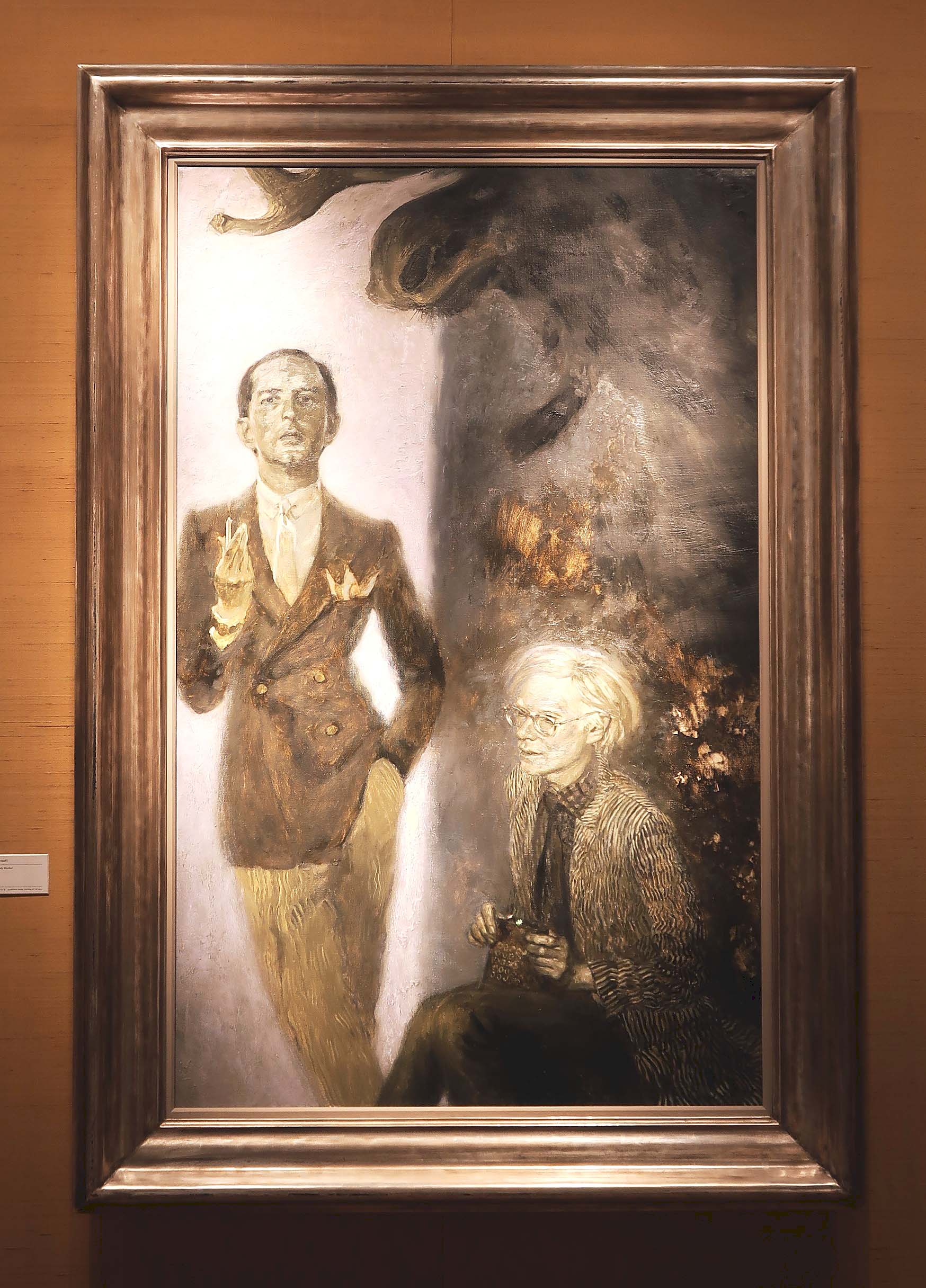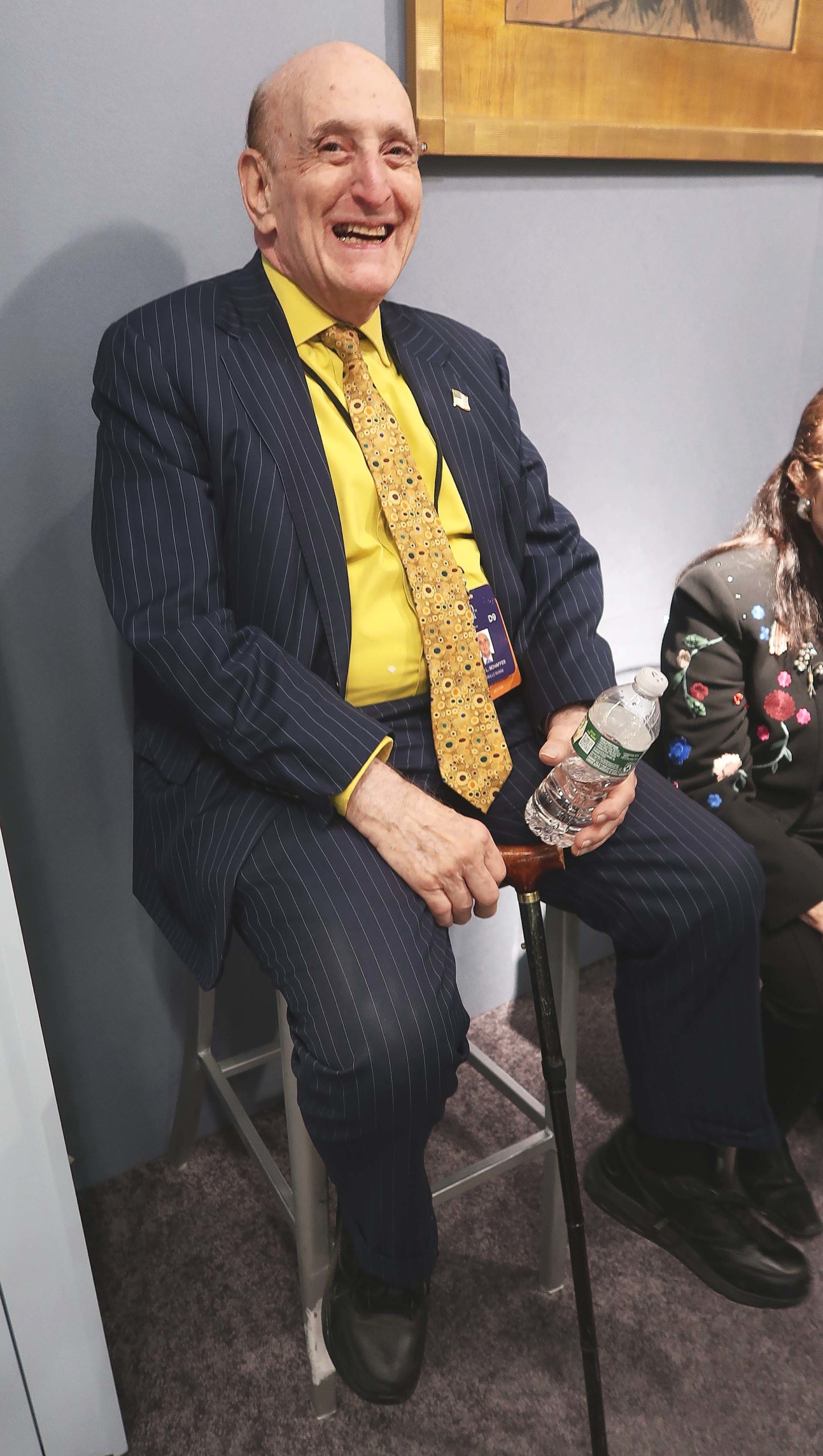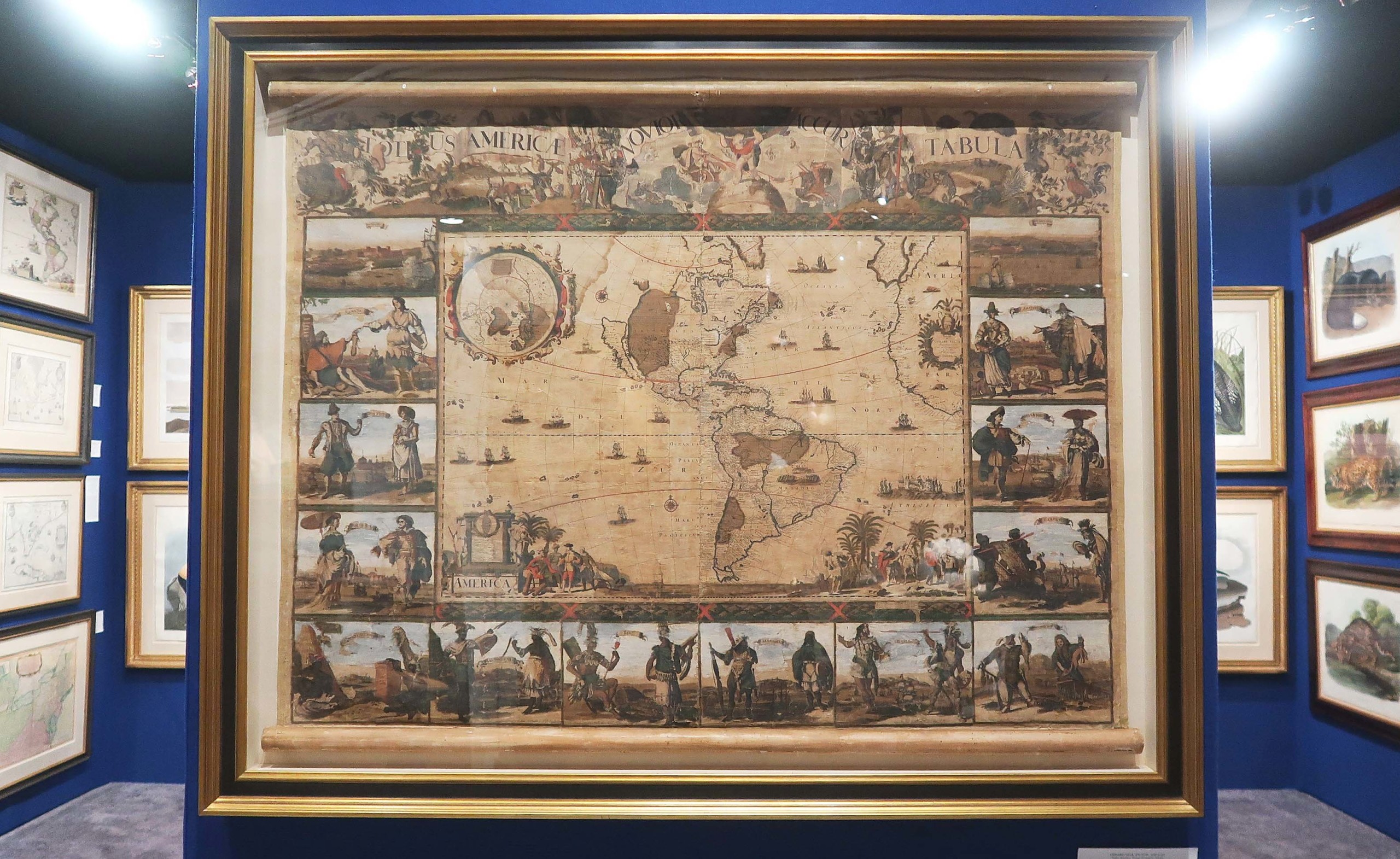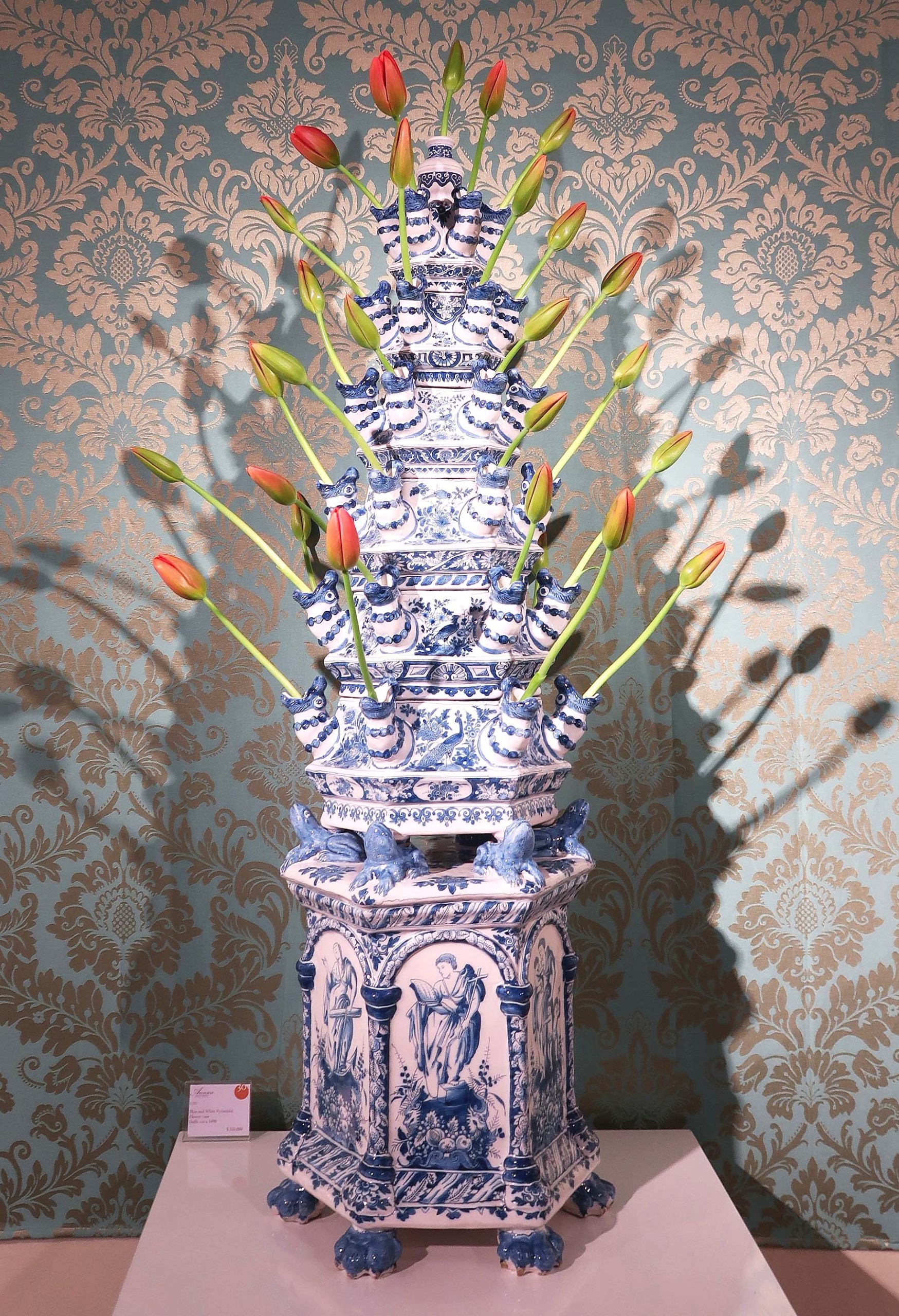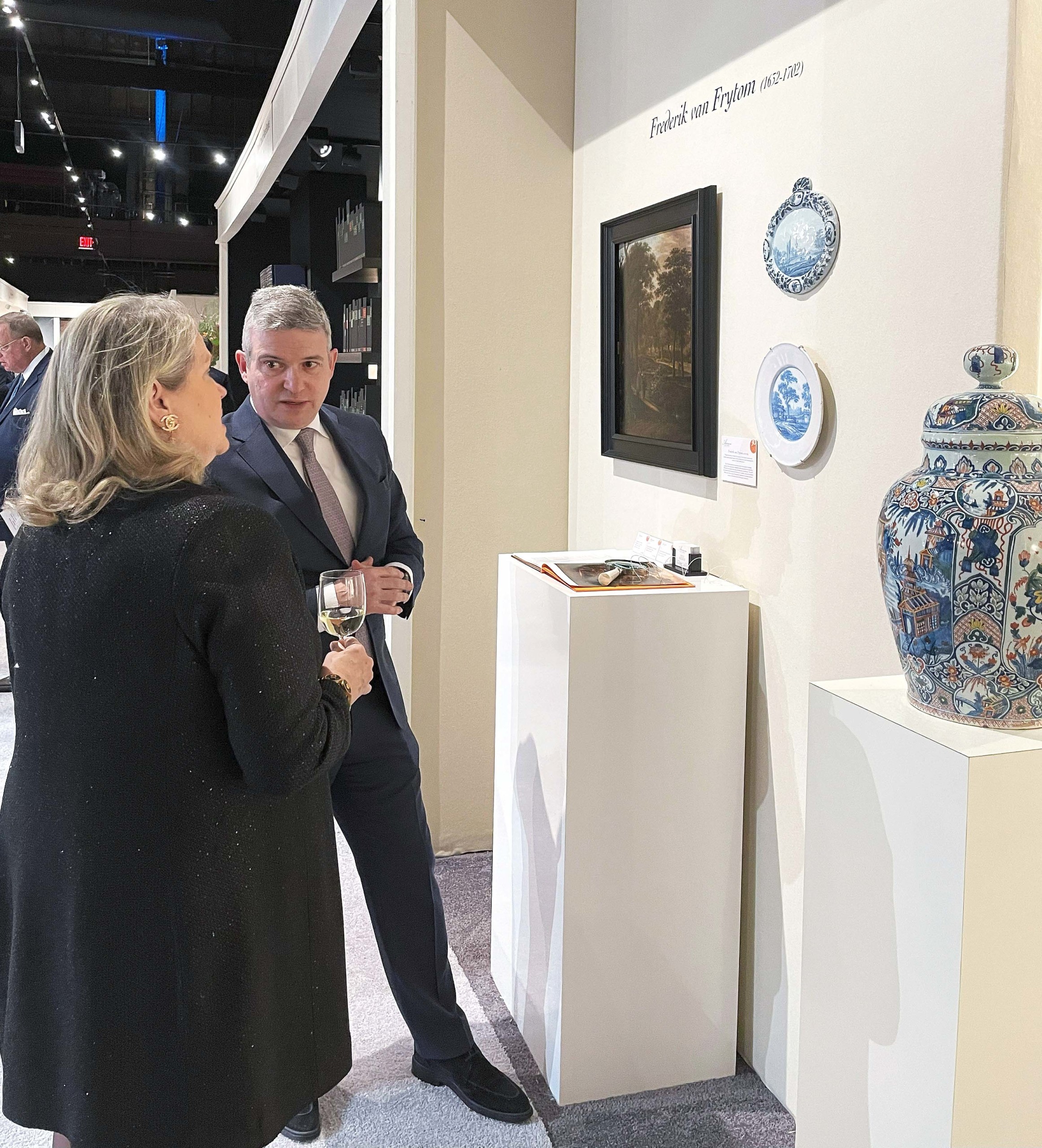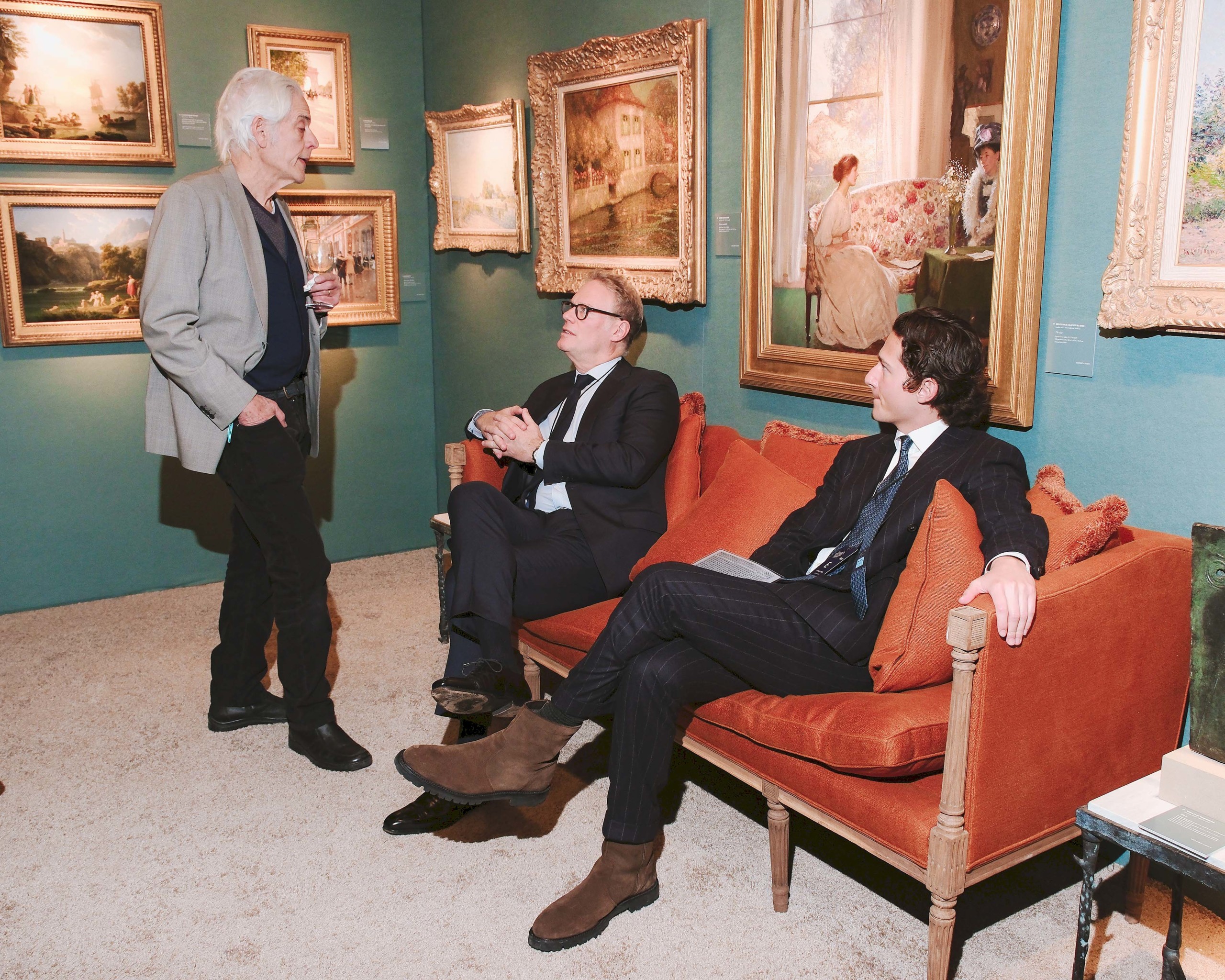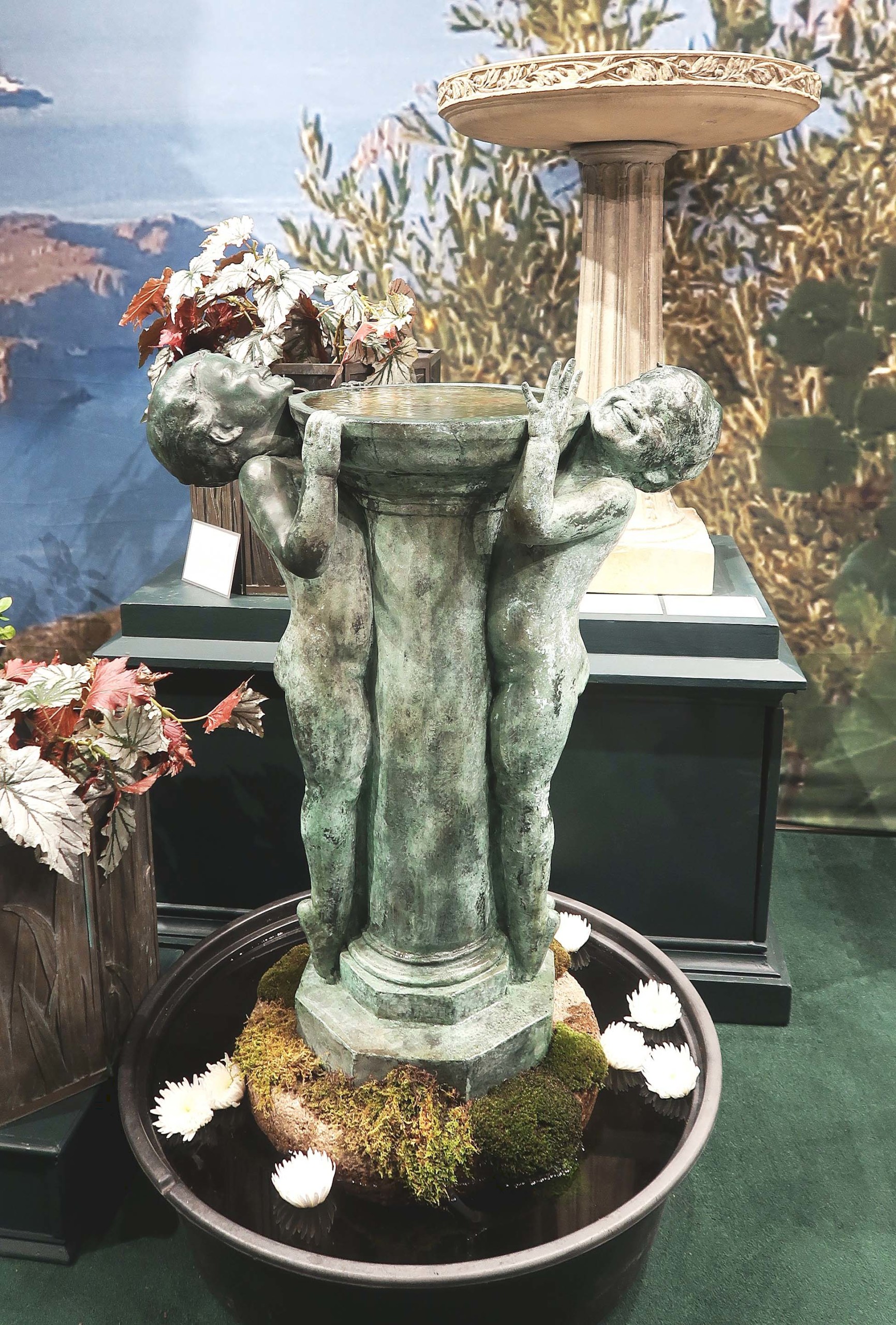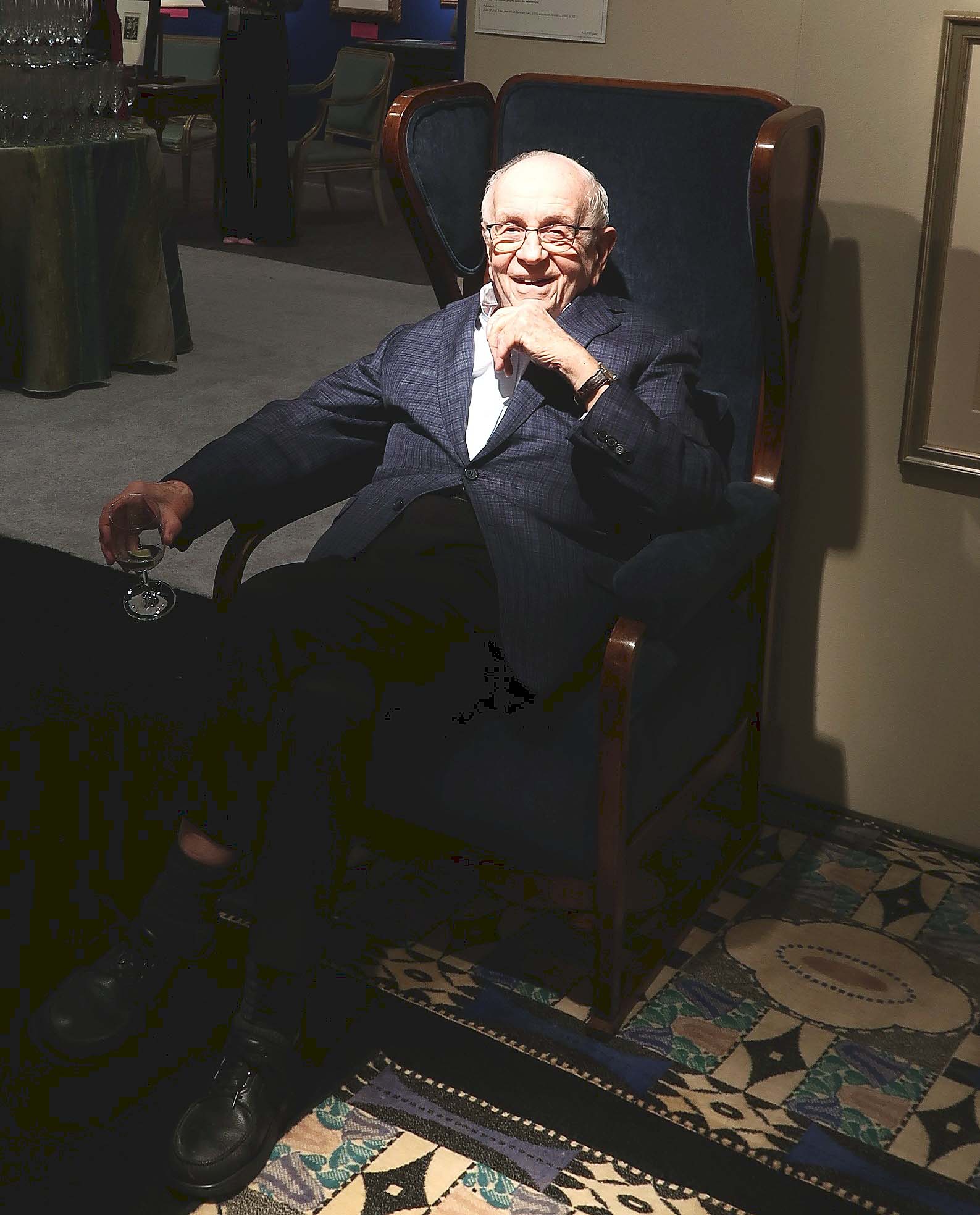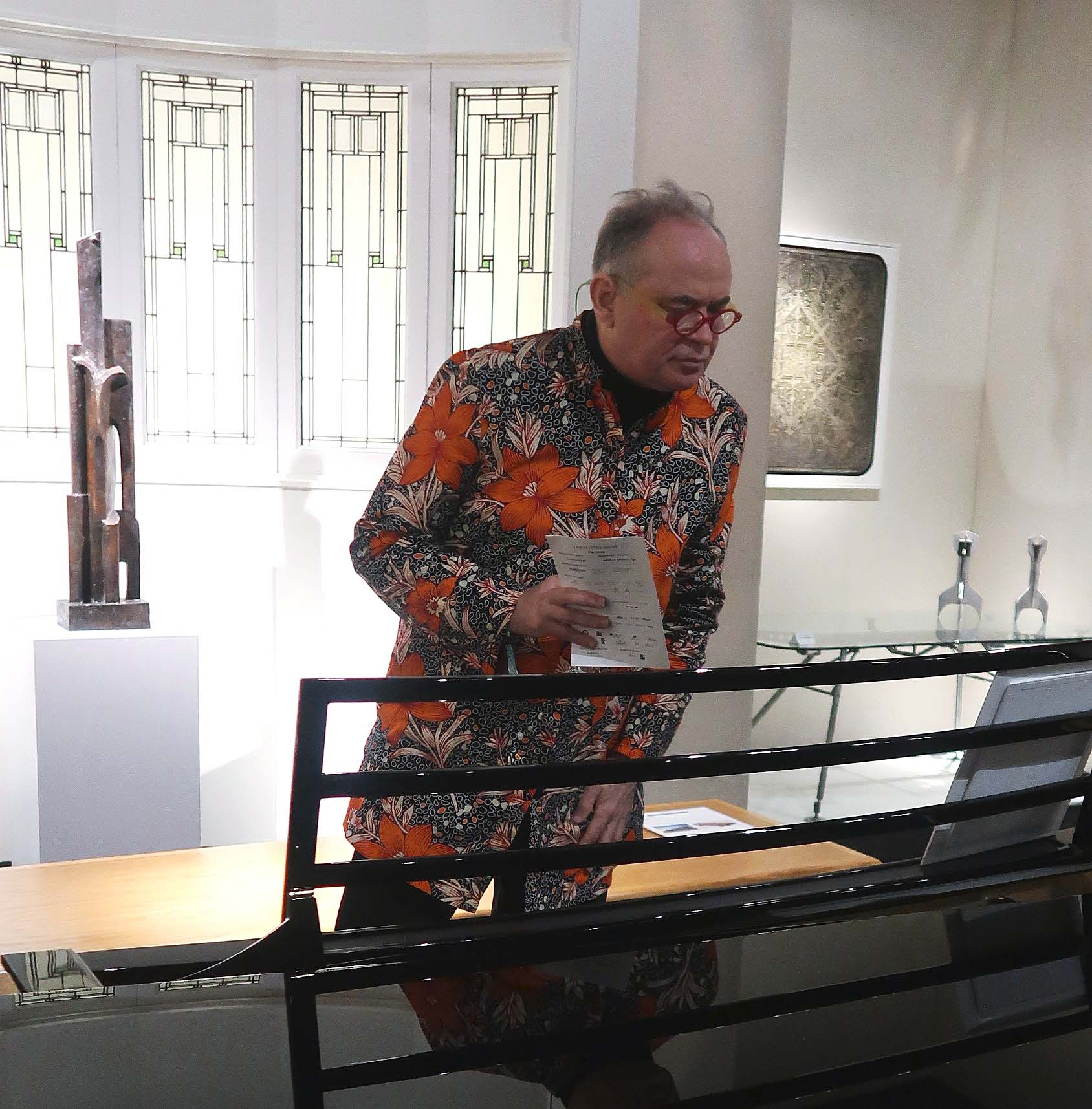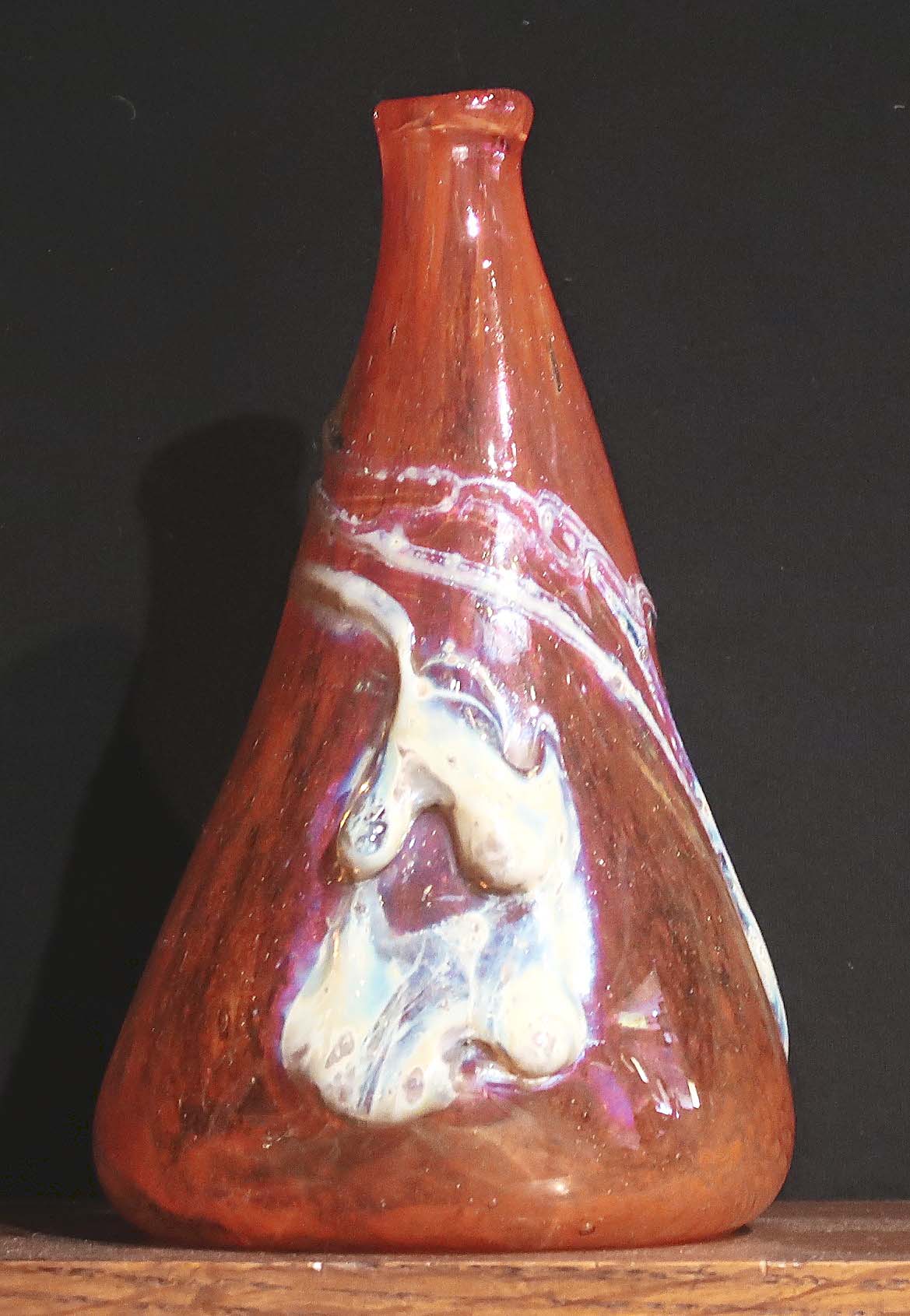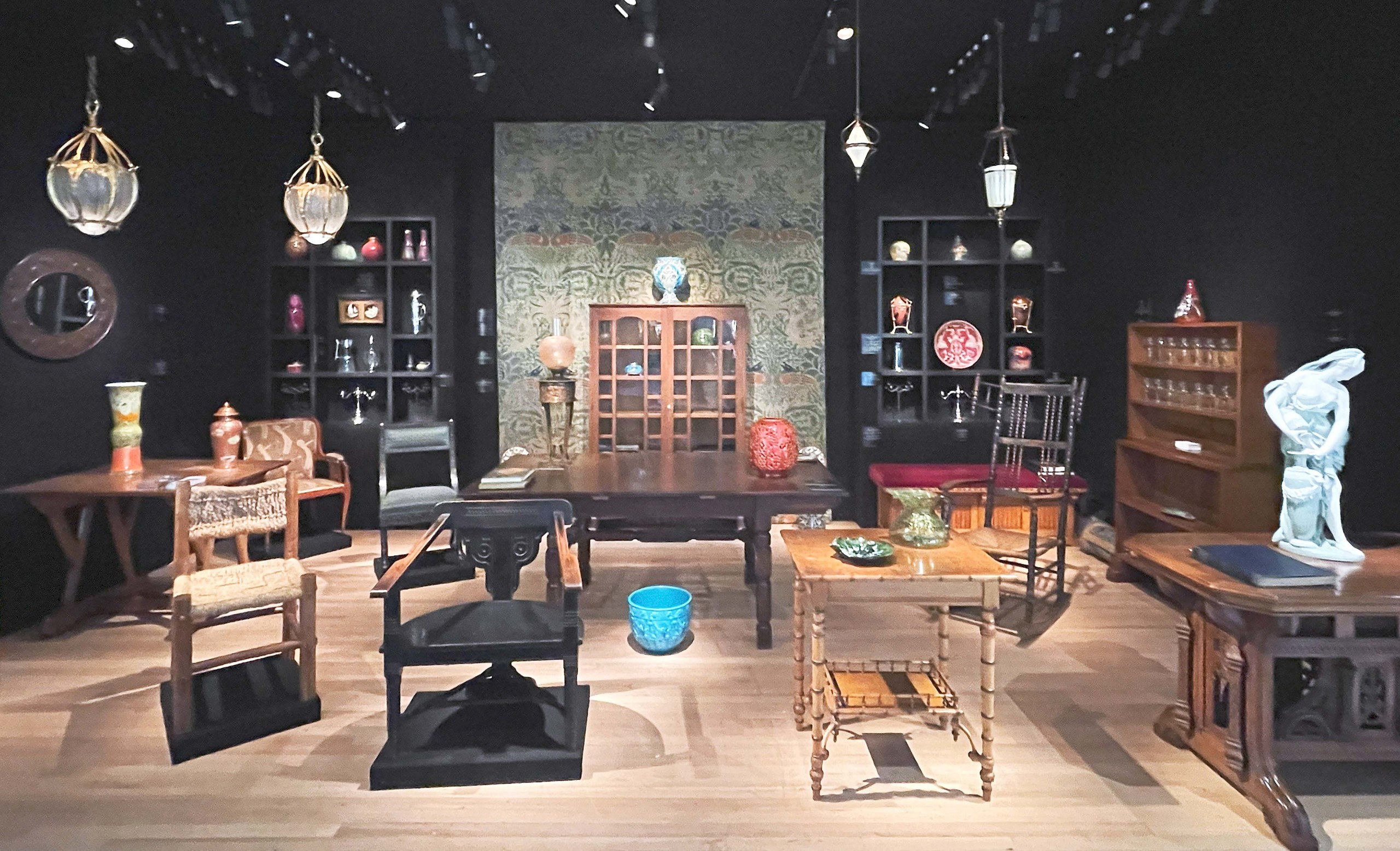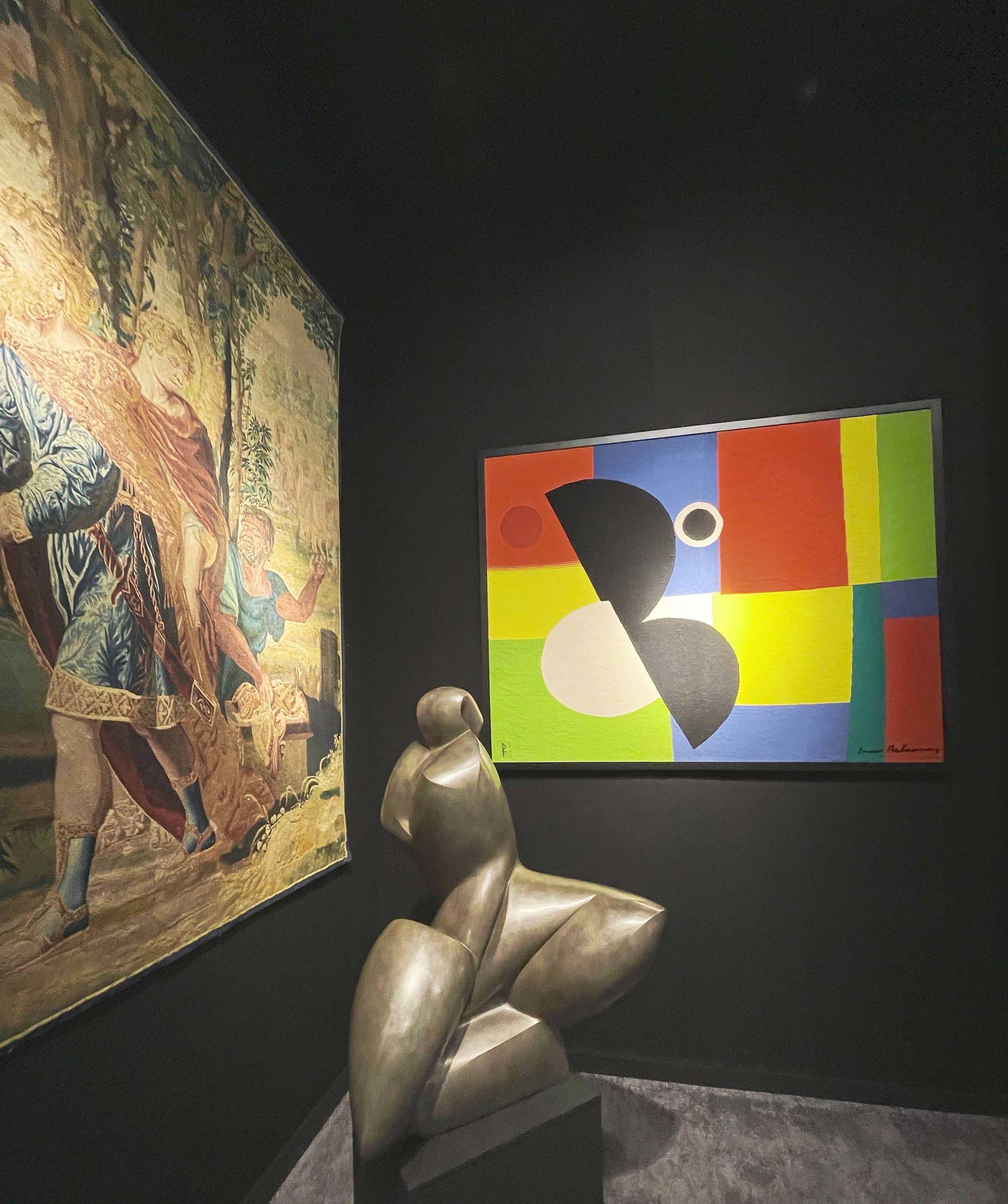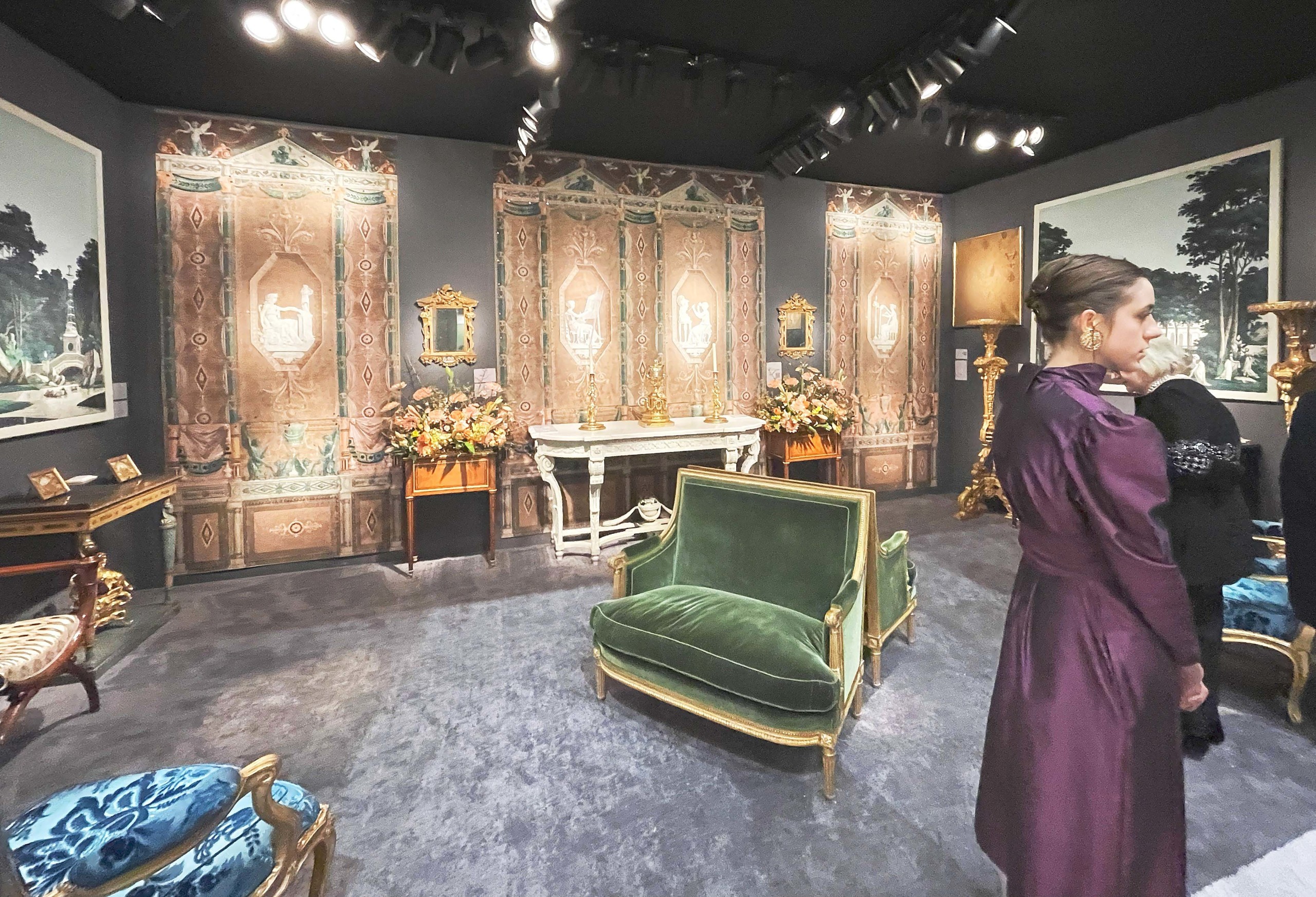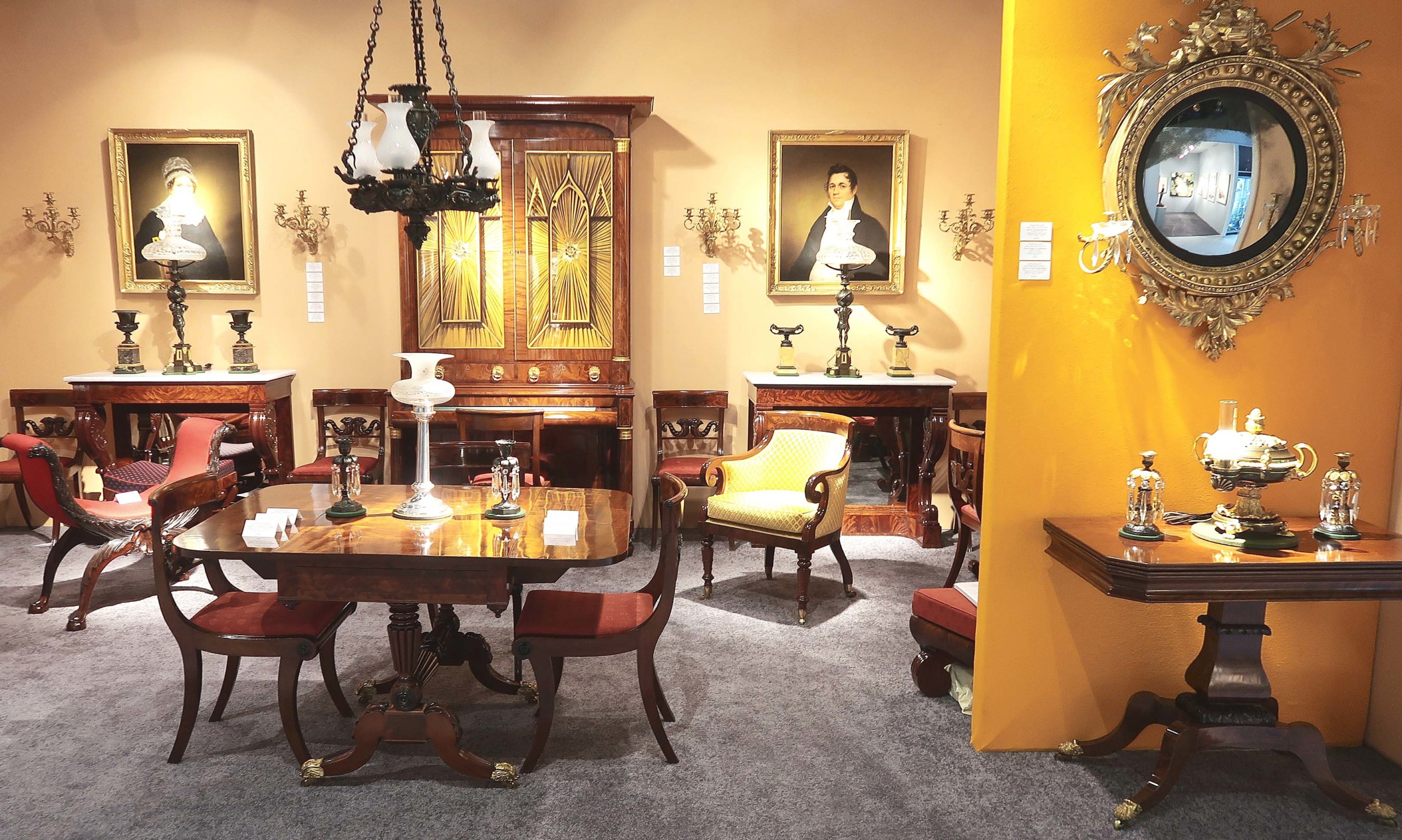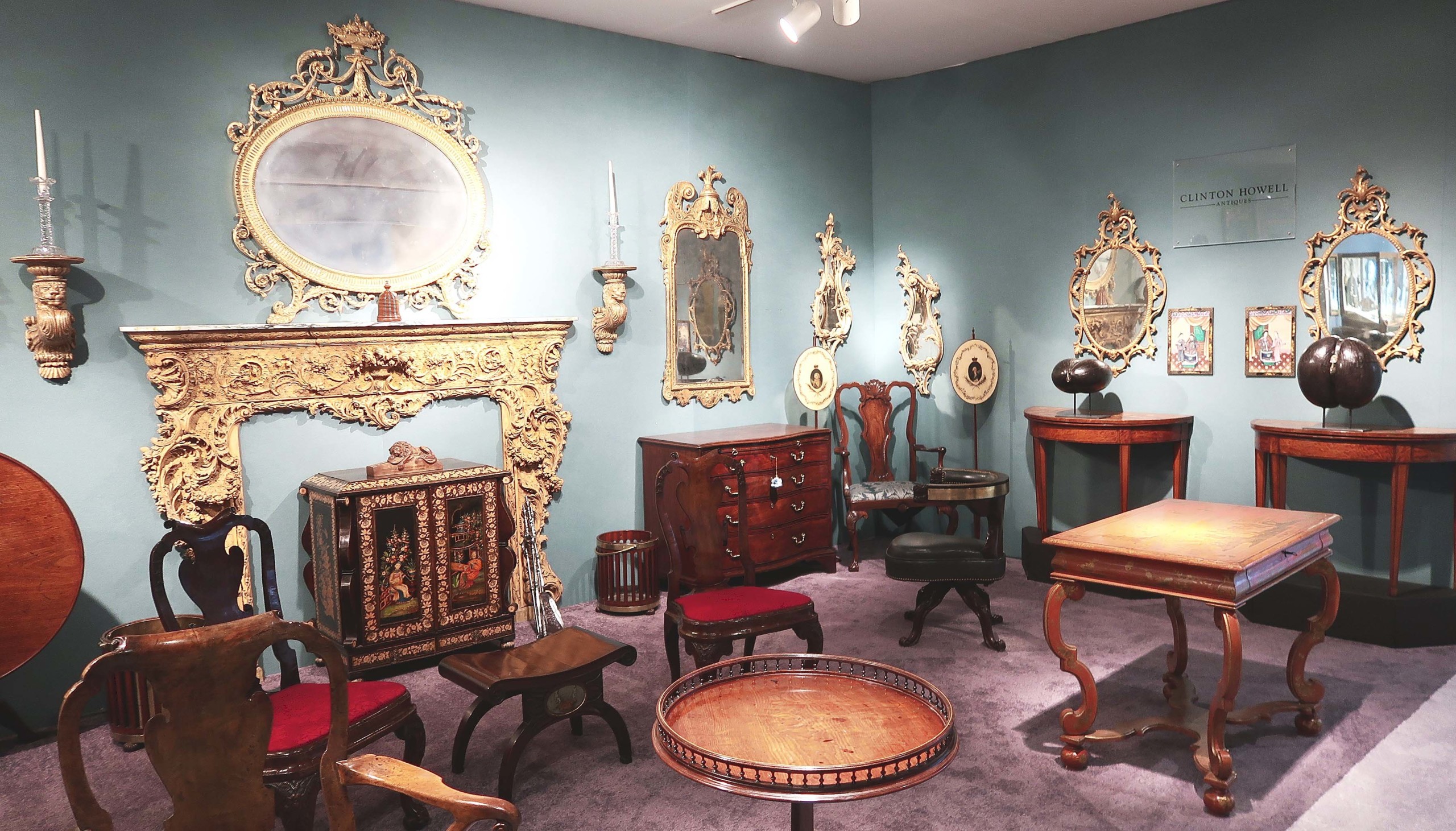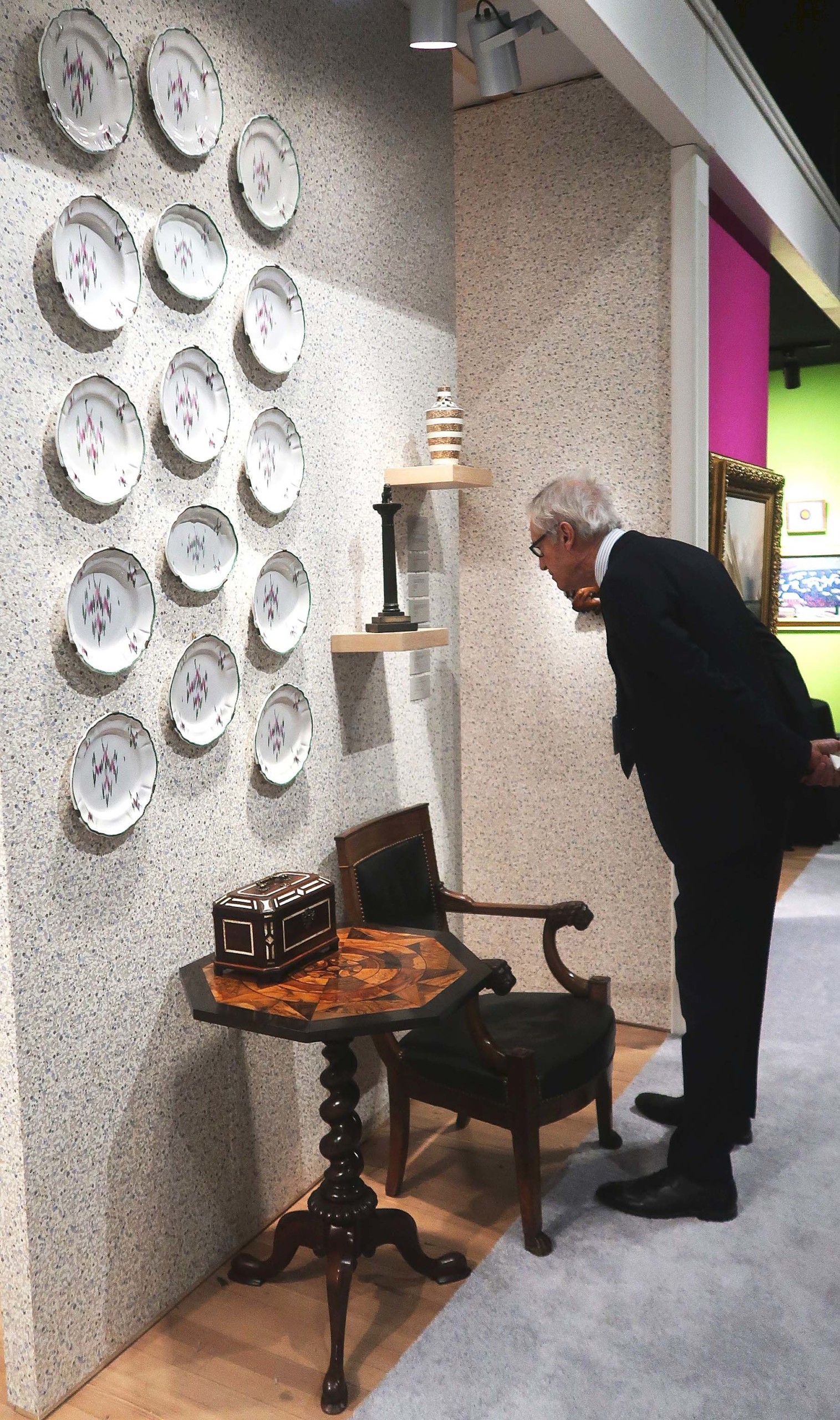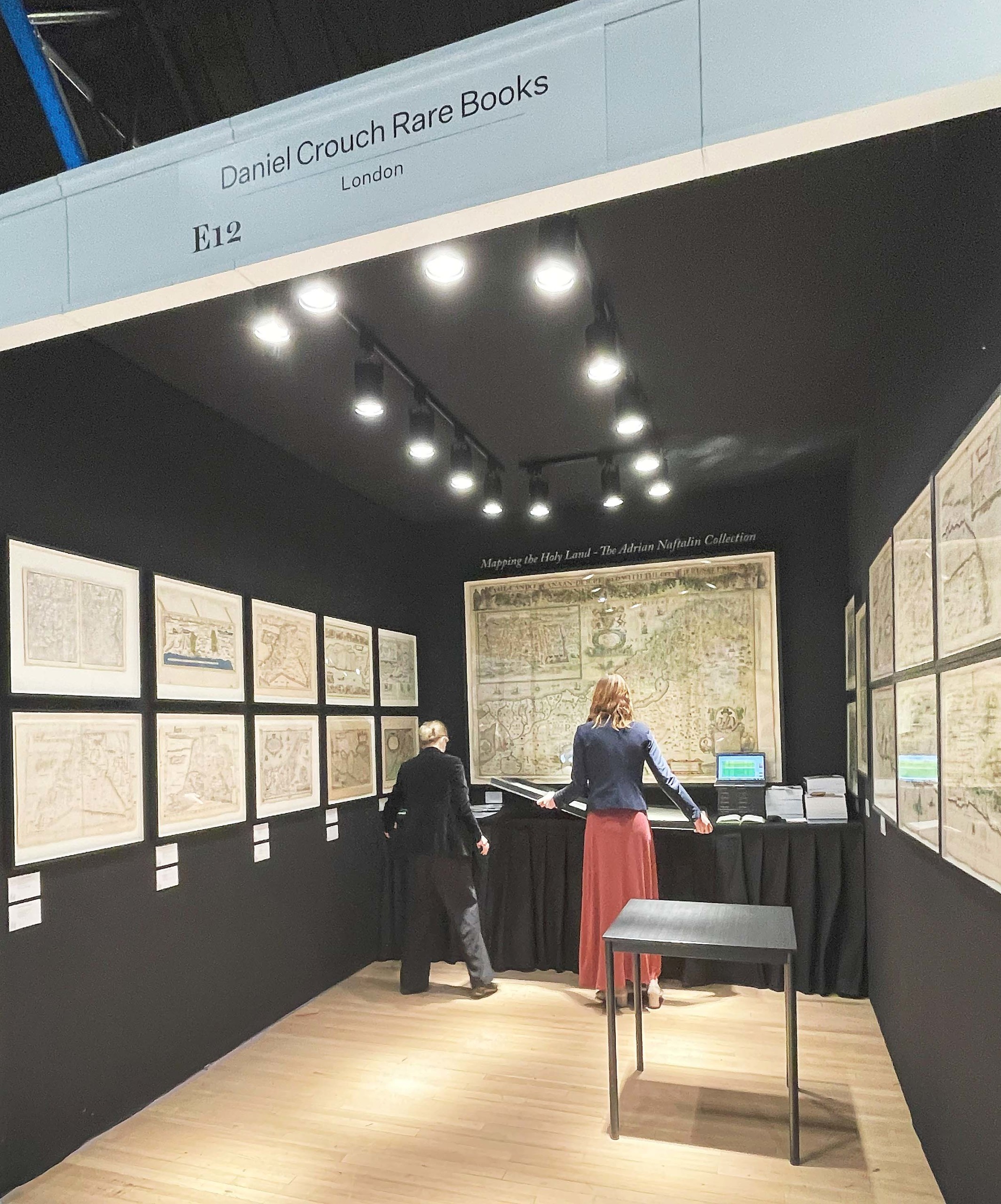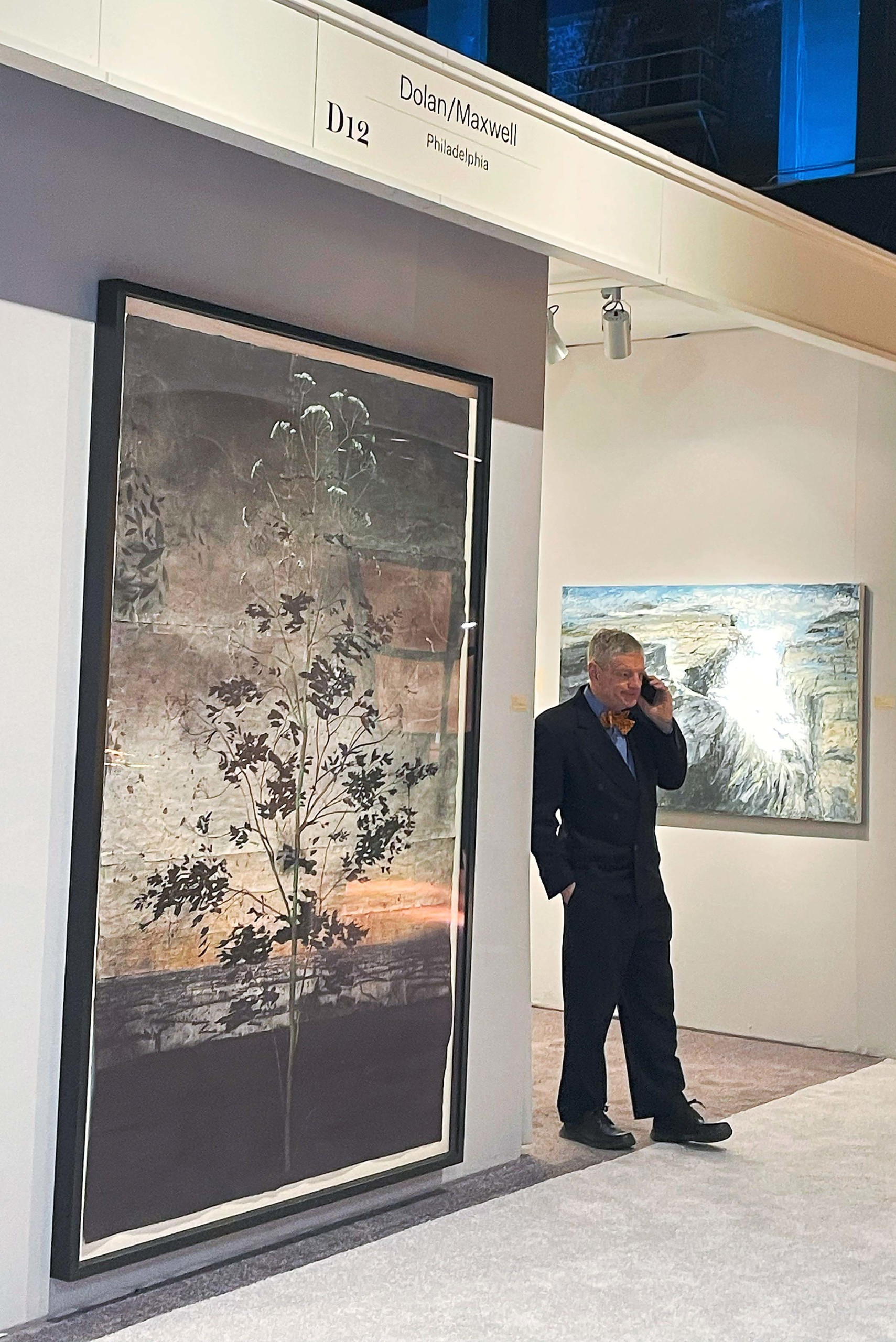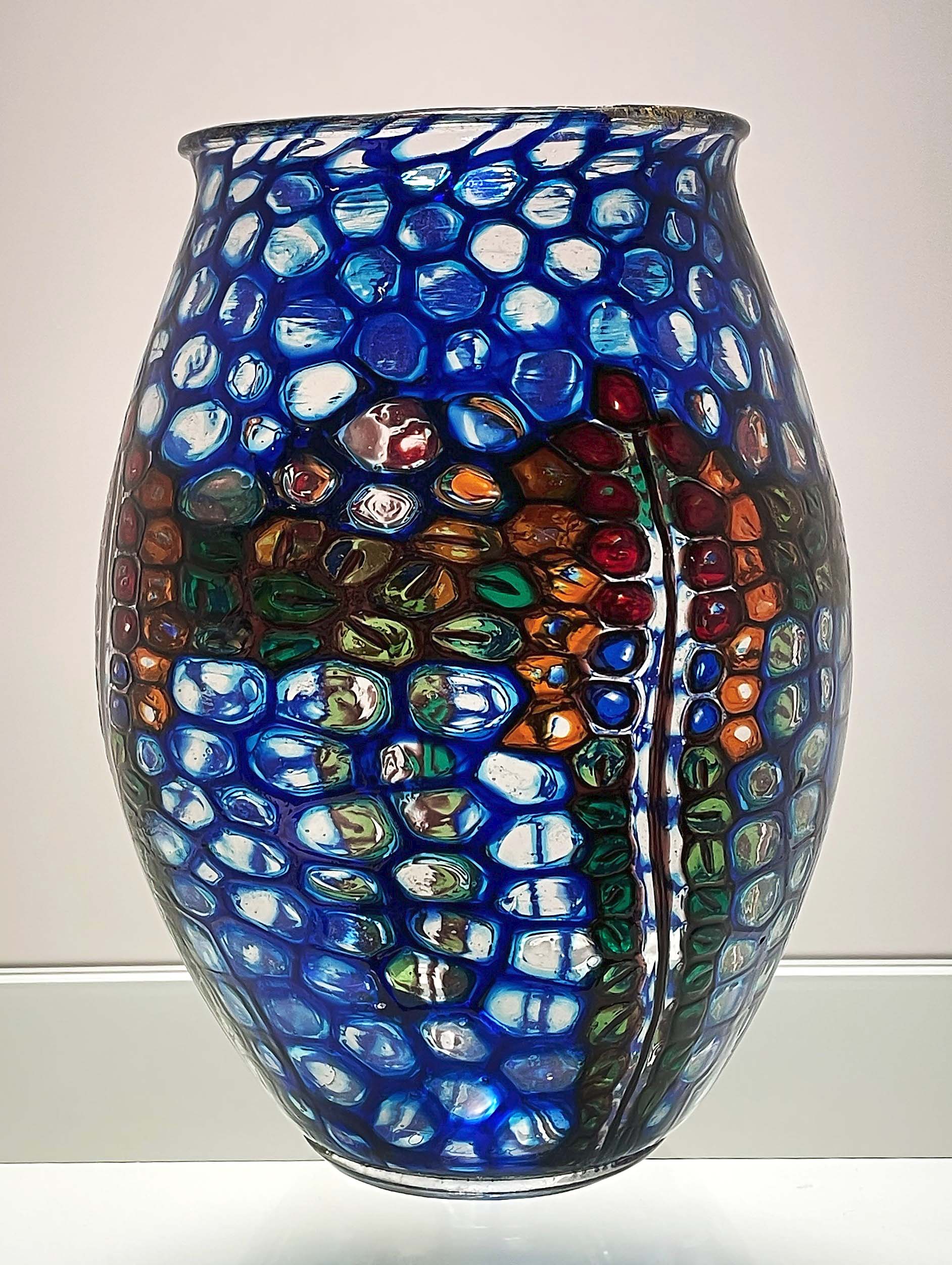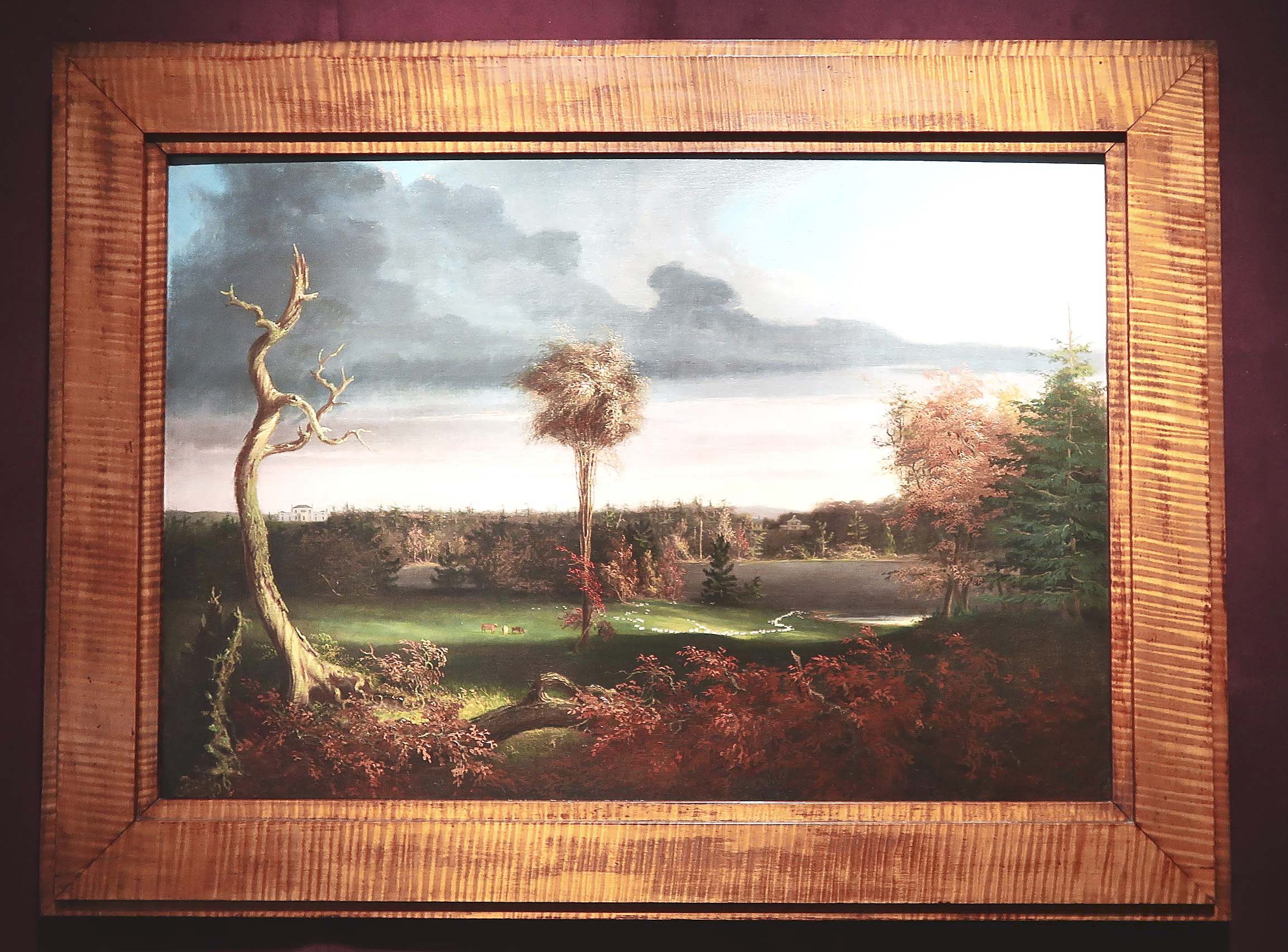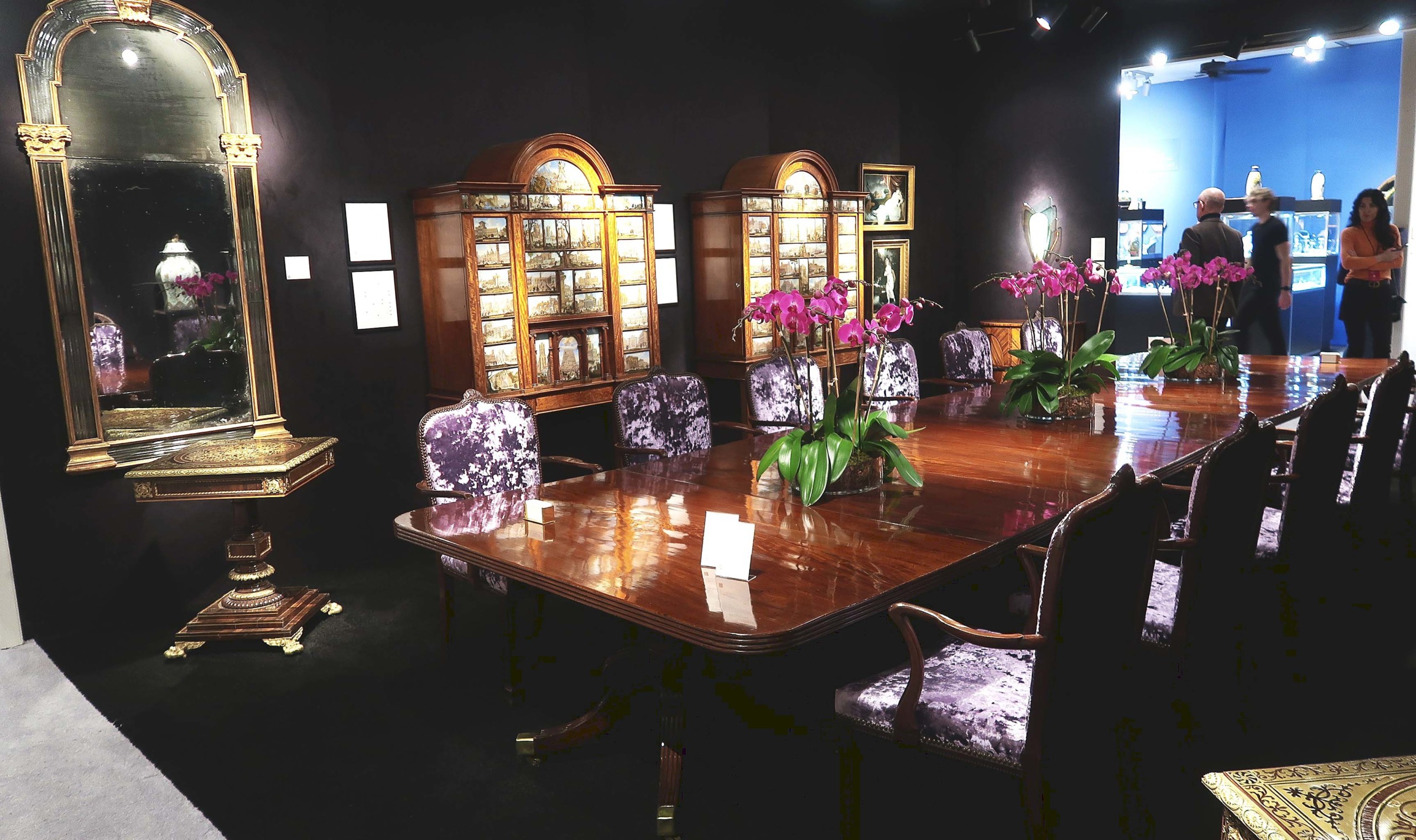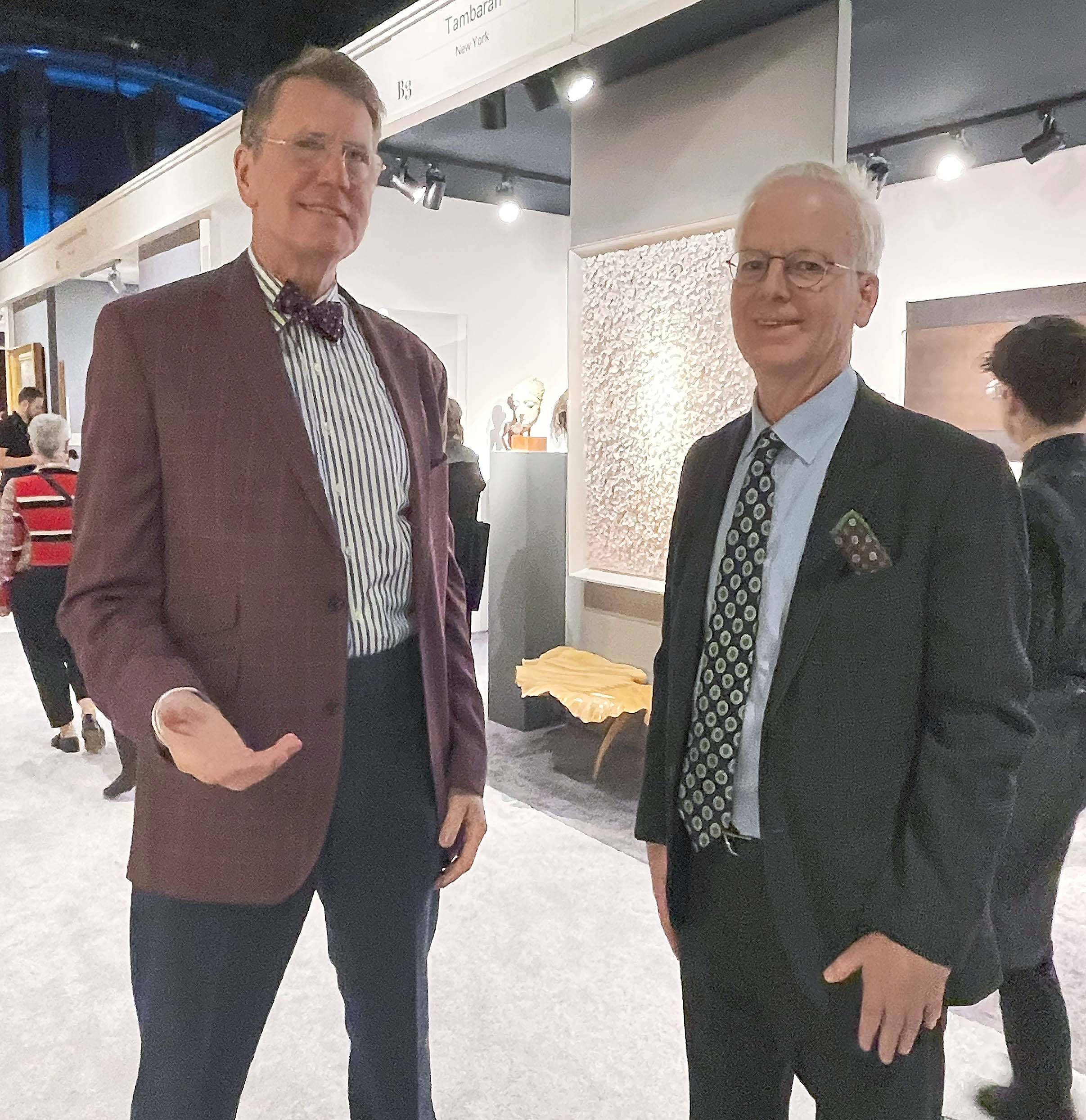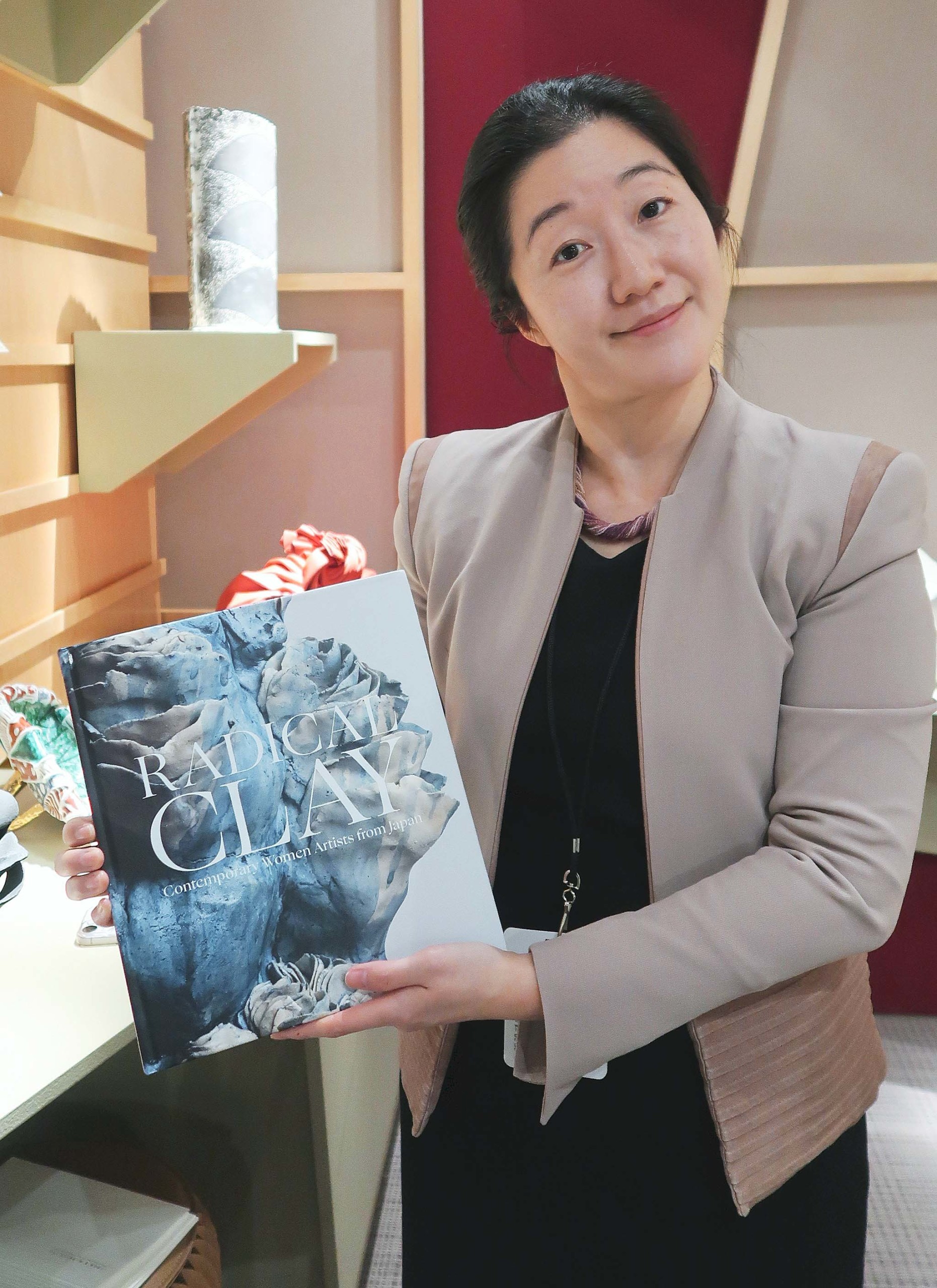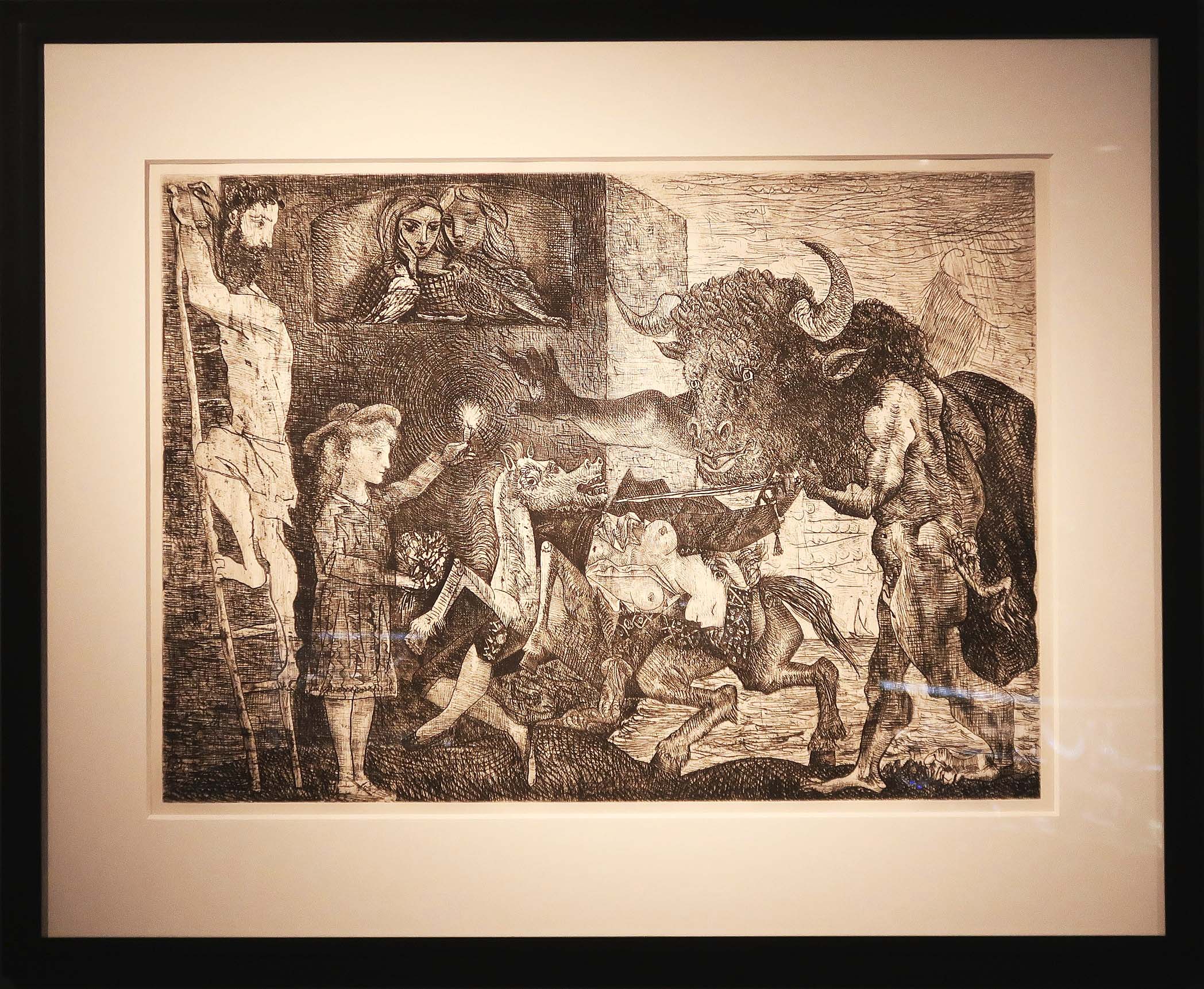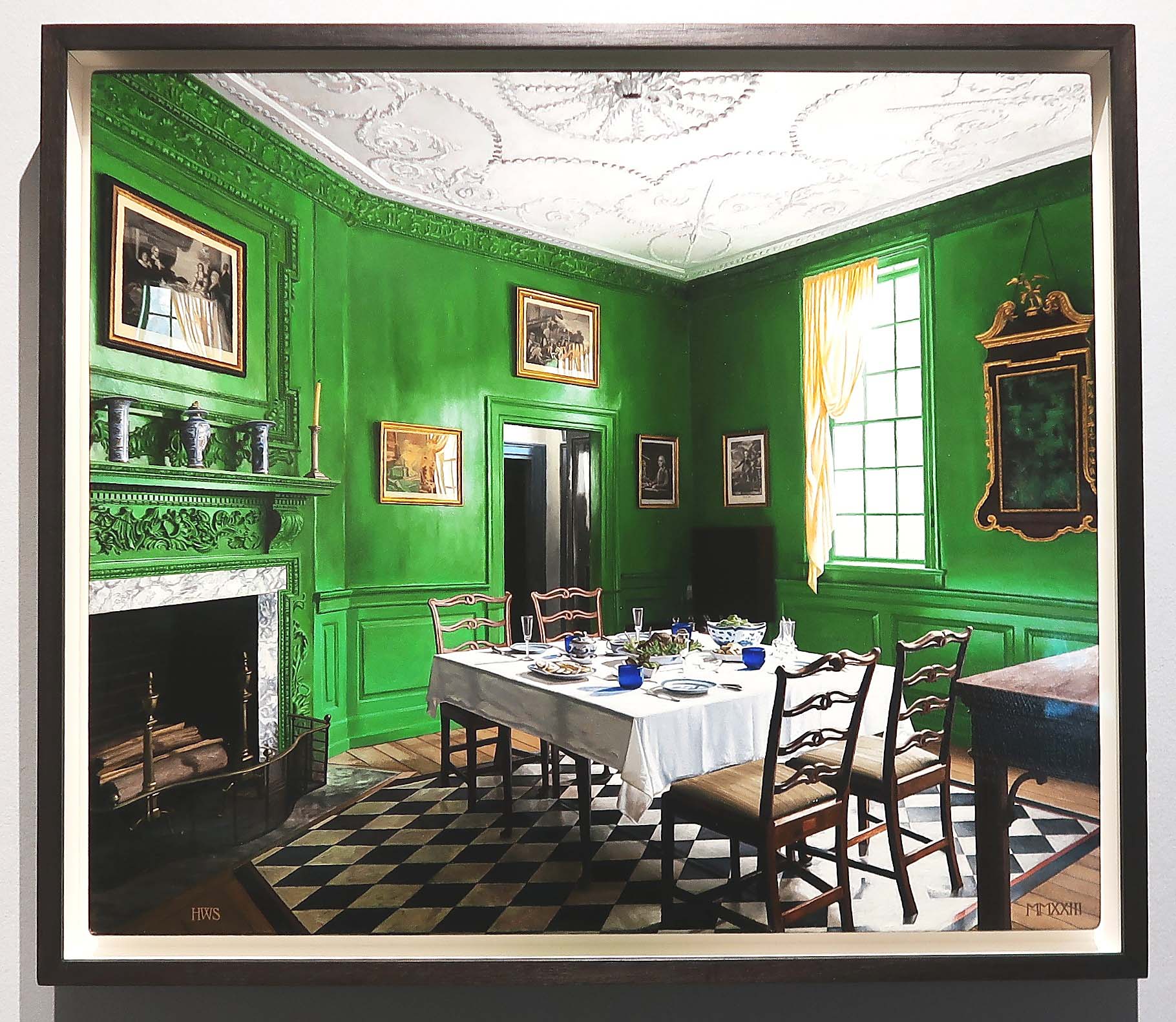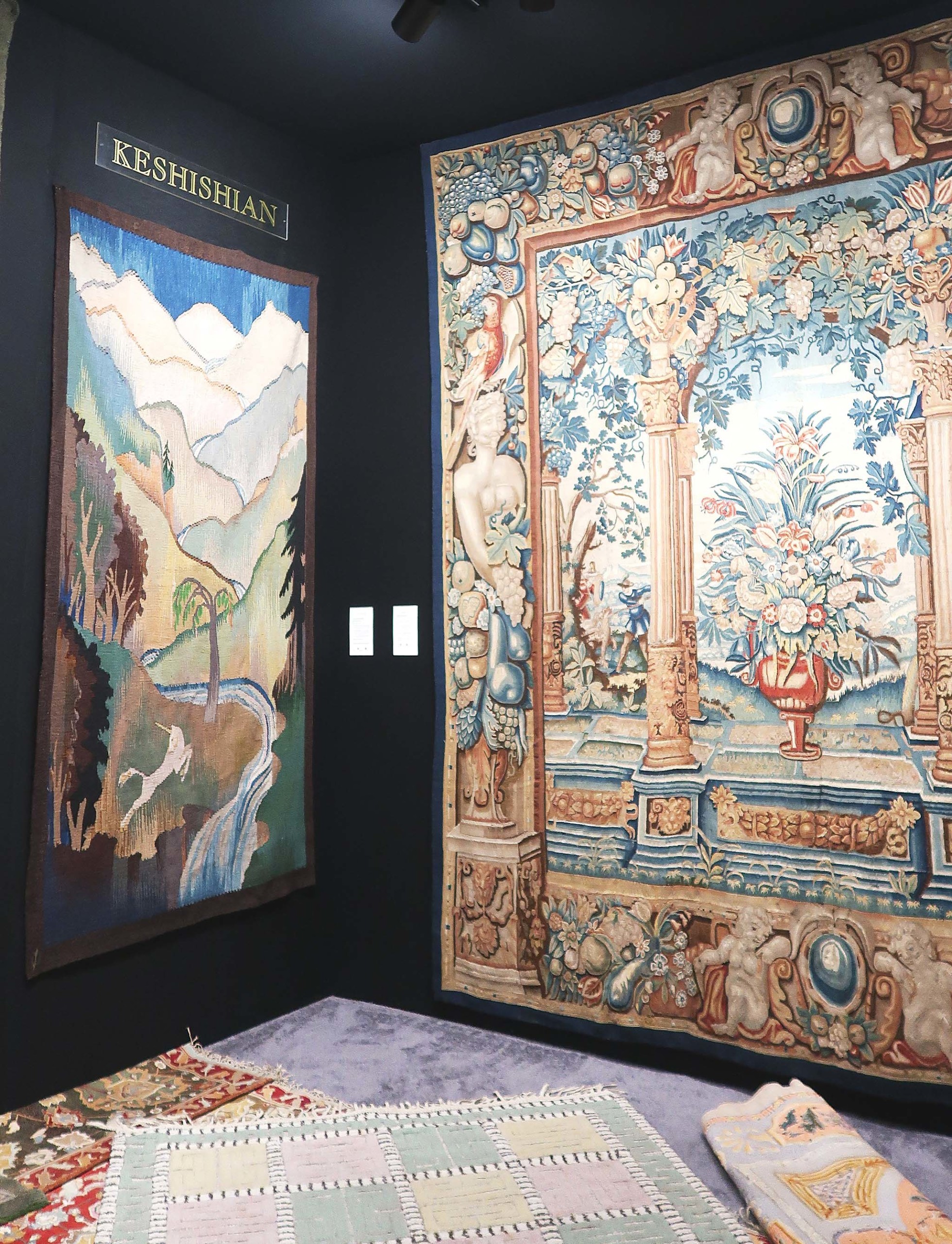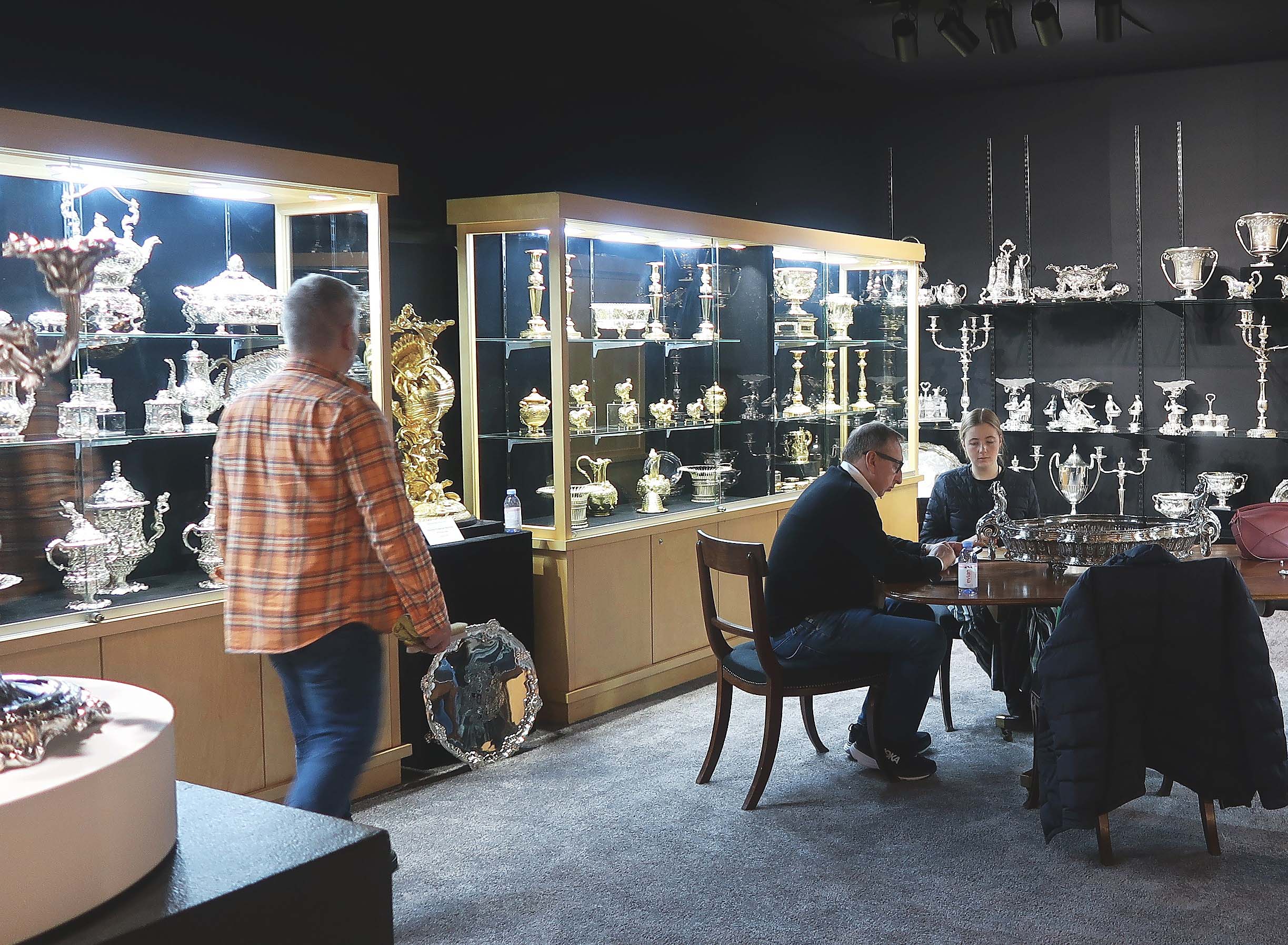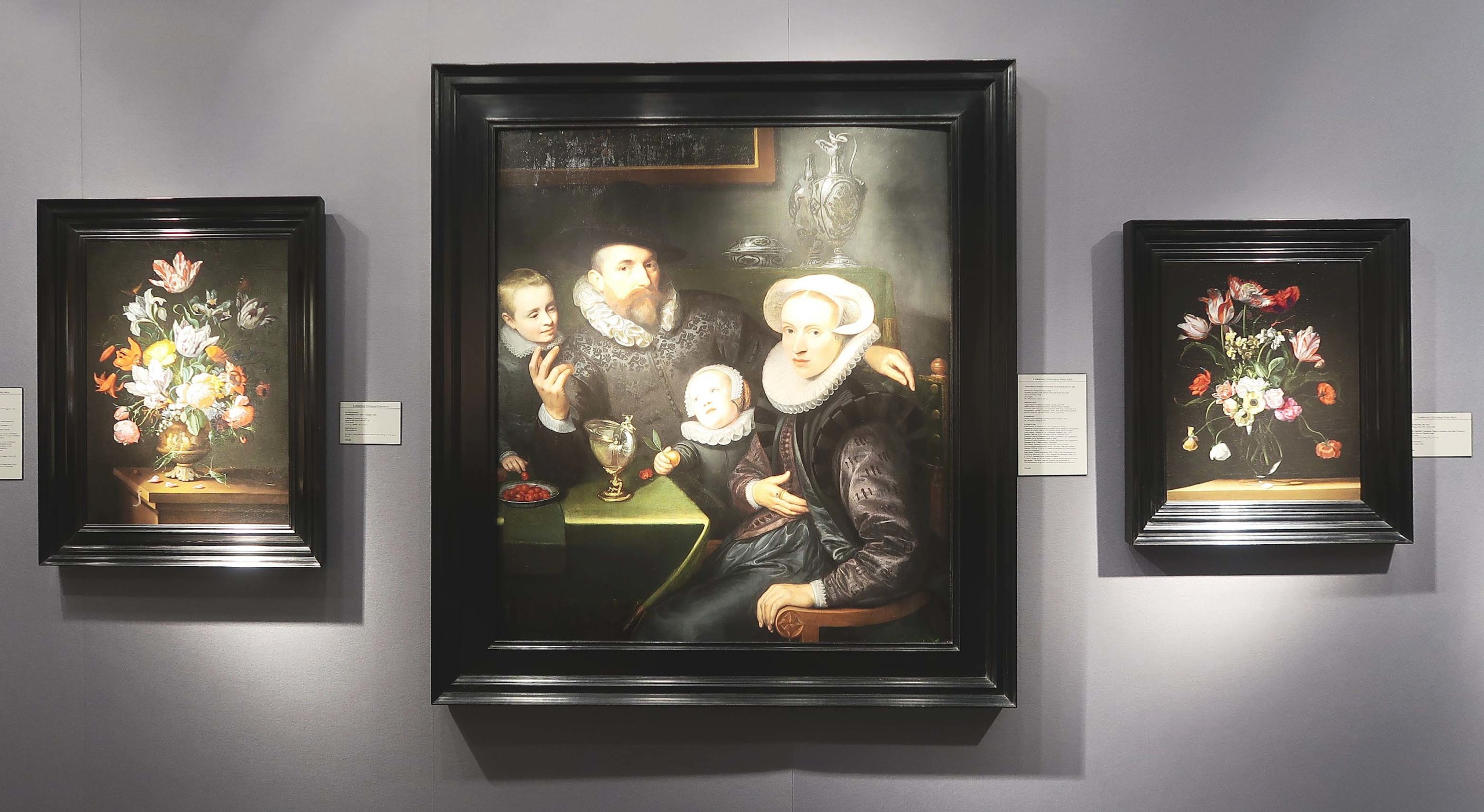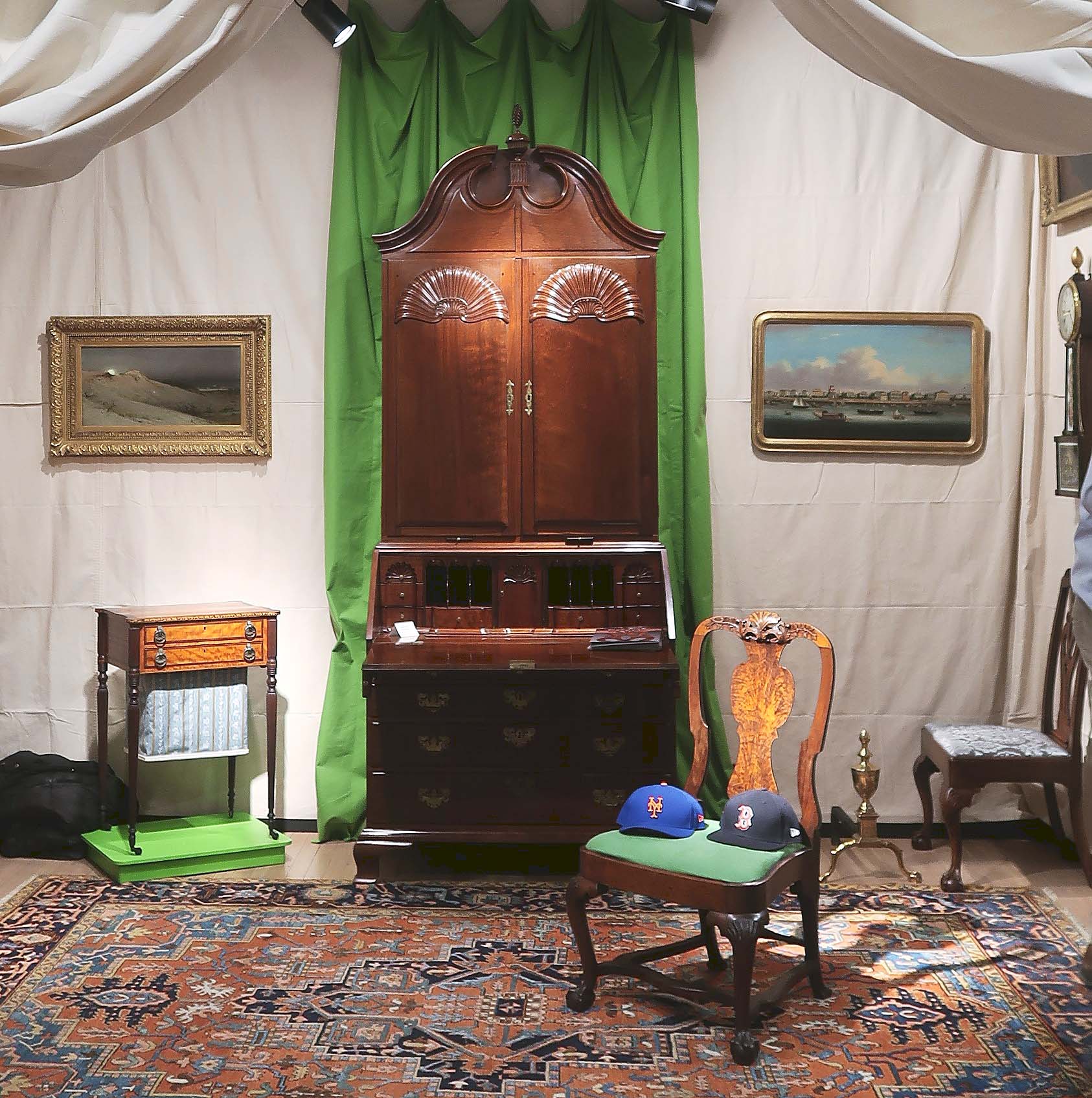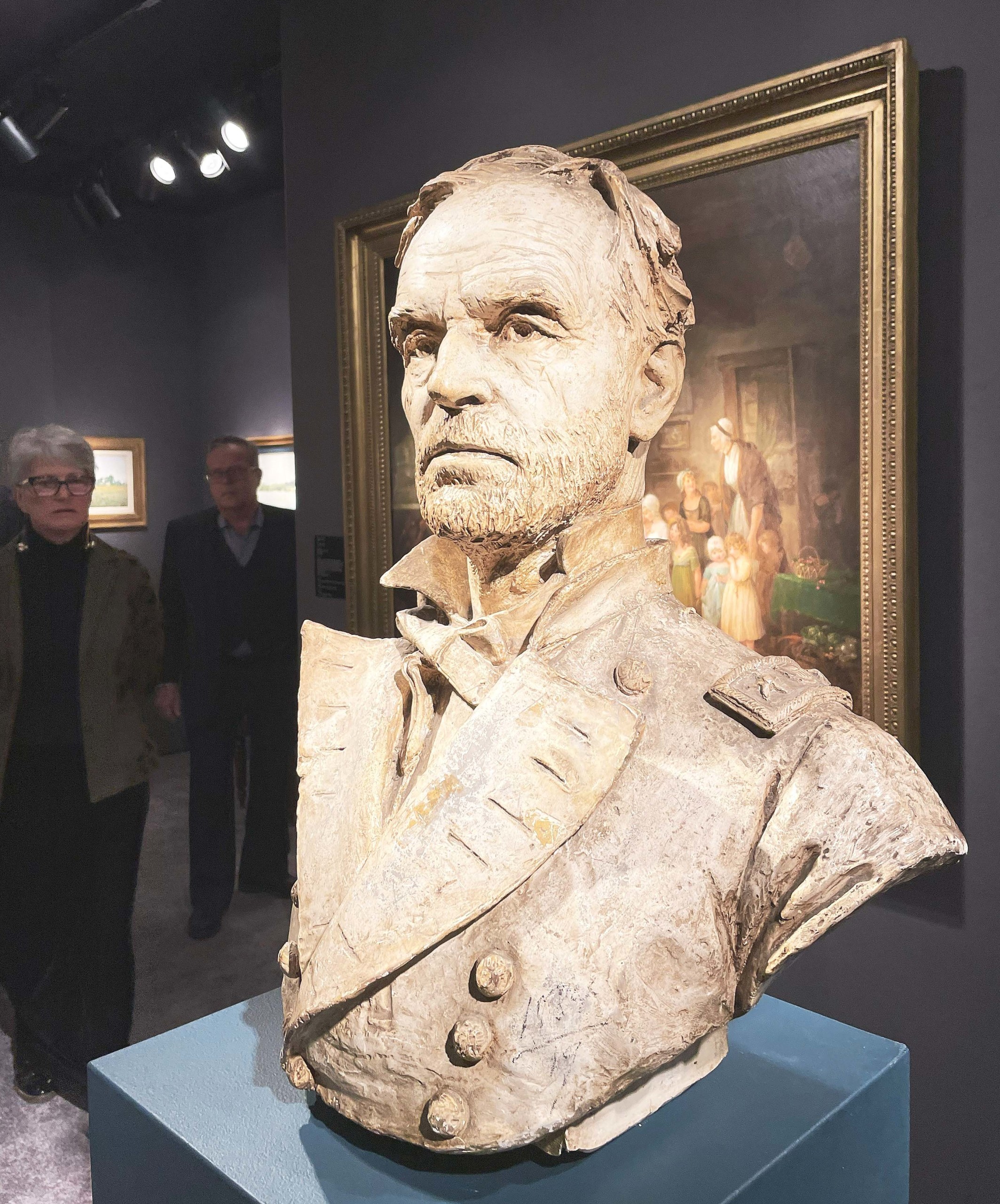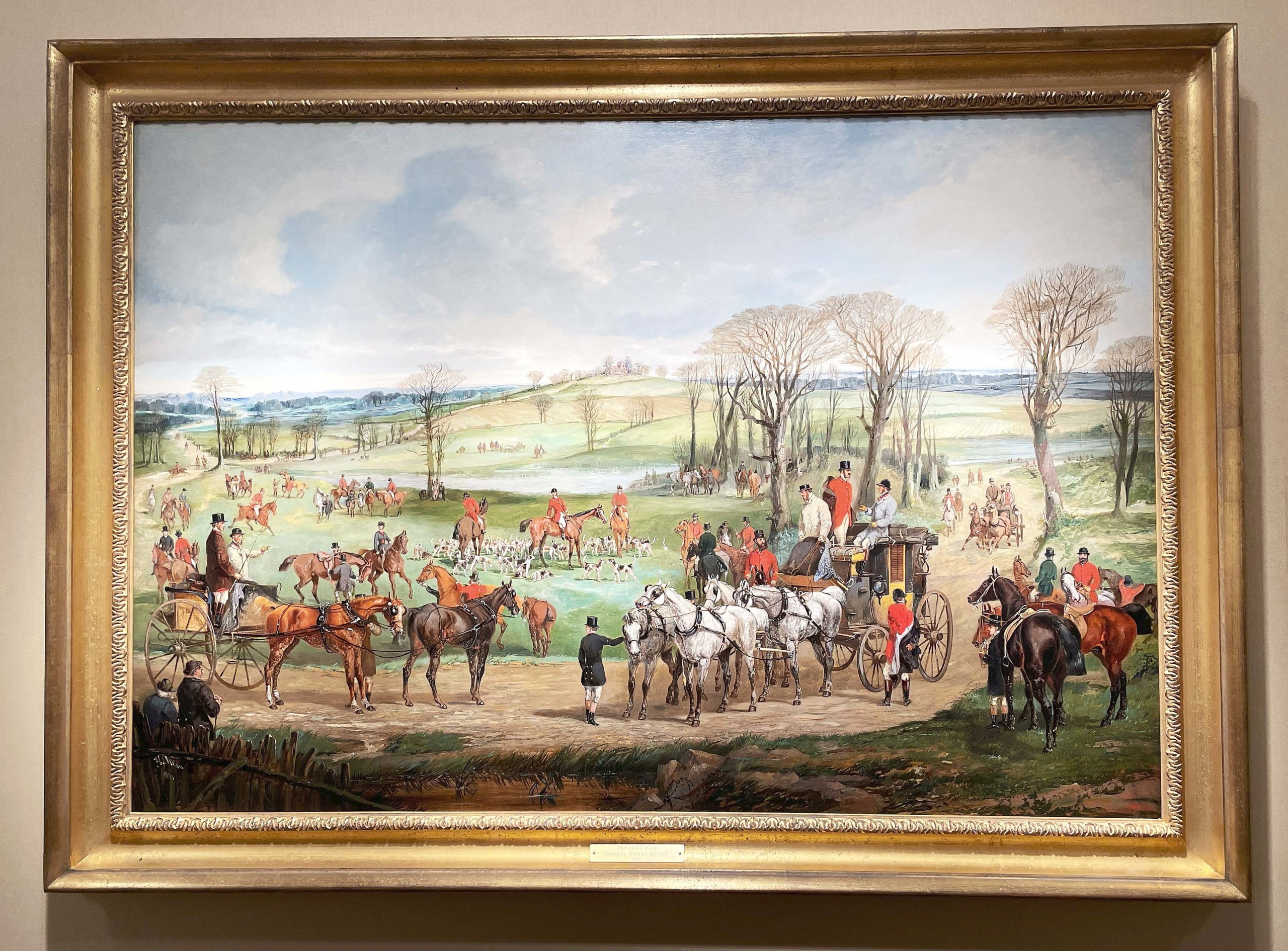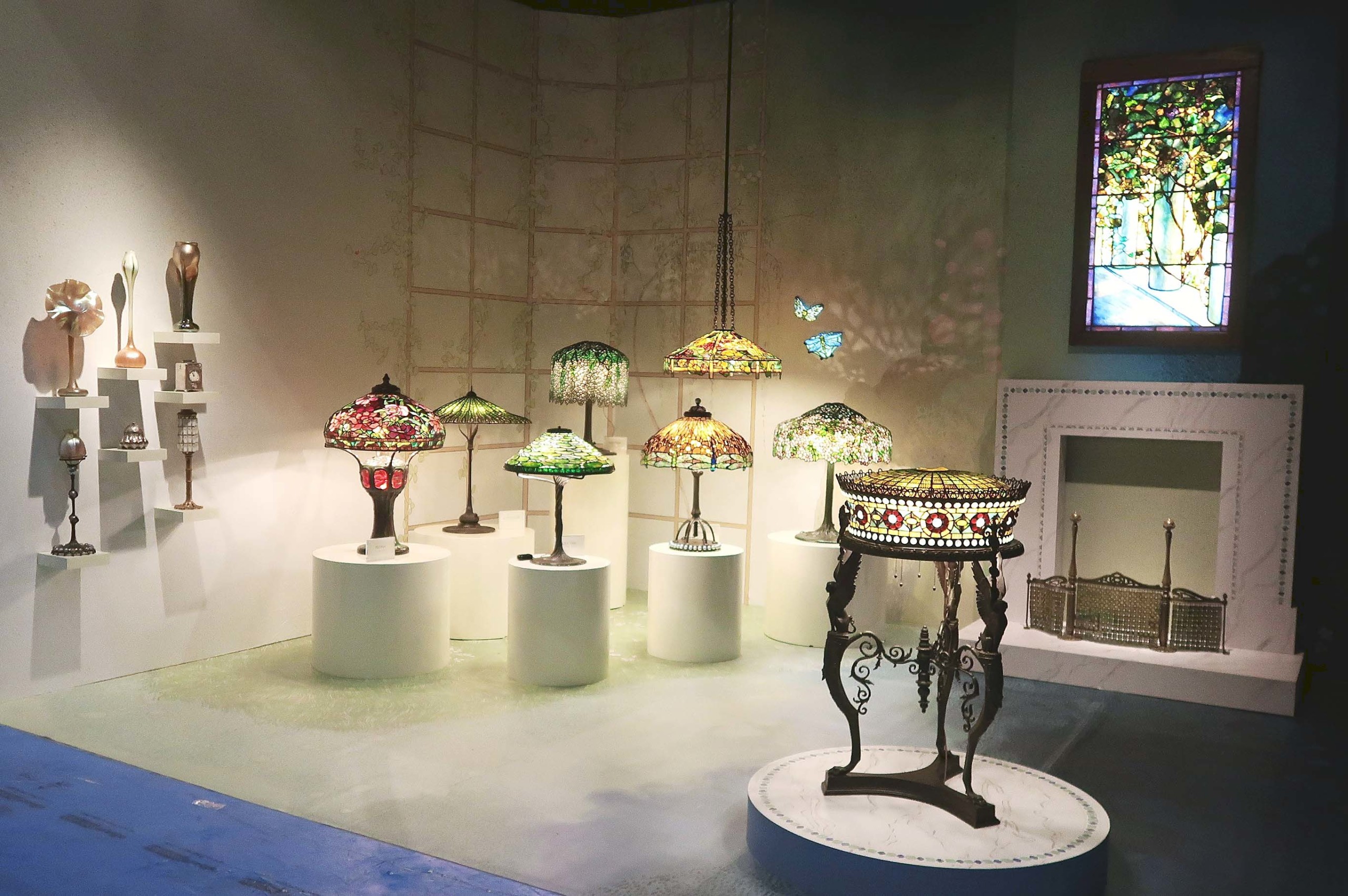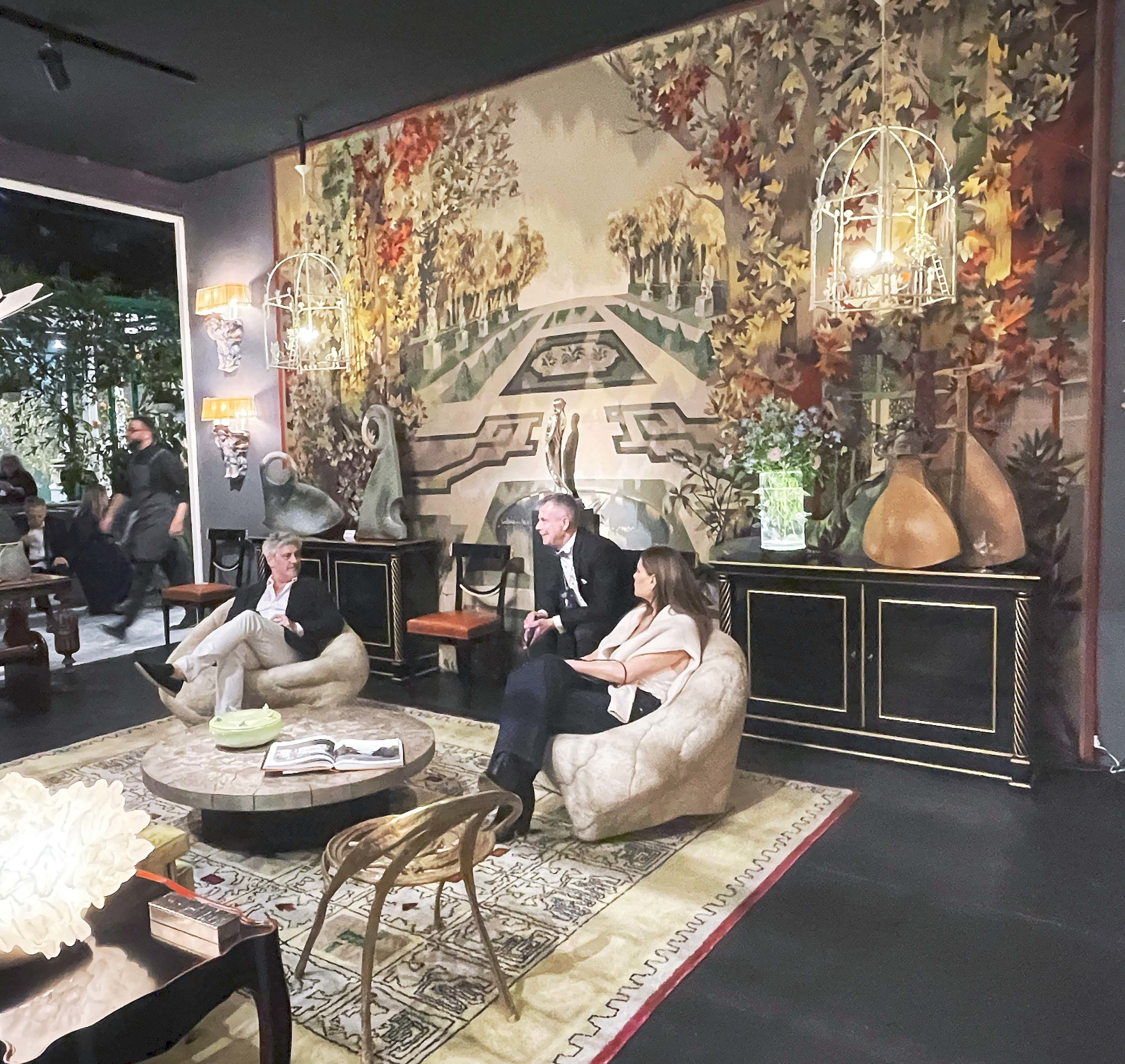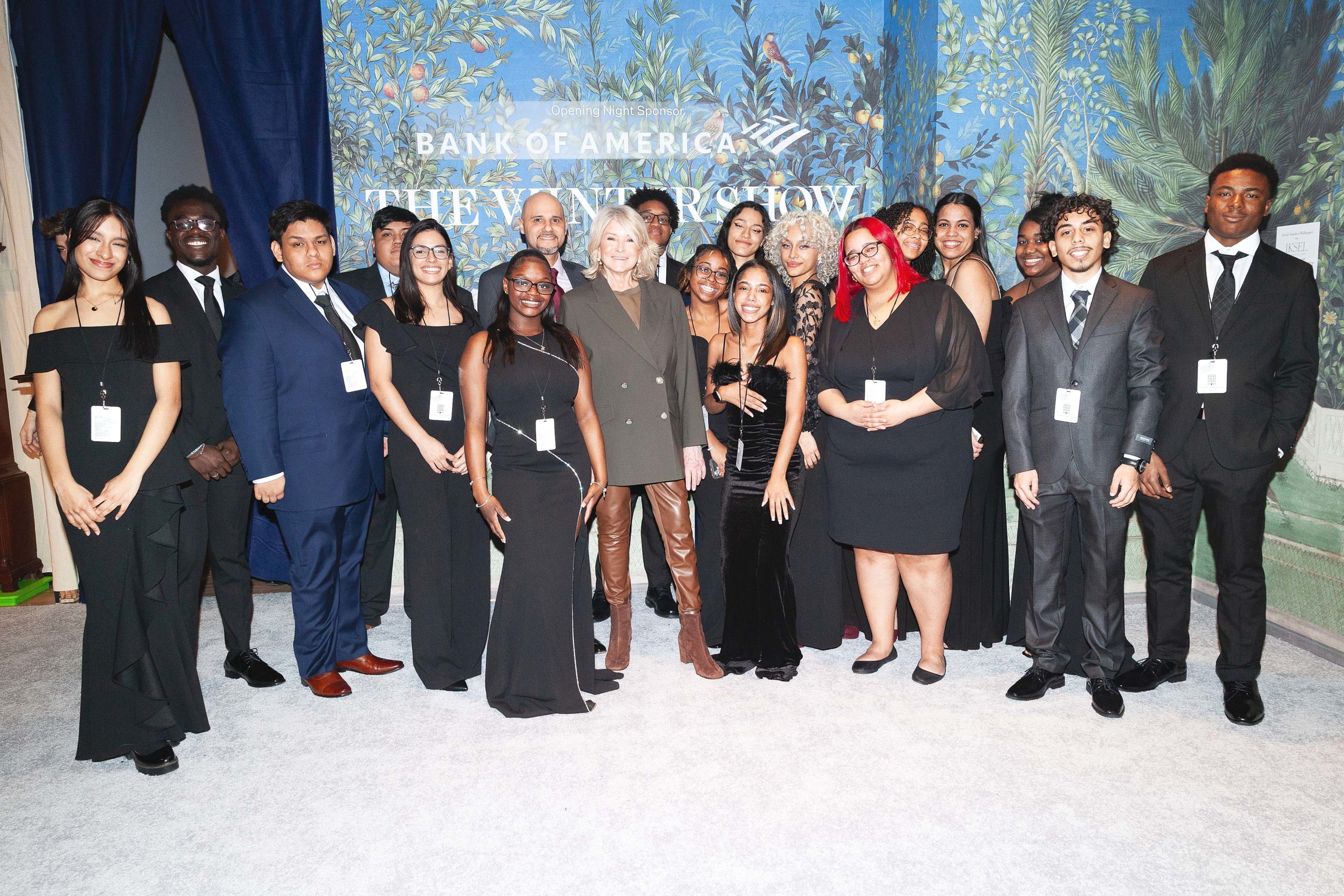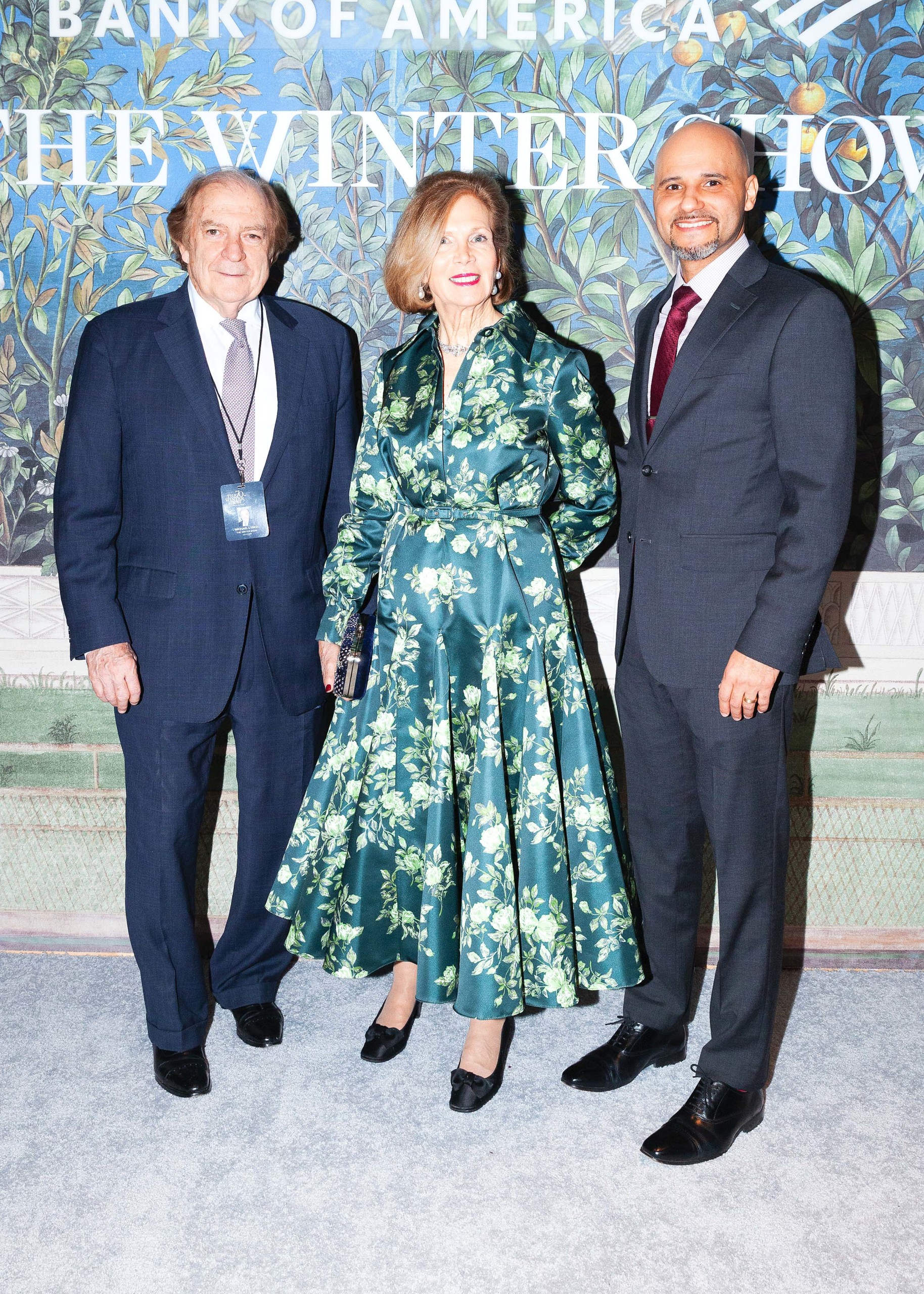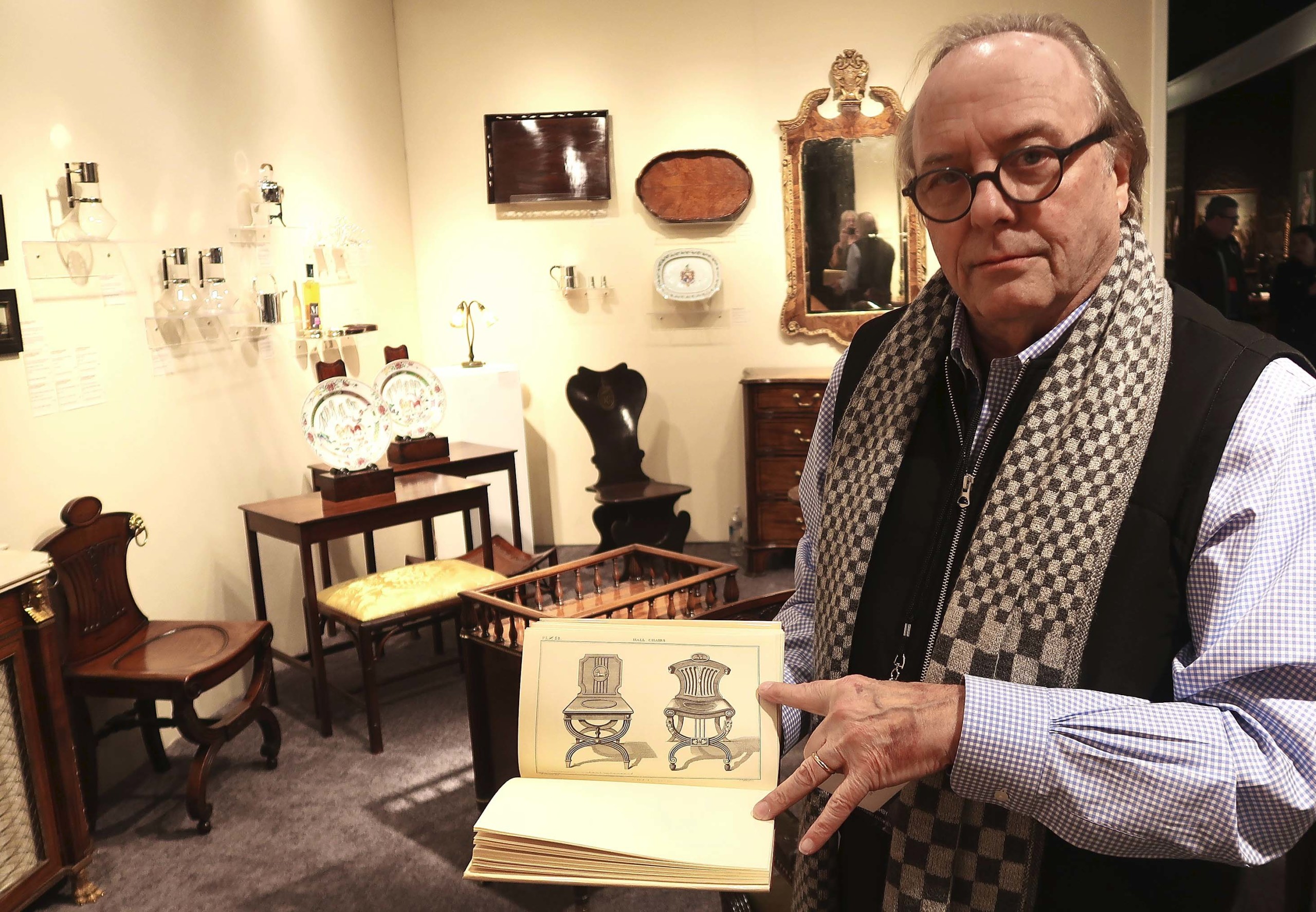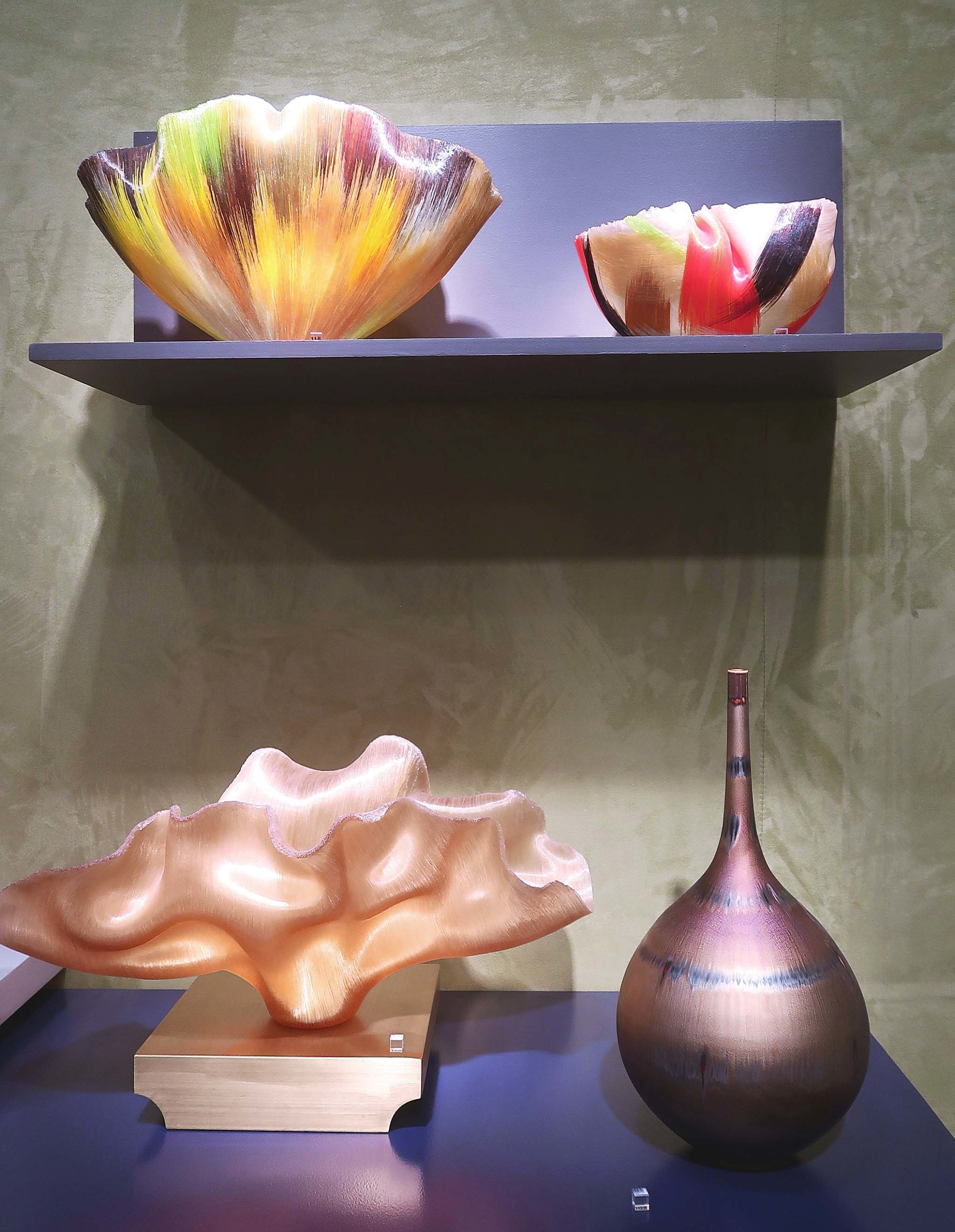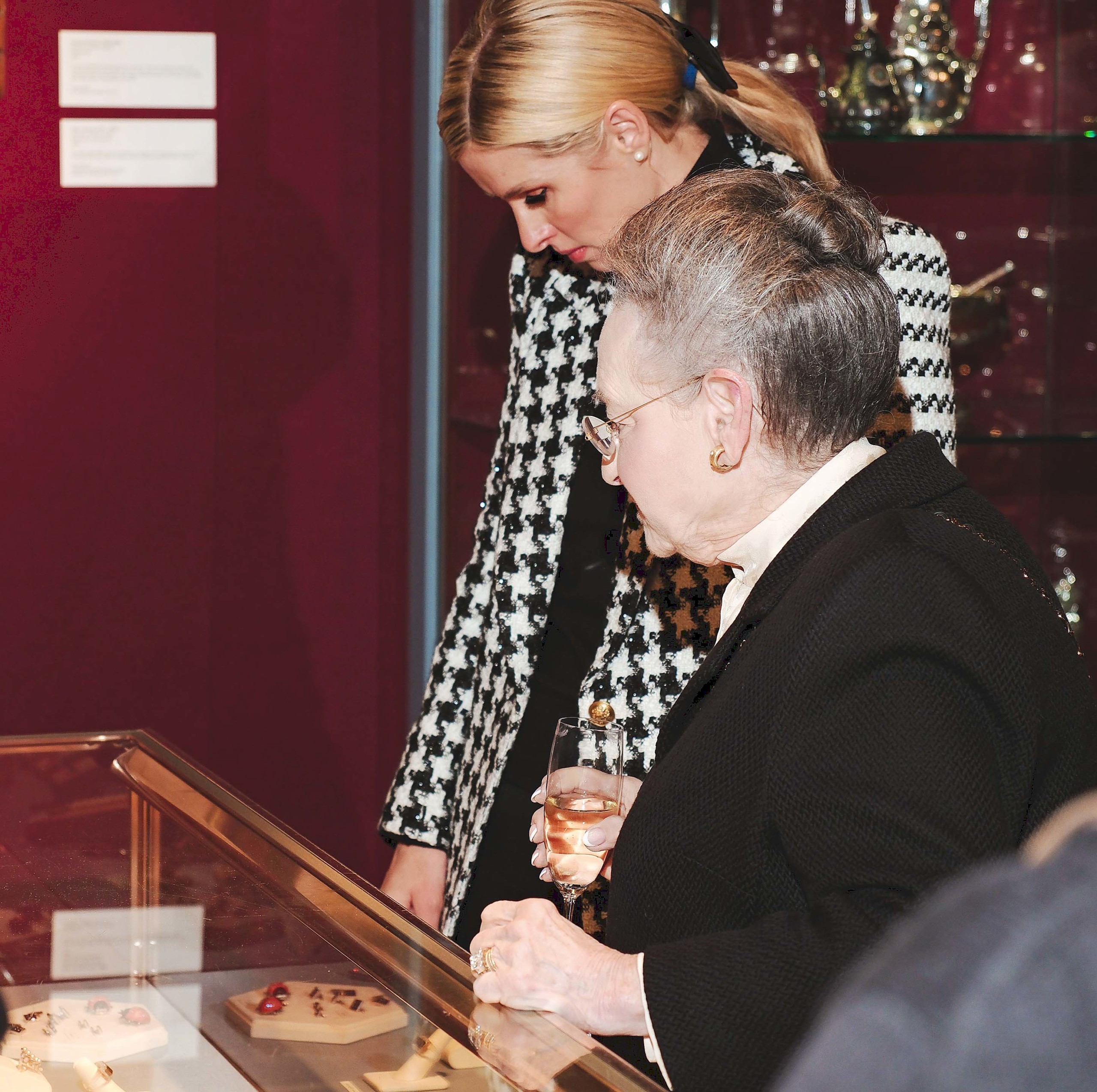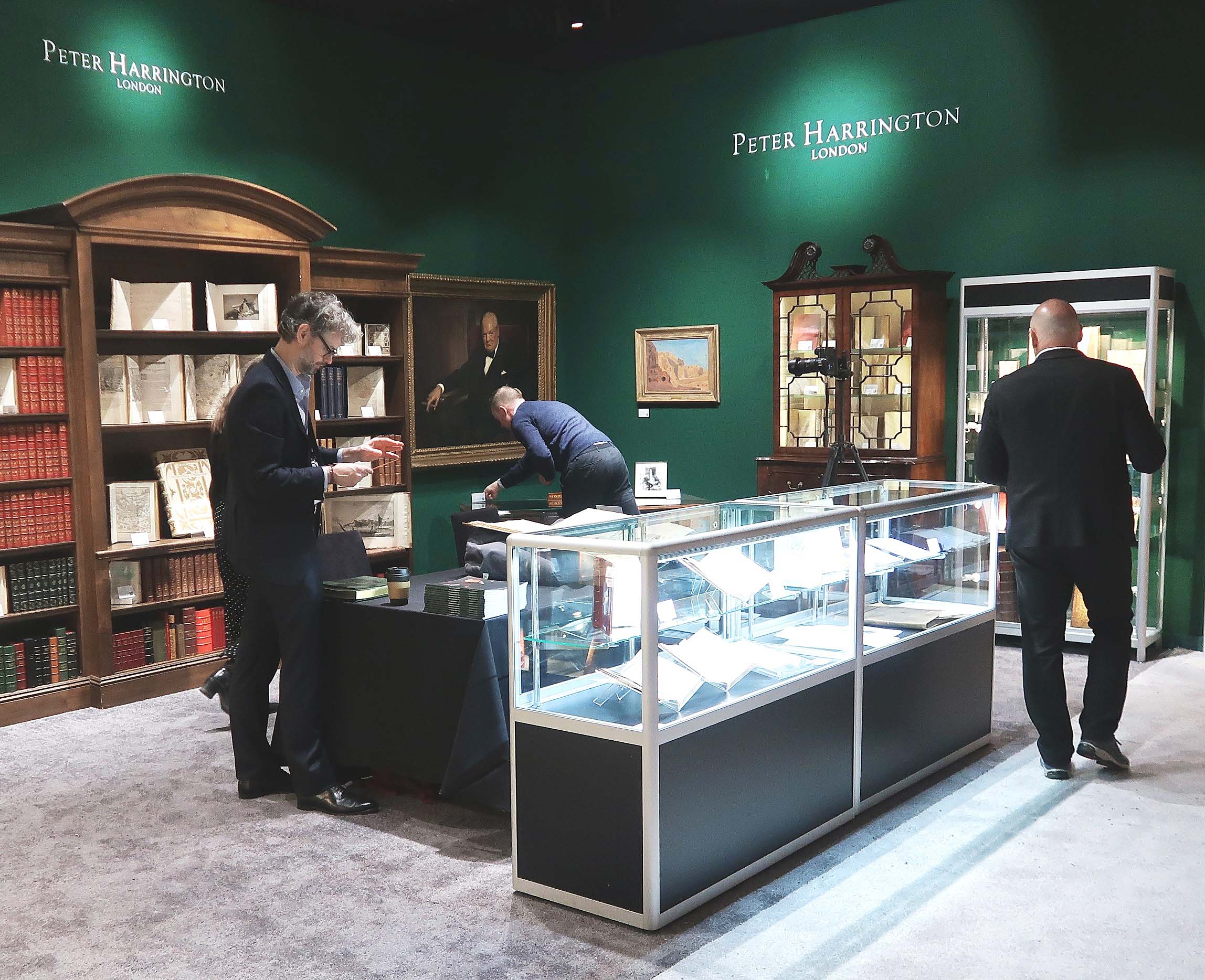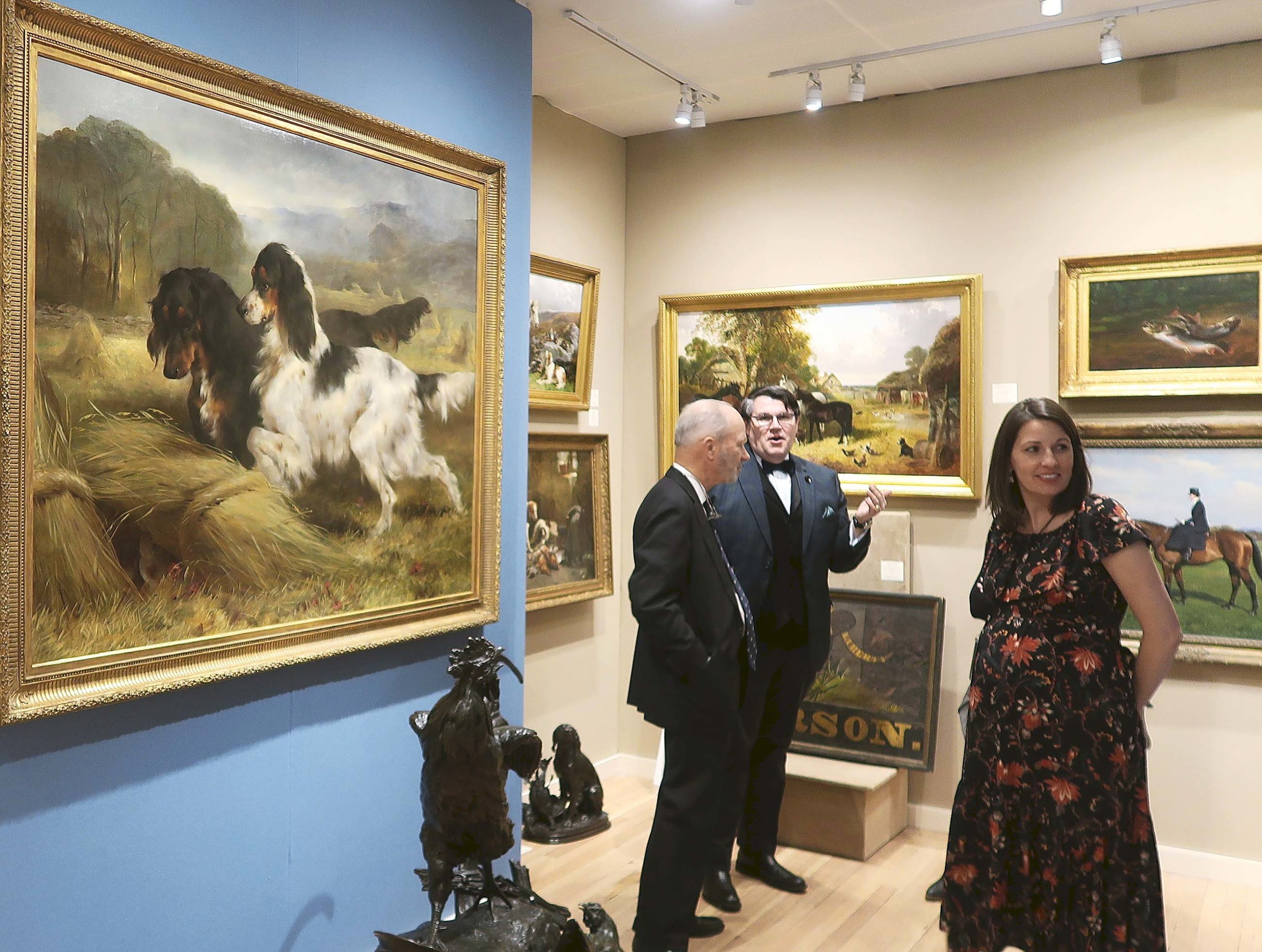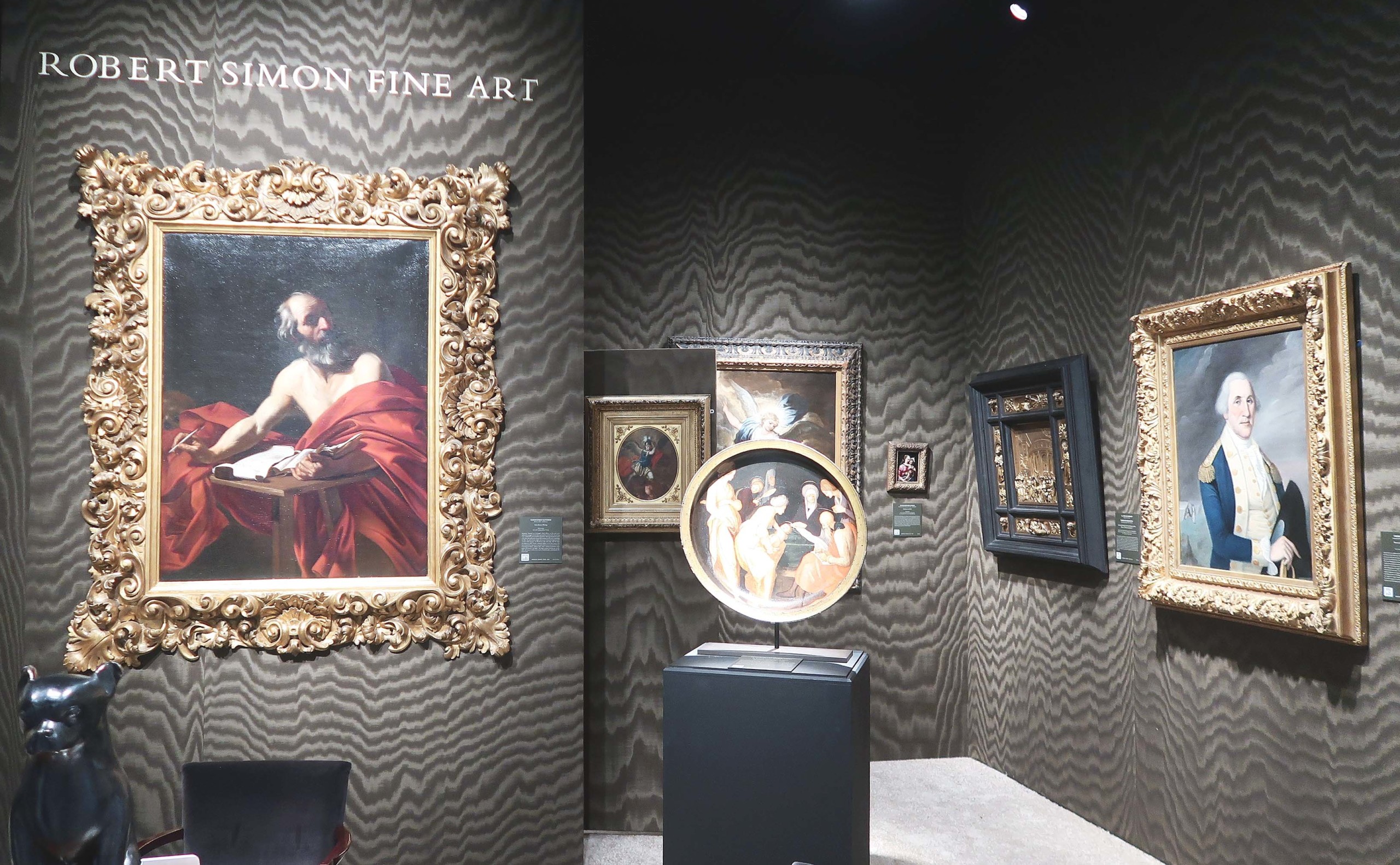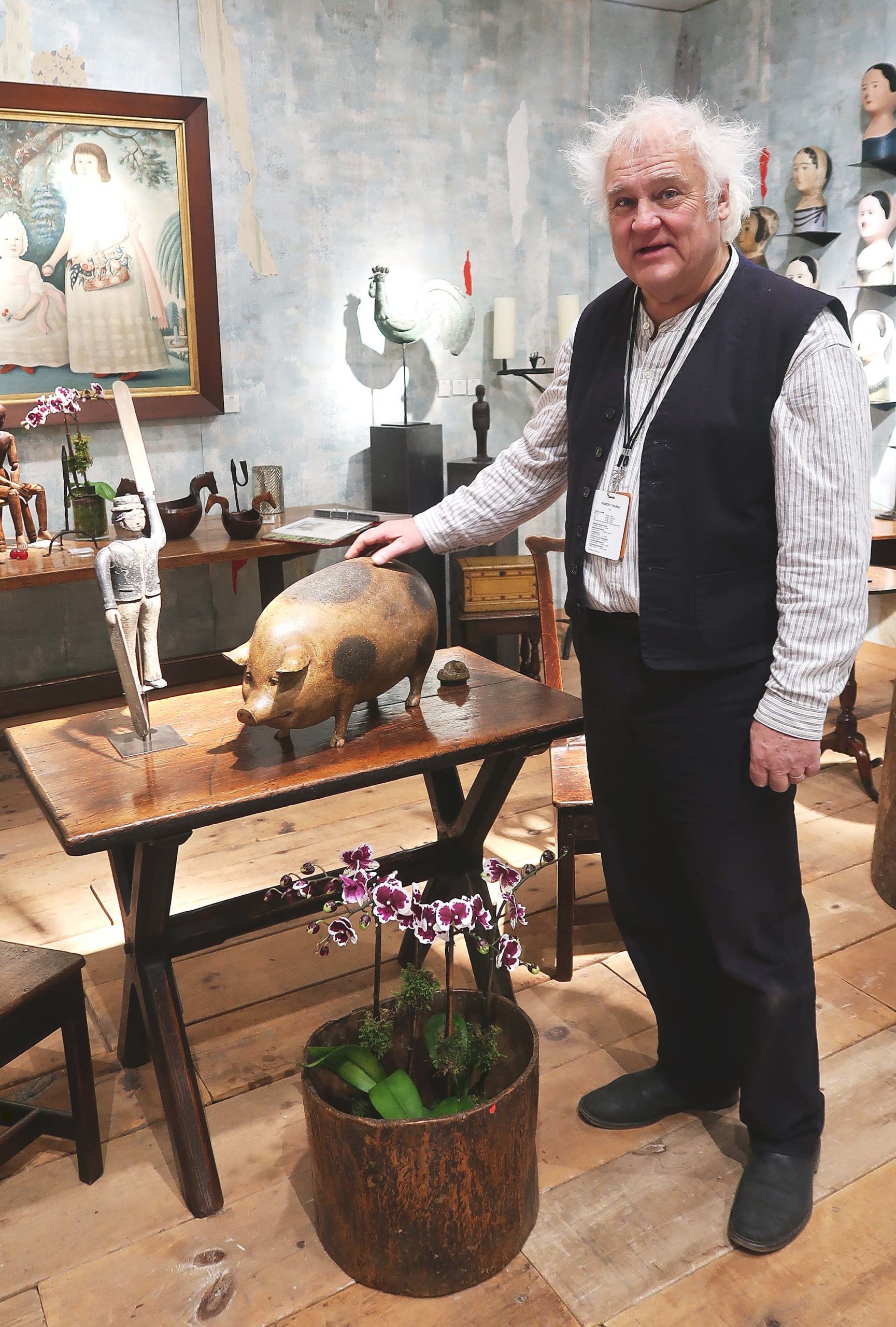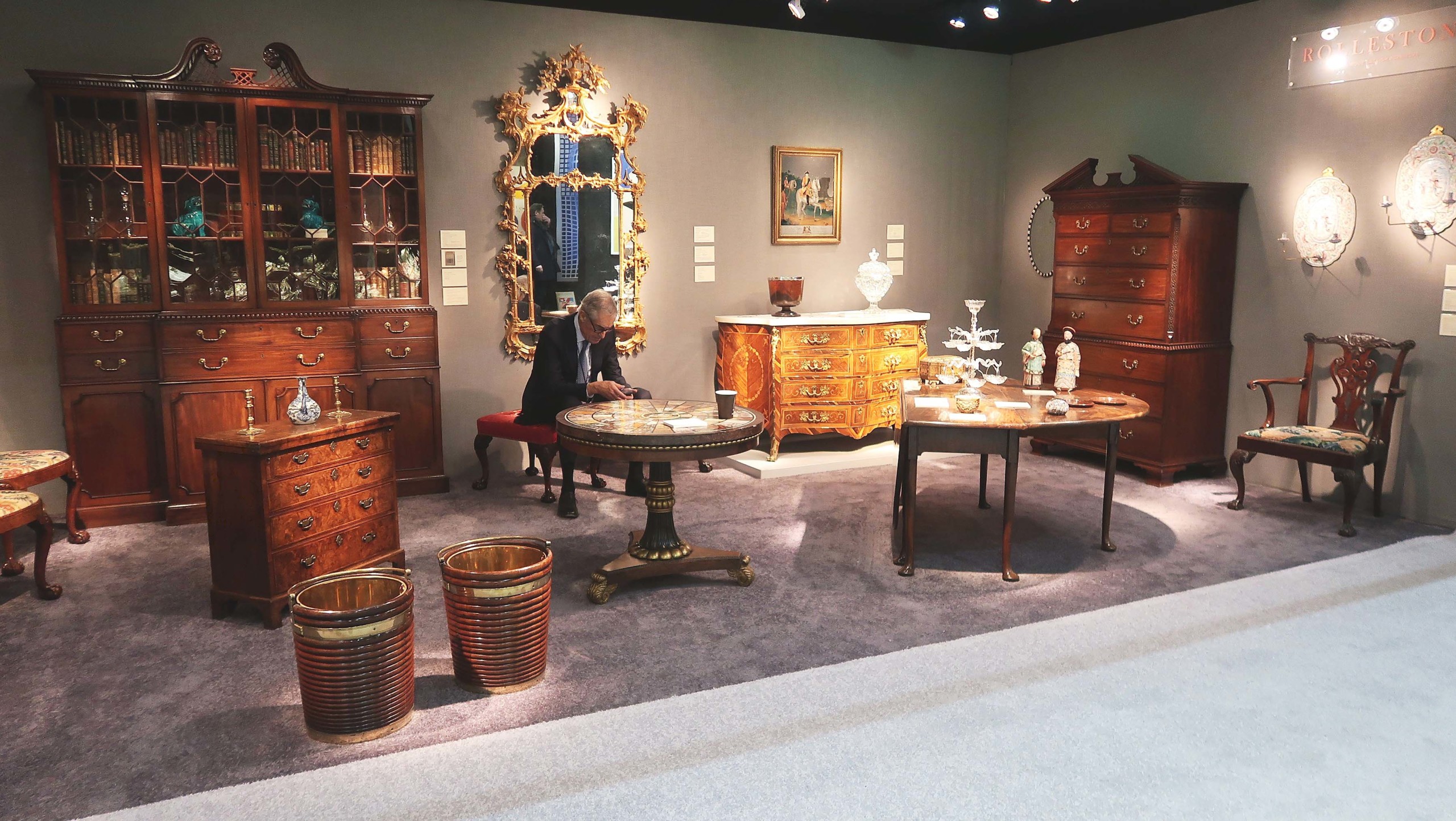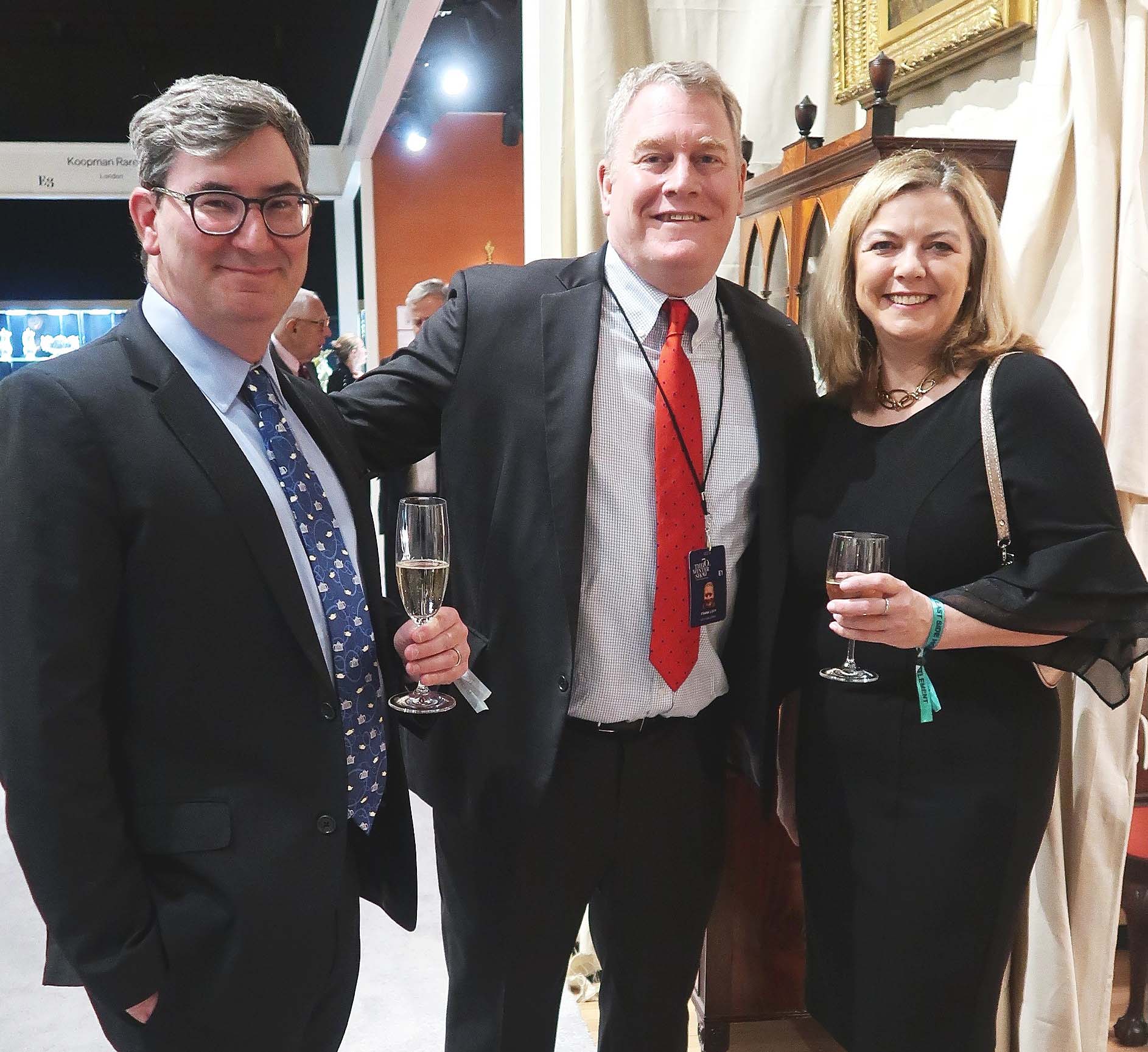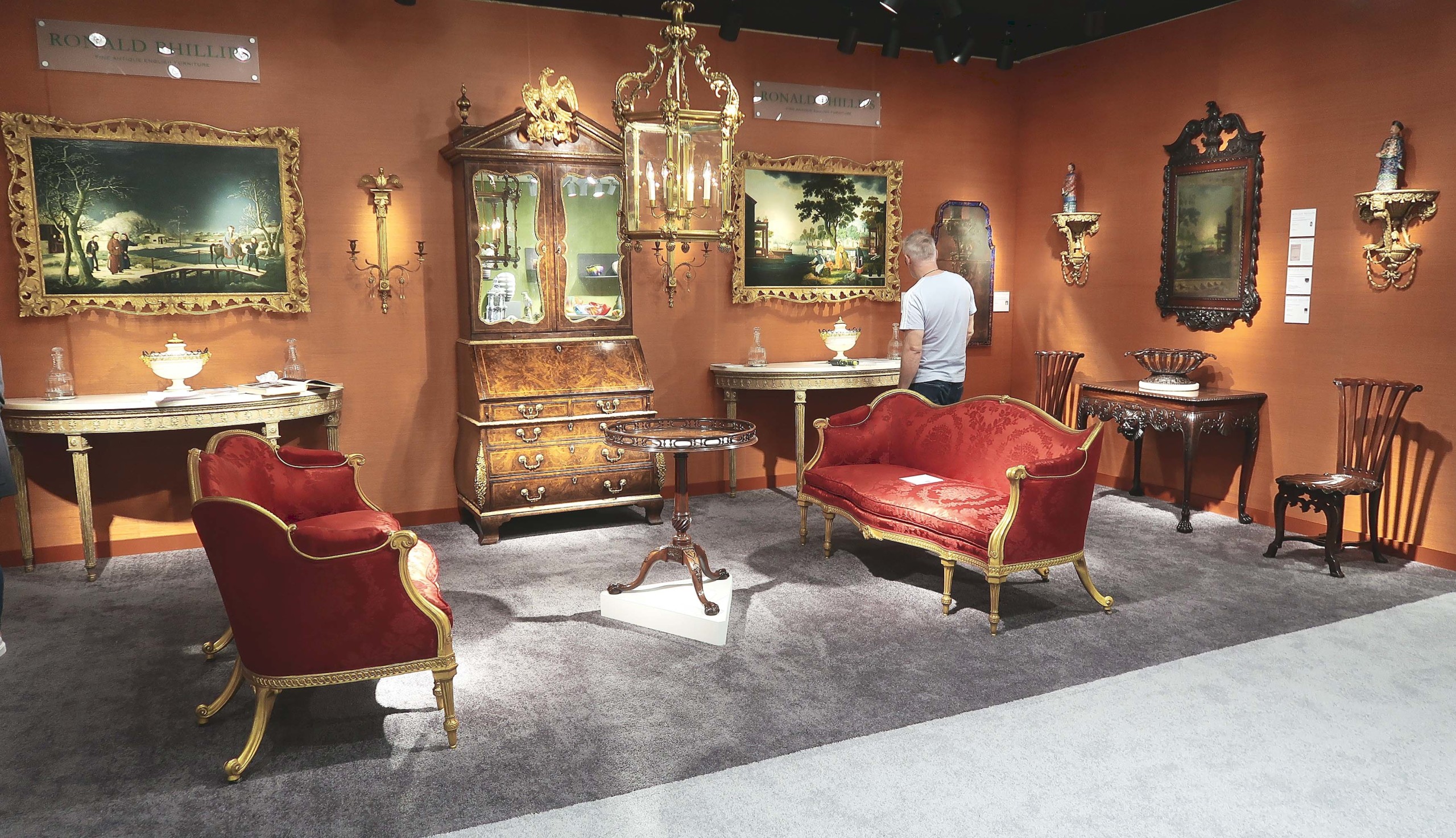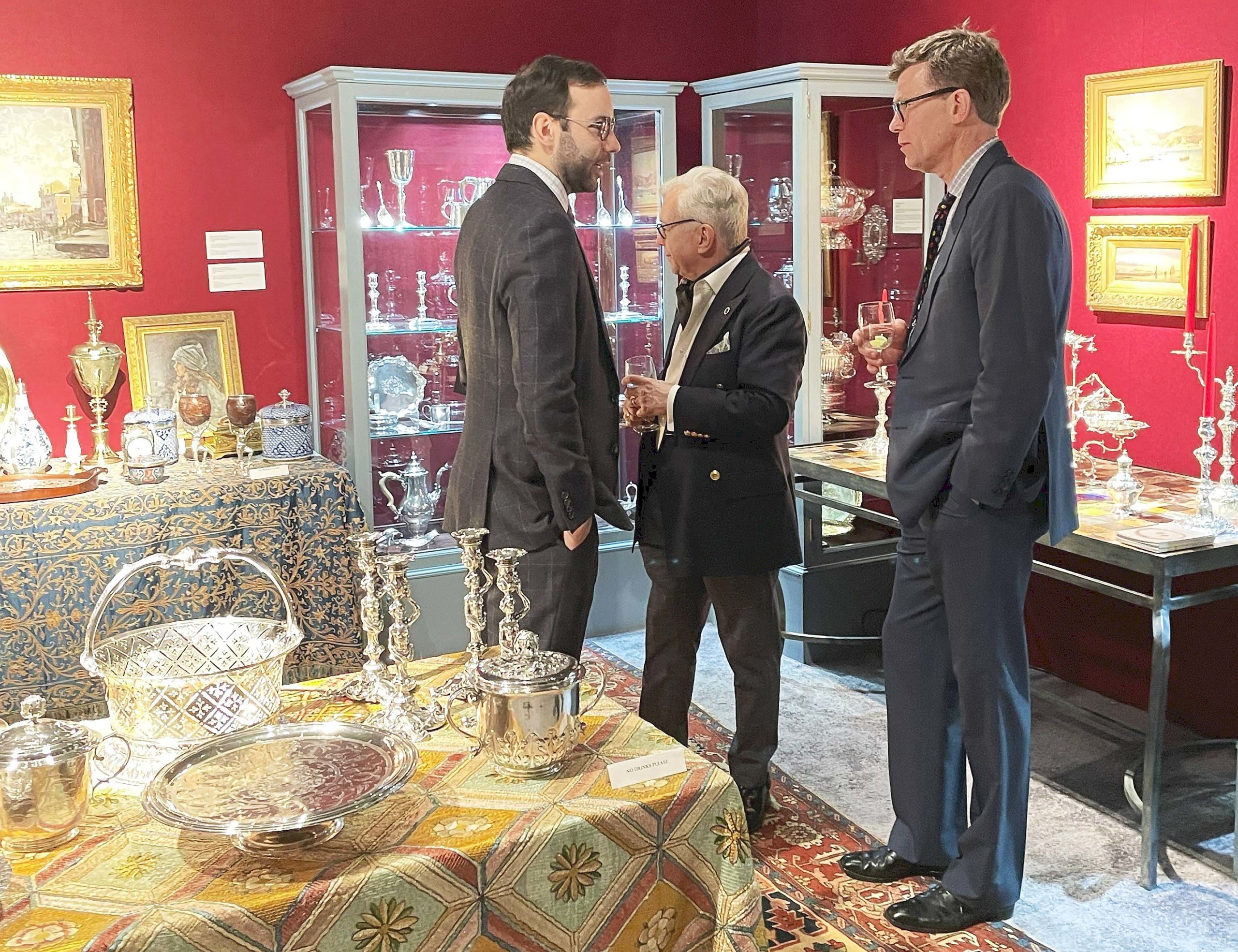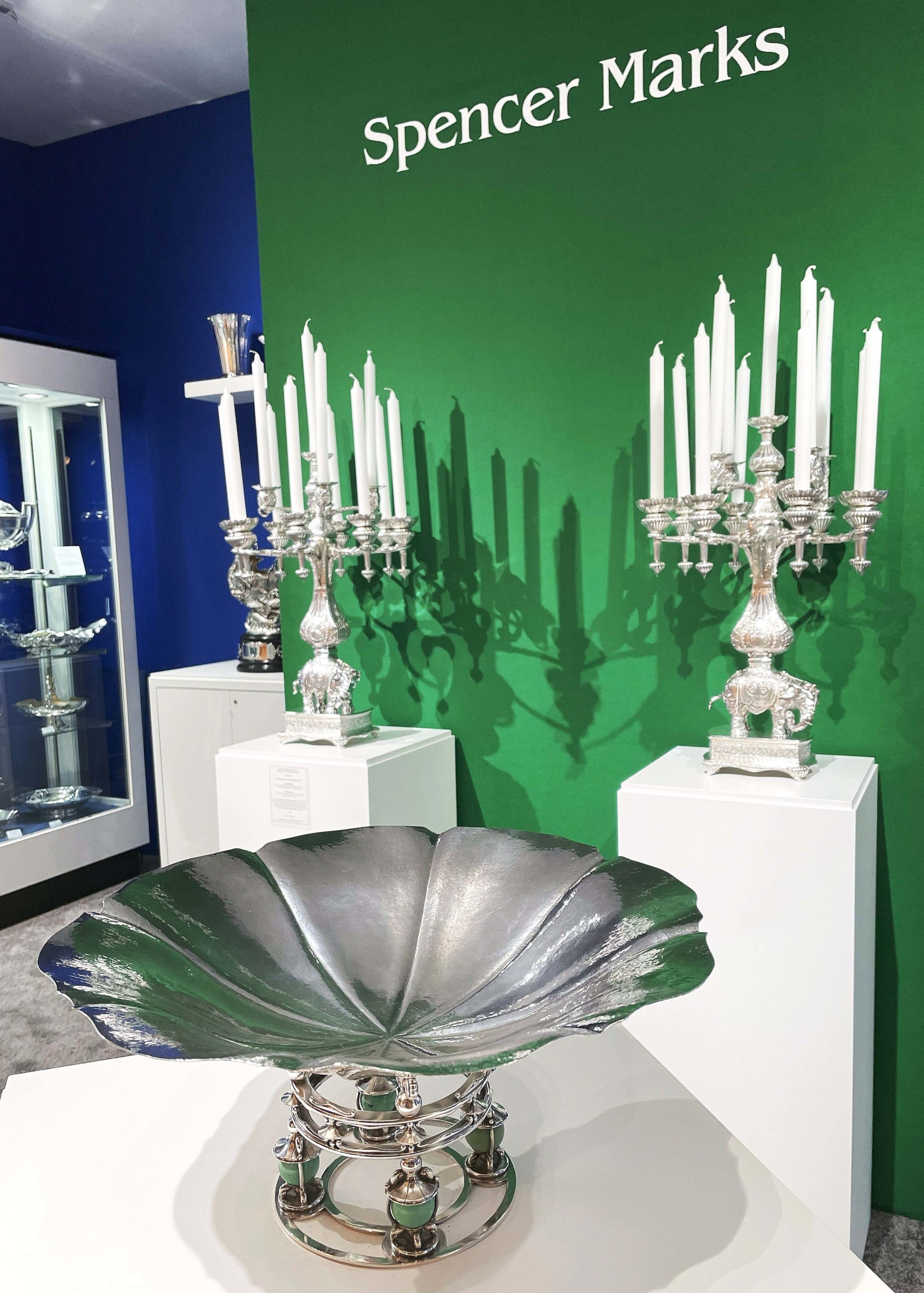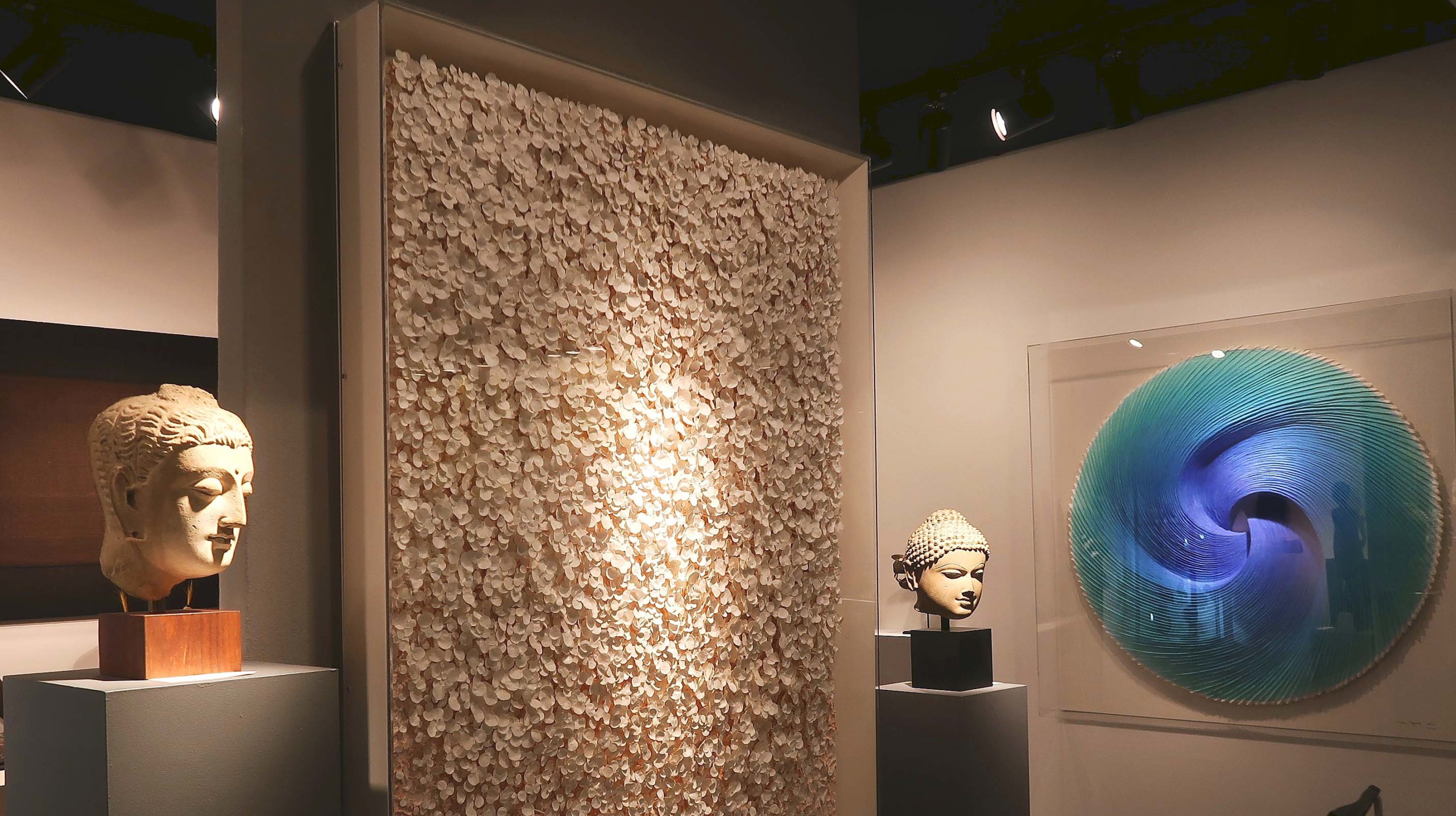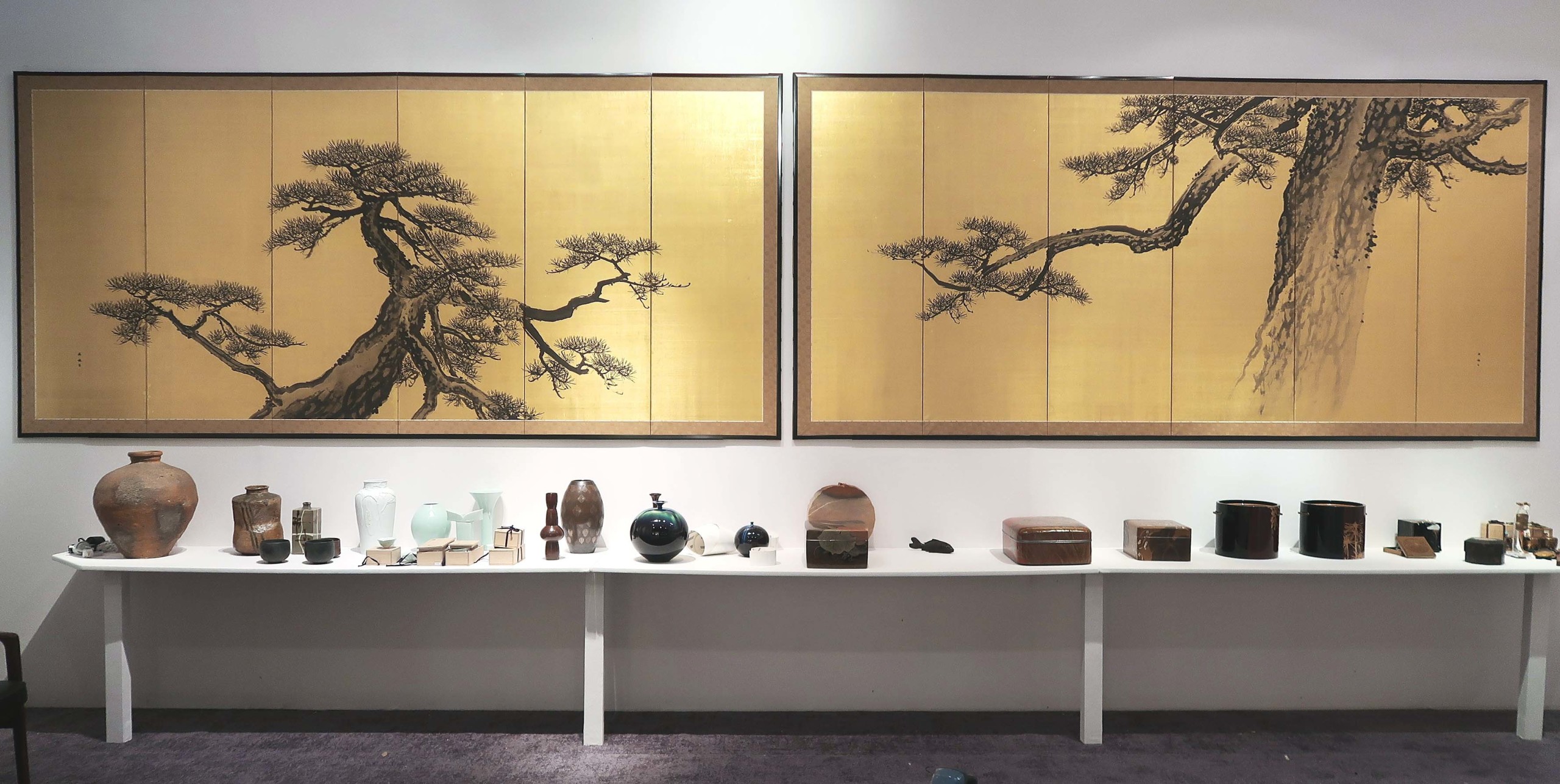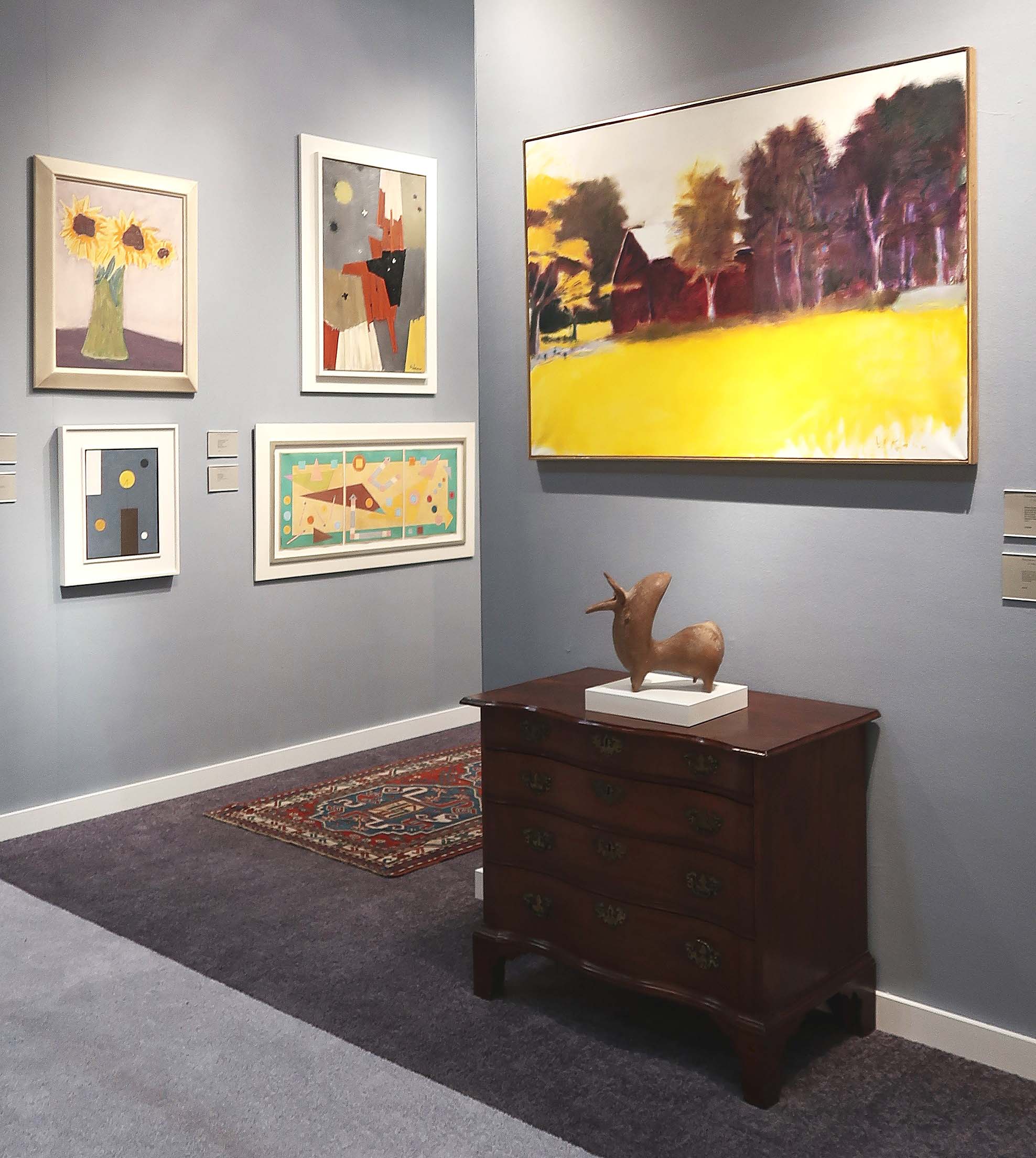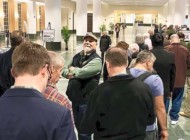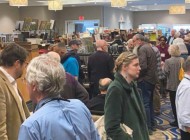Events, Programs & Partnerships Drive Attendance Over 11 Days
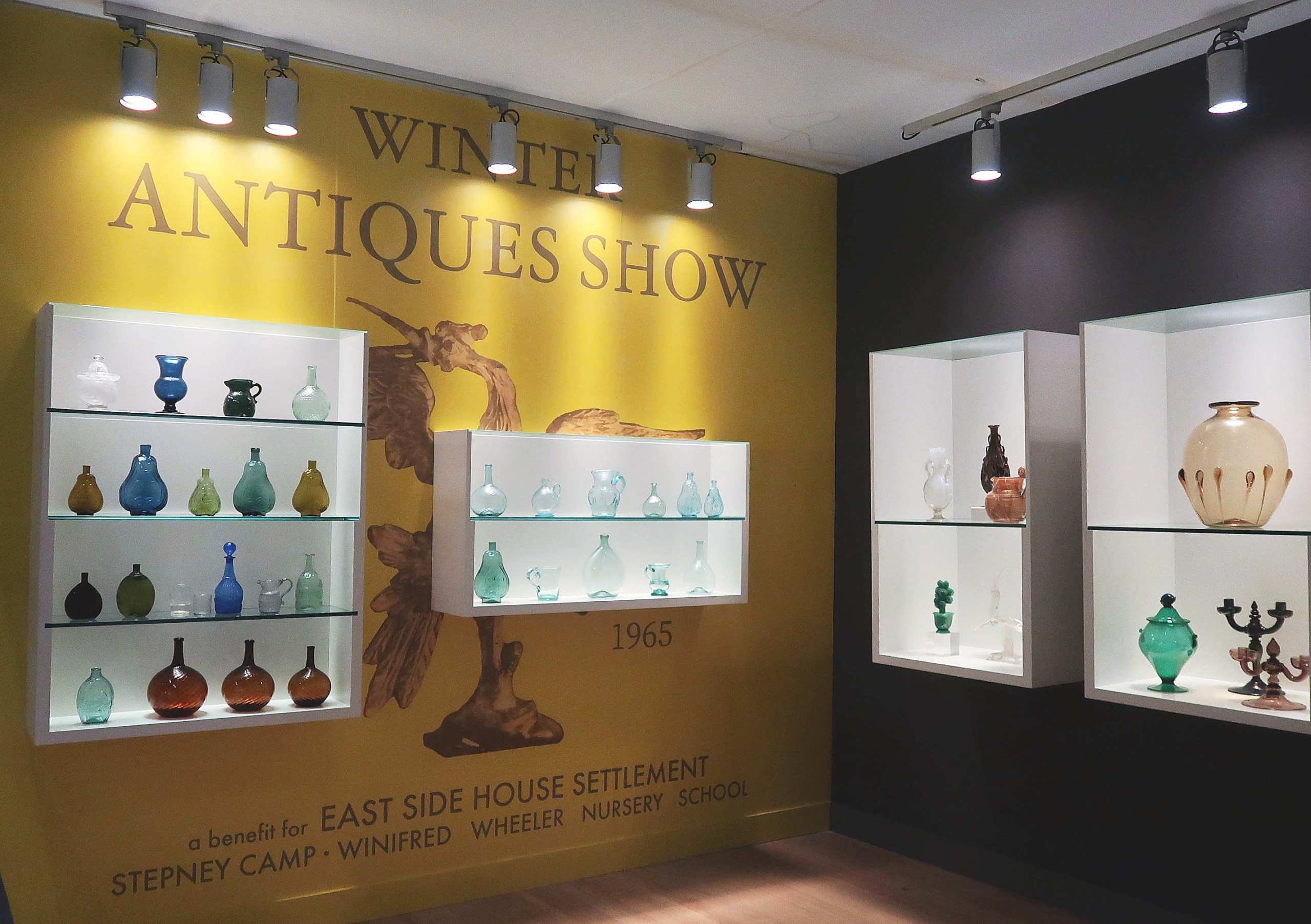
Jim Oliveira and Sara Blumberg of Glass Past paid tribute to The Winter Show’s legacy with their presentation of early American glass, left.
Review and Photos by Laura Beach
NEW YORK CITY — The beauty of The Winter Show is that it does two opposing things brilliantly. It provides an impeccable backdrop that, year to year, affirms tradition. It also nods gracefully to change, reflected in an evolving cast and updated content.
Continuity and change were unofficial themes of the 70th anniversary Winter Show, celebrated at the Park Avenue Armory from preview night, January 18, through the fair’s close on January 28. Other themes, as articulated by the show’s hardworking executive director, Helen Allen, were community, collaboration and craftsmanship. Seventy-six exhibitors took part in the fair, billed as a premier source for more than 5,000 years of fine and decorative arts and the longest running show of its kind in the United States. Net proceeds benefit East Side House Settlement, which recently received approval to establish Haven Charter High School, a healthcare-focused career and technical education model set to launch in 2025.
Run with military precision, The Winter Show is an increasingly complicated undertaking, offering in addition to its catalog and well-tooled website a host of events and programs designed to turn out specific audiences and strengthen ties with allied organizations. Sponsored by Bank of America, the opening night party attracted 1,000 guests. Chubb returned for its 28th year as the show’s presenting sponsor.
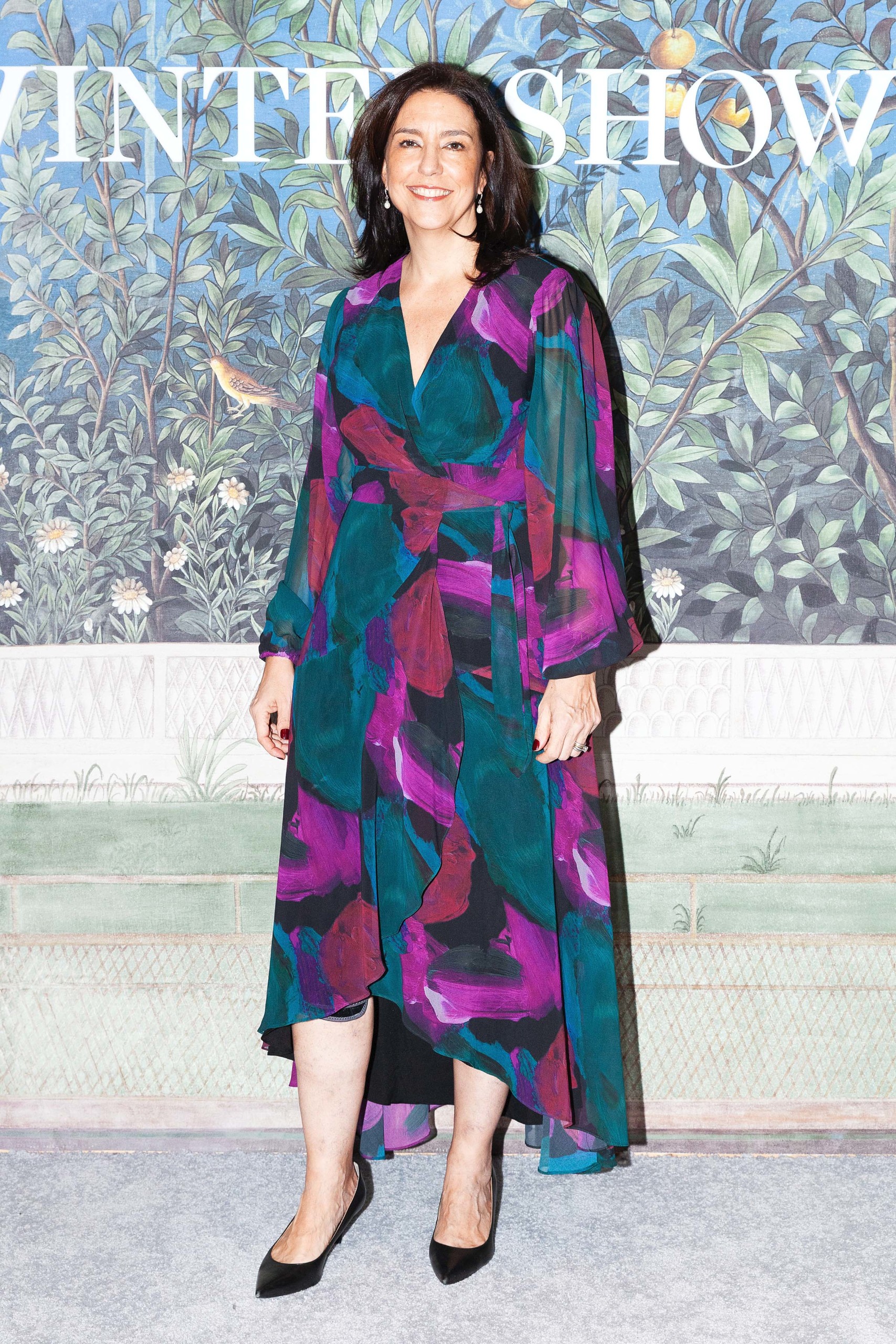
The Winter Show executive director Helen Allen. Photo by Matt Borkowski, BFA.com.
Jewel-box themed in partnership with Muzo Emerald Colombia, an exuberantly fashionable Young Collectors Night on January 25 broke attendance records, drawing “just shy of 900 guests,” said Allen, noting, “We’ve really cultivated a young generation that is deeply engaged with arts and design.”
Hirschl & Adler director Liz Feld named Connoisseurs Night, on January 26, her favorite event. “We had record crowds onsite enjoying wine tastings and booth talks. The energy was amazing!”
The Winter Show’s overtures to designers have also grown. “Our design luncheon, sponsored by the fashion brand Cara Cara, was a spectacular success this year. We could have sold it out three times over,” Allen said. Clinton Howell, a prominent exhibitor of fine English furniture and decorative accessories, added, “Management does a great job getting people in, particularly decorators, who are so important to the furniture trade. Decorators know something when they see it and act quickly. Their support has made my show.”
Special exhibits are also part of the secret sauce. Allen welcomed former Winter Show exhibitors back to the fair with the installation “Focus: Americana.” The concept, she explained, “is a focus on a particular area or time period, this year Americana. Whether we keep it as a mainstay, expand it or move into other areas is something we are discussing with our advisory council.” Working at the speed of light, Philadelphia Museum of Art curator Alexandra Kirtley selected paintings and objects offered for sale by Focus participants Kelly Kinzle, Nathan Liverant & Son, Olde Hope, David A. Schorsch and Eileen M. Smiles, Elle Shushan, Jeffrey Tillou Antiques and Allan Katz. Though elsewhere on the floor, Levy Galleries also lent pieces. Kirtley’s lively installation was a magnet for collectors, drawing Americana enthusiasts to what one participant called “old home week.” Exhibitors took turns manning their joint space through the week. Having sold his much-admired Captain Daniel Lacey highboy and a tavern table at the show, Arthur Liverant pronounced himself pleased with the venture.
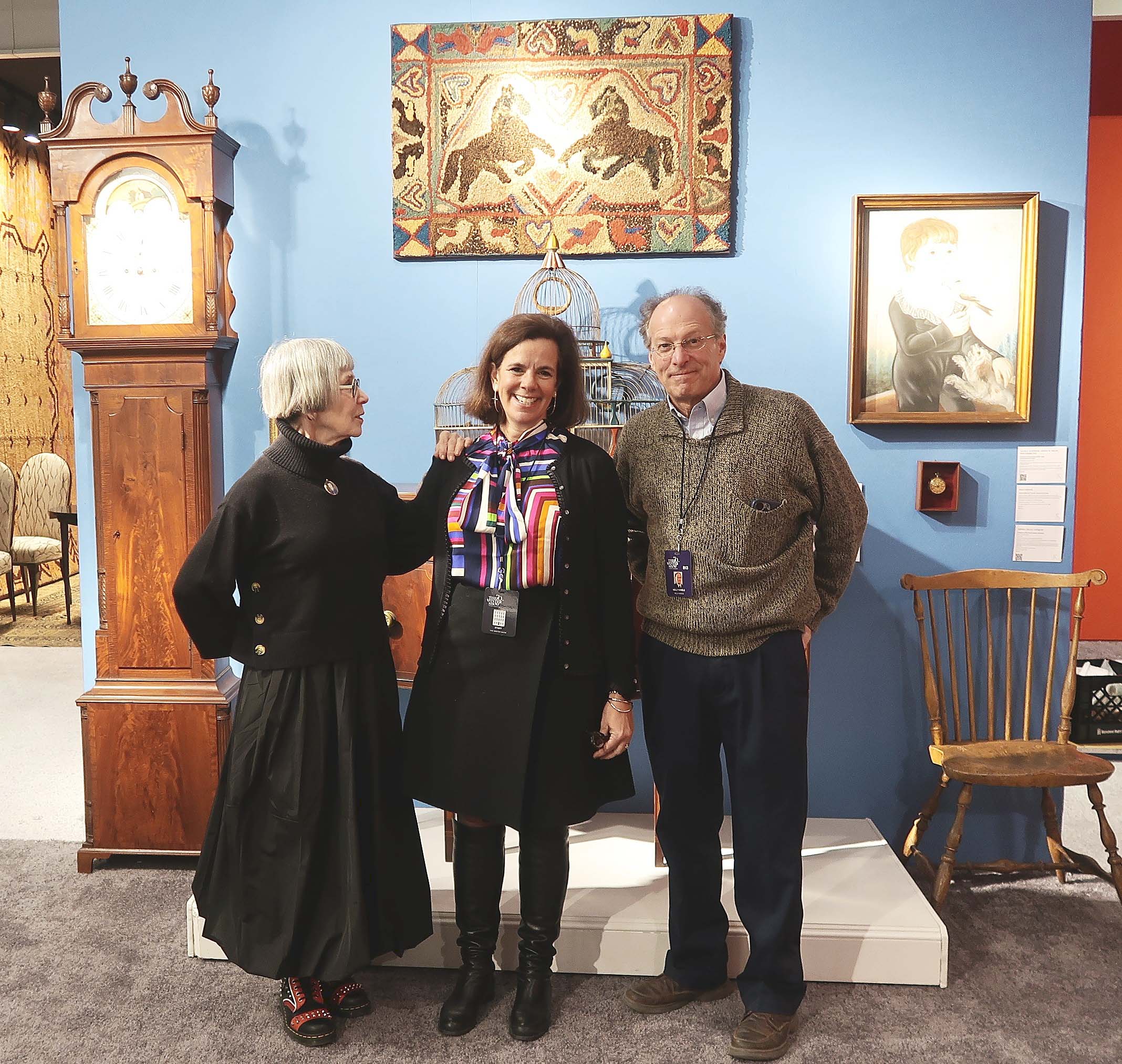
Philadelphia Museum of Art curator Alexandra Kirtley, center, got high marks for her selection and organization of pieces shown in “Focus: Americana.” With her are participants Elle Shushan and Kelly Kinzle.
Marketing to museums is also key. One place to spot curators on opening night was at Spencer Marks, always a gathering point for leading scholars in the field. Specializing in the highest expressions of late Nineteenth and early Twentieth Century American silver, the Massachusetts dealers sold a 1927 Gorham sterling and turquoise Art Deco centerpiece bowl by Erik Magnussen; a Marcus & Co. hand-wrought gold kylix-style cup likely exhibited at the Metropolitan Museum of Art in 1917; a rare Gothic sugar bowl by John Moore; and a set of six large sterling candlesticks by Howard & Co, NYC, 1904. Other sales were pending.
Known for his deep expertise in late Nineteenth and early Twentieth Century British design, Martin Levy of H. Blairman and Sons brought his dateline forward, adding Studio Glass by Sam Herman and ceramics by Charlotte Hodes to a selection that included a Christopher Dresser armchair and a previously unrecorded decanter designed by Archibald Knox.
Functioning as independent curators, several Winter Show exhibitors mounted thematic displays. Amsterdam dealer Robert Aronson offered a small but intensive look at the Dutch Seventeenth Century artist Frederik van Frytom, who painted on both wood panel and delft earthenware.
Joan B. Mirviss Ltd.’s special exhibition “Taking Space, Making Space: Japanese Women Ceramic Artists,” complemented the groundbreaking exhibition on the same topic at the Art Institute of Chicago through June 3 and nearly sold out by fair’s end. Mirviss’ show receipts increased 30 percent versus previous highs and included one of the fair’s most photographed pieces, a red “bundle” sculpture, illustrated on page 20. The work by emerging talent Tanaka Yu (b 1989) won an Exhibitors’ Choice Award and sold to a new client on opening night.
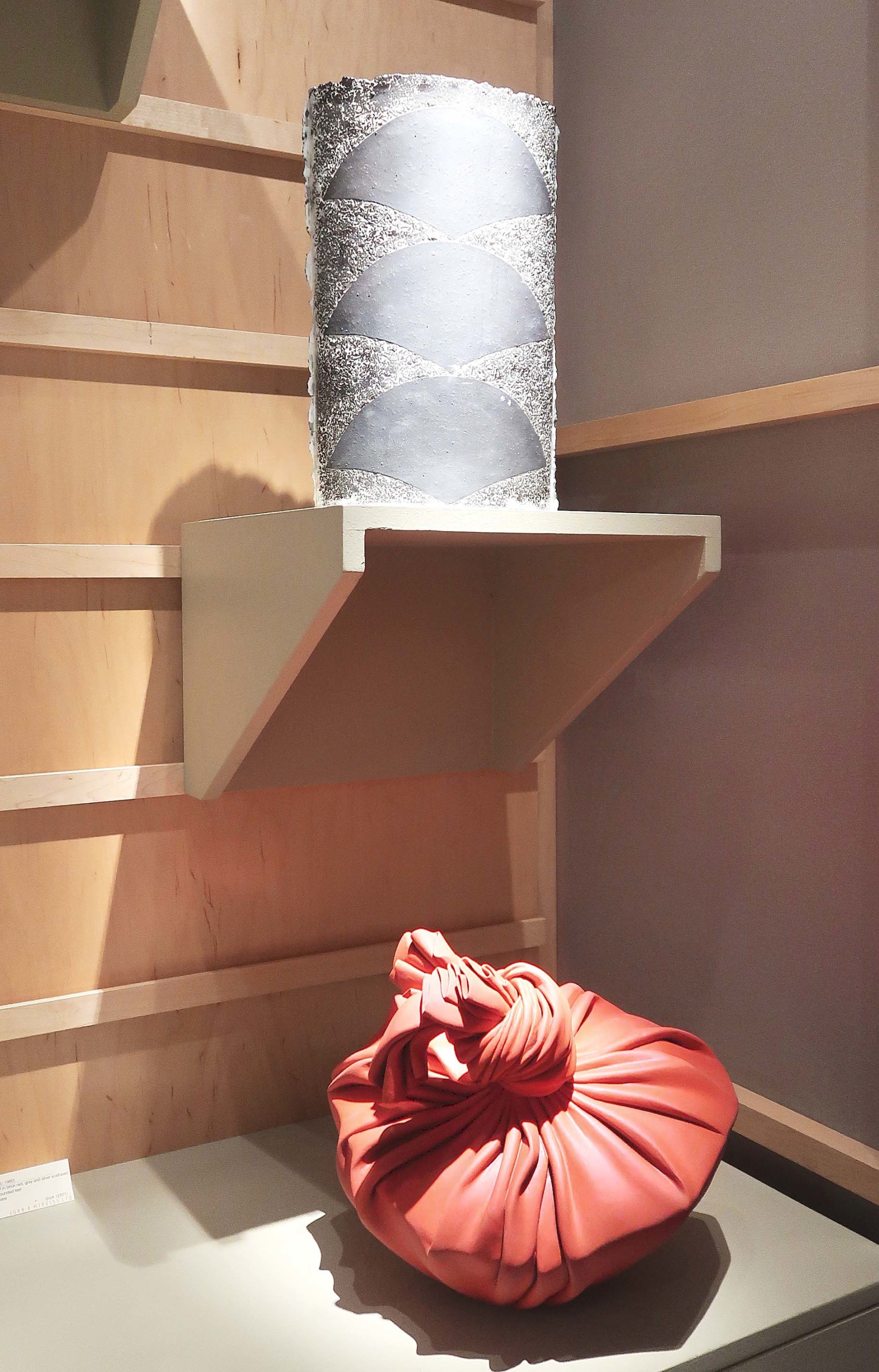
At Mirviss Ltd., glazed stoneware sculptures by, above, Tsuboi Asuka (1932-2022) and, below, Tanaka Yu (b 1989). Calling to mind a Japanese furoshiki wrapping cloth, Tanaka’s sculpture won an Exhibitors Choice Award and sold to a new client on opening night.
Daniel Crouch took two stands, devoting one to Petros G. Pelos’ collection documenting American Westward Expansion and exploration and the second to “Mapping the Holy Land,” featuring the Naftalin collection. “We’ve made seven sales so far,” the London dealer said mid-fair, noting, “We are in discussions with two potential customers for the Naftalin Collection. I’m very confident that the Holy Land maps will find their new home in New York soon.”
Best known for 1870-1970 Italian glass, Glass Past paid homage to the show’s legacy by arraying early American glass against a large blow-up of a 1965 Winter Show catalog cover. Exhibitor James Oliveira explained, “Early American glass was my first love. I dug bottles as a kid and pored over McKearin.”
Another clever reference to time and taste was found at Jonanthan Cooper, who beckoned shoppers with the vivid “Dining Room, Mount Vernon,” a 2023 exploration of George Washington’s palette by Canadian painter Harry Steen.
Levy Galleries, Hirschl & Adler and Charles Clark carried the flag for American furniture. Designed by Ralph Harvard, Levy’s tented booth sheltered a shell-carved Newport secretary attributed to Daniel Spencer, circa 1765; a Boston worktable attributed to Thomas Seymour, on offer for the first time; and one of the famous — and now sold — carved walnut Apthorp side chairs, circa 1750, which Levy attributes to New York, not Boston. Levy placed New York Mets and Boston Red Sox ballcaps on the chair, a sly reference to the scholarly dispute.
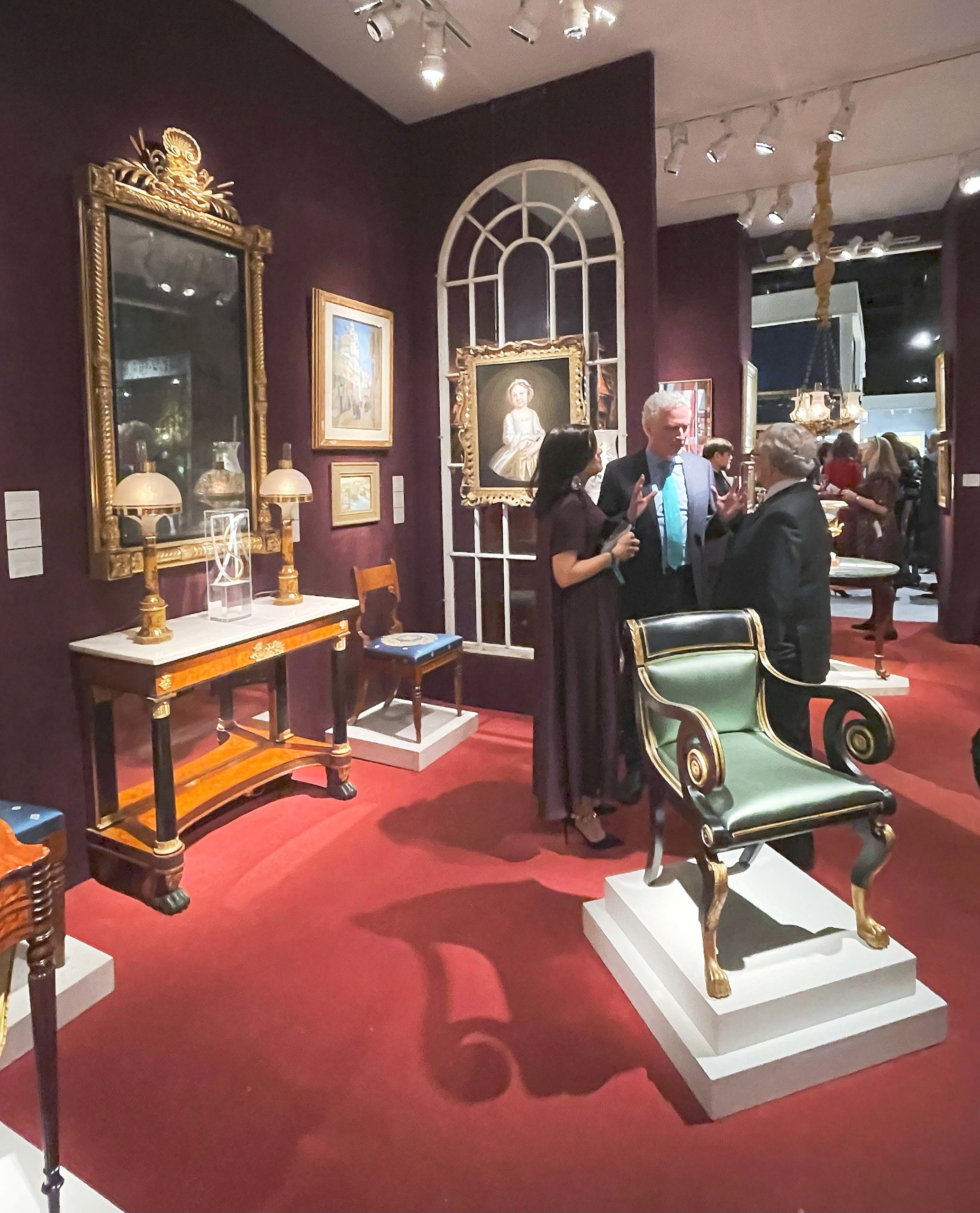
Attributed to Duncan Phyfe of New York and dating to around 1825, a Classical armchair stood out in Hirschl and Adler’s display. New York City.
Along with Duncan Phyfe, there was more Seymour furniture at Hirschl & Adler, where the 49-year fair alumnus presented an attributed marble-top Seymour table with carving by Thomas Wightman and a linen press, circa 1825-28, also likely made under the supervision of the Boston cabinetmaker. One notable sale was a pair of French yellow-tôle sinumbra lamps of about 1820 to Boscobel House and Gardens. “We could not dream up a better match,” said Liz Feld, adding, “The show has been lively and crowded and it feels very much like a pre-pandemic edition. We’ve seen numerous collectors and institutions that we were very much hoping to reconnect with here.”
Connecticut dealer Charles Clark, who anchored his display with a circa 1830 Classical bookcase secretary attributed to John Meads and William Alvord of Albany, N.Y., made a dozen or so sales by midweek, among them a Boston Classical bergère, a carved Irish bench, Parian busts and lighting.
Set against a startling backdrop of acid green and pink, Debra Force’s display of early Modernist American painting was a triumph. Her centerpiece — Robert Henri’s 1924 portrait, “Dorita” — was named a best-of-show. The penetrating work sold, along with pieces by Jervis McEntee, Thomas Birch, Walter Gay, Charles Sprague Pearce and Maurice Prendergast.
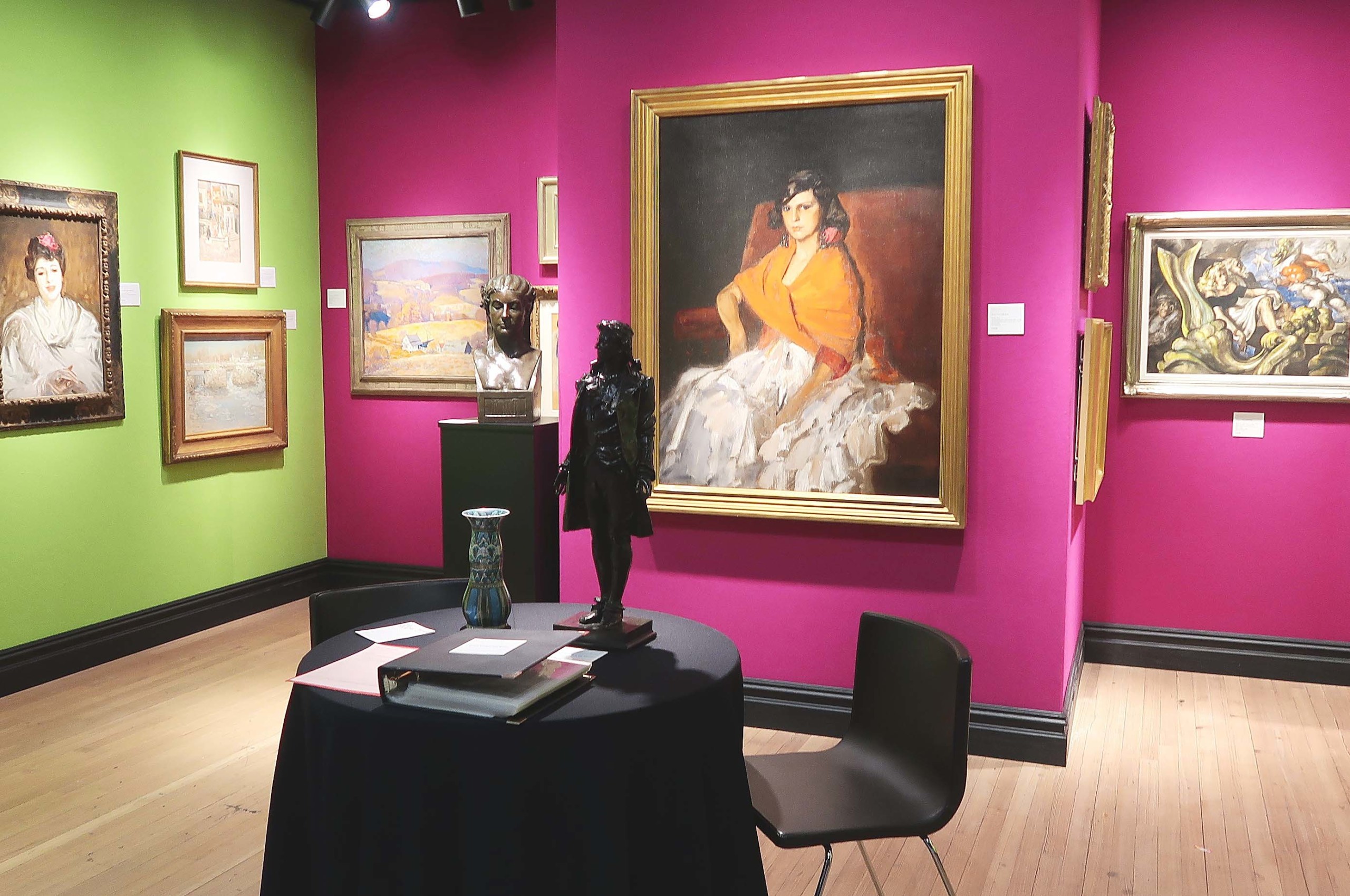
“Dorita” by Robert Henri (1865-1929), 1924, center, anchored a display of early Modernist American paintings at Debra Force Fine Art, New York City. Visible far left is “La Carmencita” by John Singer Sargent. Far right, “Eldorado: The Sorrow and Futility of Man Before the Beauty of Woman” by Reginald Marsh.
In addition to the Henri, other compelling portraits included, at Adelson Galleries, Jamie Wyeth’s oil on canvas rendering of artist Andy Warhol and his business associate Fred Hughes, a work so culturally resonant it seems destined for an institution; a 1608 oil on panel painting of a Dutch family of four, thought to be from Delft and sold by Lawrence Steigrad Fine Arts; Robert Young’s charming triple portrait of three sisters, familiar from the 1996 catalog British Folk Art and English Naïve Painting 1700-1900; and several stylized busts of his second wife and muse Jacqueline Roque by Picasso at John Szoke Gallery of New York. Pennsylvania dealer Kelly Kinzle led with the newly rediscovered portrait of “Liliha, Wife of Boki,” the historically significant depiction of a Hawaiian noblewoman attributed to John Hayter, who painted Liliha while she was on diplomatic tour in Britian in 1824.
UK specialists in sporting, wildlife, travel and maritime art, Rountree Tryon wrote up eight works by show’s end. Among them was a naval panorama off St Peter Port, Guernsey by Peter Monamy, selling for a six-figure sum to a private client.
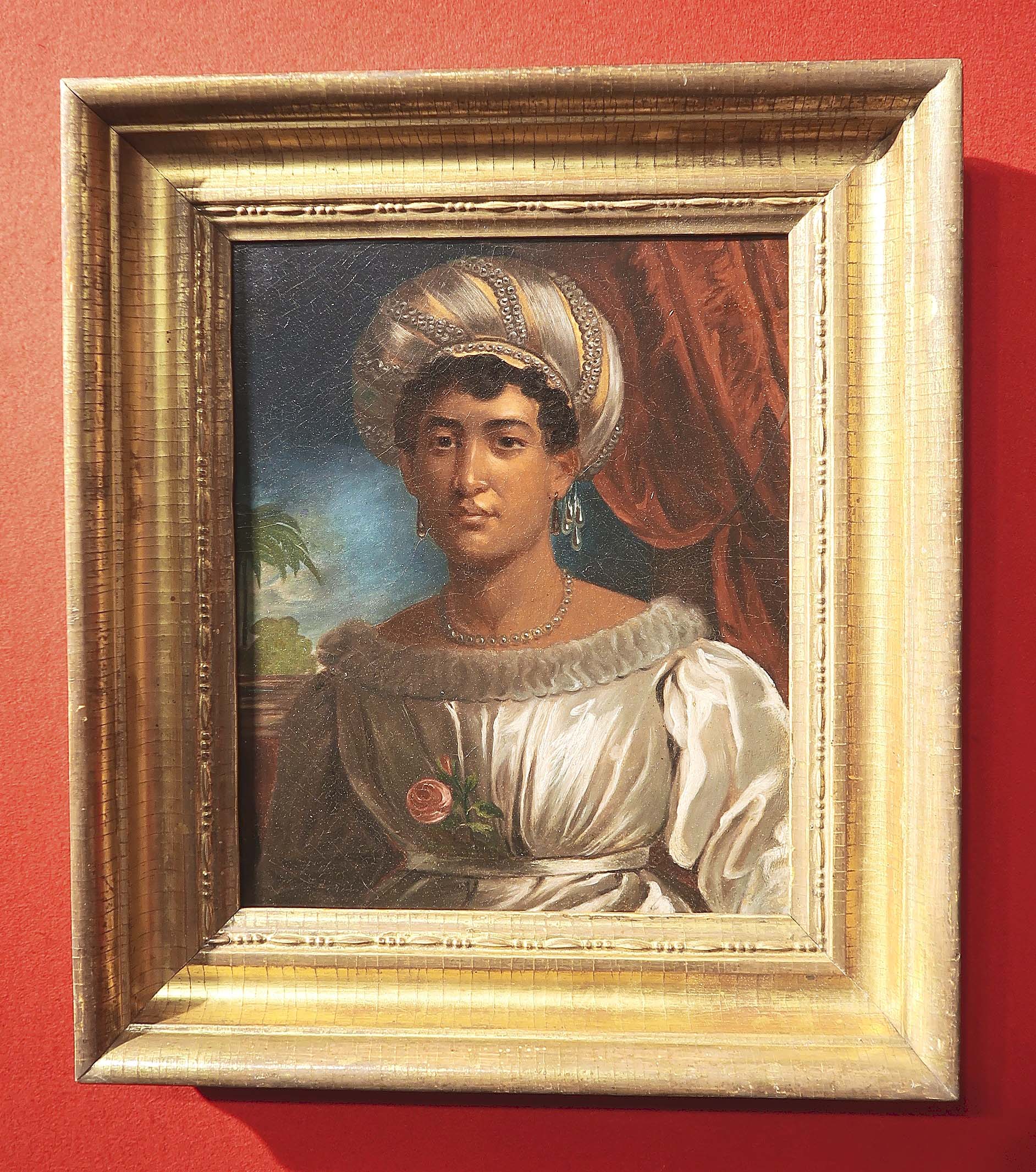
Participating in “Focus: Americana,” Pennsylvania dealer Kelly Kinzle displayed the recently rediscovered portrait of noblewoman Liliha, Royal Governor of the Island of Oahu. The picture is attributed to British painter John Hayter.
“With Master Drawings New York later than usual this year, we all worked together to have a second breakfast for curators,” said Allen. The initiative may have been a boon to sales for Hill-Stone, which sold a rare pen and ink drawing by a follower of Hieronymus Bosch to a private New York collection on opening night, and a drawing by Giovanni Battista Tiepolo, circa 1745, for mid-five figures to a private US collector who had recently seen the Tiepolo exhibition at the Morgan Library. Robert Simon, a dealer in Old Master paintings and sculpture, parted with smaller paintings by Sanchez Coello, Giacomo del Po and Domenico Antonio Vaccaro, plus a sculpture of a dog by Chana Orloff and a Spanish Colonial silver casket. More expensive works were under review by museums and collectors.
Interest in historical material remained strong. Thomas Heneage Art Books parted with a rare hand-illustrated first edition of Mary Gartside’s An Essay on Light and Shade, on Colours, and on Composition in General, 1805. The Old Print Shop wrote up a 1779 mezzotint portrait of Mohawk chief Joseph Tayadaneega, called Brant, after the painting by George Romney. London dealer Peter Harrington sold a desk from Winston Churchill’s Hyde Park Gate home, where the British statesman wrote his World War II memoirs.
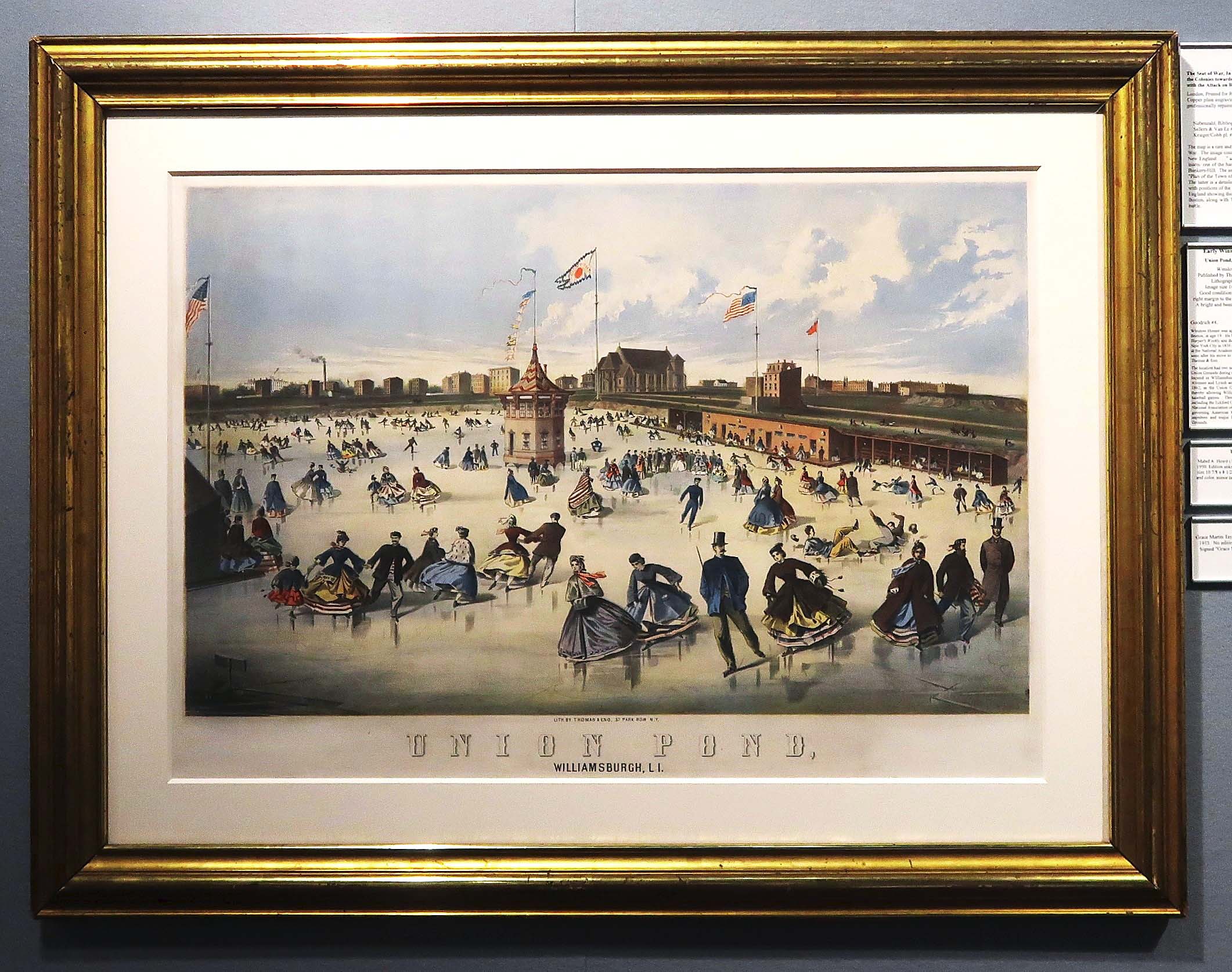
Attributed to Winslow Homer, the circa 1862 color lithograph “Union Pond, Williamsburgh, L.I. [sic]” was an early sale at The Old Print Shop, New York City.
Drop-dead elegant was the joint presentation of Carolle Thibaut-Pomerantz, a specialist in historic wallpaper, and Galerie Leage of Paris, offering French XVIII century furniture and decorative arts. Thibaut-Pomerantz’s pièce de resistance was “Allegories of the Arts,” a suite of quasi-trompe l’oeil architectural panels designed by Percier and Fontaine, and most likely printed by Jacquemart and Bénard in Paris around 1800. Related works are in the Musée des Arts Décoratifs, Paris.
Bernard Goldberg Fine Arts and, across the aisle, Lillian Nassau LLC wowed visitors with architectural elements and architect-designed appointments and drawings. Signature pieces at Goldberg included chairs, a coat rack and drawings by Austrian architect and designer Josef Hoffmann; chairs designed by the Hungarian American architect and designer Marcel Breuer; and a grand piano designed by Uruguayan architect Rafael Vinoly in collaboration with Chris Maene.
Nassau Ltd. countered with the circa 1900 “Thistle” mosaic panel salvaged from the James A. Patten residence, designed by Chicago architect George Washington Maher and demolished in 1938. The panel’s mate is at Princeton University Art Museum. Elsewhere in Nassau Ltd.’s display was the circa 1899 “Diana of the Tower,” a 26½-inch bronze reduction of the monumental sculpture commissioned by Stanford White from Augustus Saint-Gaudens for the top of Madison Square Garden. Saint-Gaudens also appeared prominently in the booth of Lowell Lisbon and Jonny Yarker, Ltd., London dealers who featured the artist’s 1888 plaster bust of General William Tecumseh Sherman.
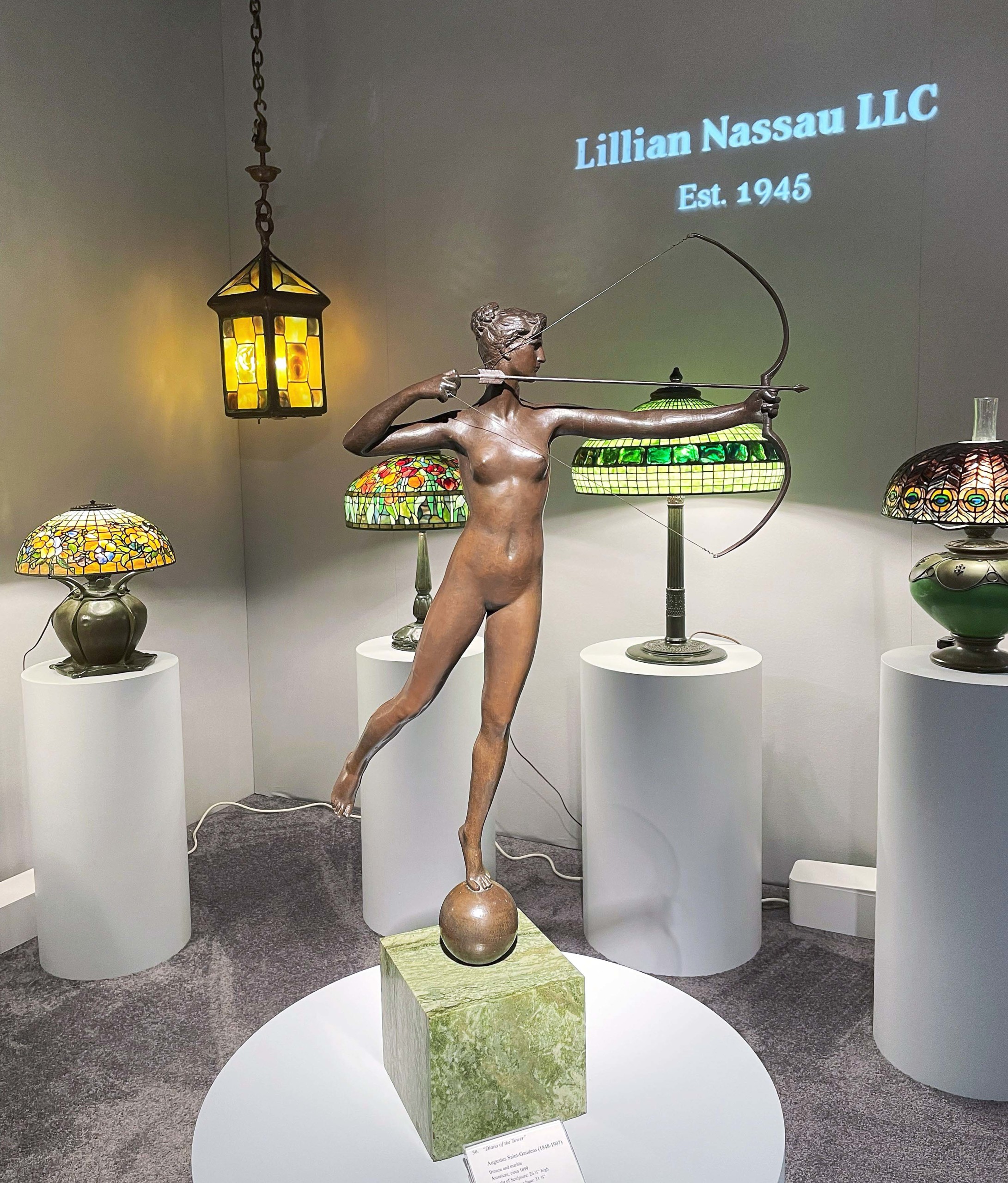
“Diana of the Tower” by Augustus Saint-Gaudens, 1899, and an array of Tiffany lighting at Lillian Nassau LLC, New York City.
Garden sculpture authority Barbara Israel arrayed Classical figures against a Mediterranean panorama, focusing attention on a life-size carved granite figure of Industry, circa 1880; the cast iron figure of Diana de Gabii; and the burbling, bronze “Joy” fountain designed by Edith Parsons and cast by Roman Bronze Works in New York around 1930. Sales of note included a pair of ceramic planters made for the Lila Acheson Wallace Garden at Colonial Williamsburg by Claude and Francois-Xavier Lalanne. Israel subsequently sold more planters, plus figures of animals, birds, the “Joy” fountain and a bronze figural group of a child with rabbits by Brenda Putnam, signed and dated 1924 and bearing the foundry mark for Kunst of New York.
Silver and jewels remained resilient. Kentshire co-president Matthew Imberman noted his company’s sale of adornments by, among others, Boucheron, Hermès, René Boivin and Cartier to new and returning customers.
At A La Vieille Russie, visitors flocked to preparatory sketches made by glass and jewelry designer René Lalique between 1894 and 1910. The embellished drawings are from a cache on view at ALVR’s New York City premises through March 29.
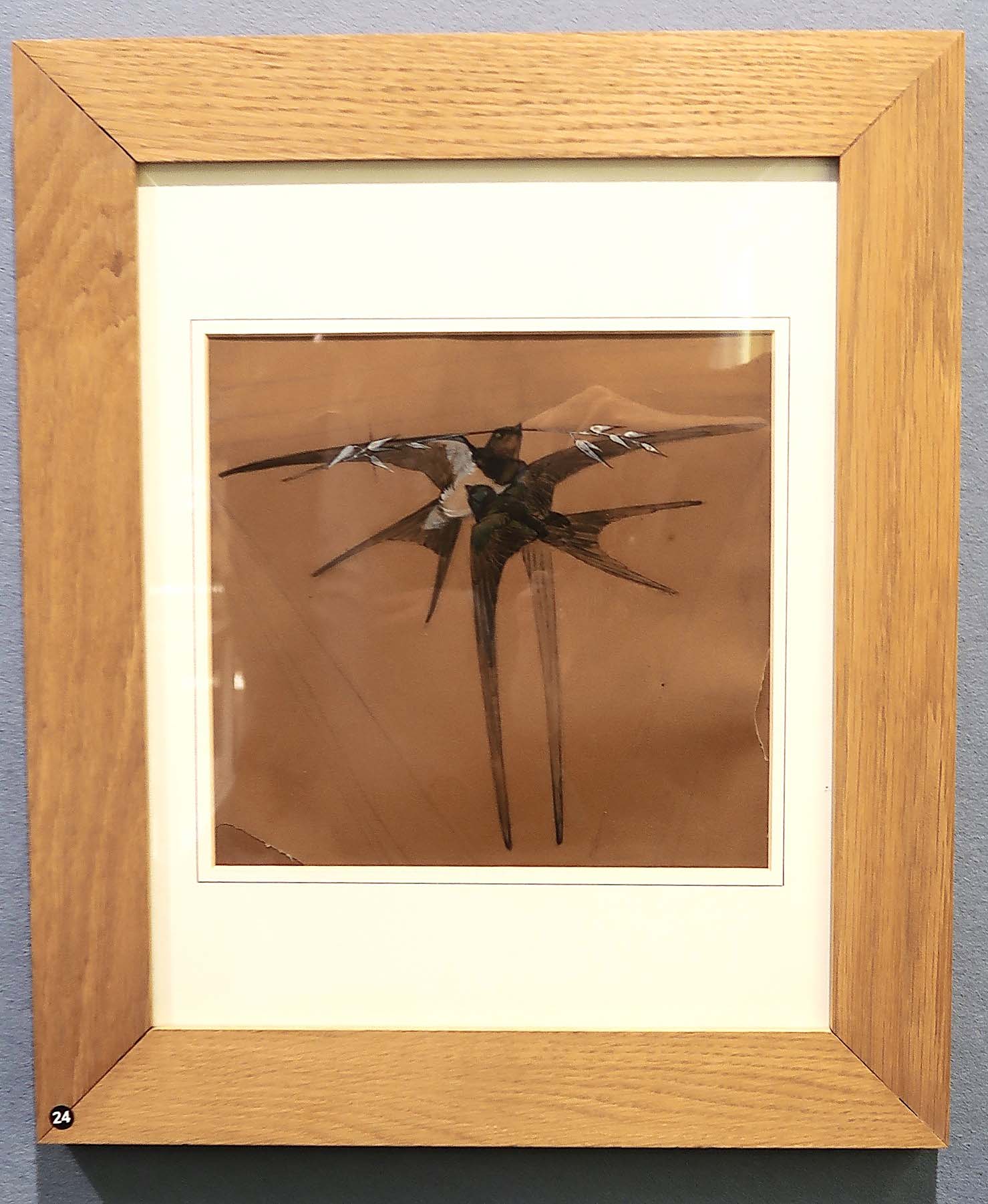
Drawing for a hair comb by René Lalique, circa 1895-1906. Through March 29, A La Vieille Russie is exhibiting 38 Lalique drawings, the largest collection outside France, and related jewels.
The Winter Show is a grand production with exquisite touches that too often go unremarked. Grace notes this year included a decorative carpet at the fair’s entrance custom-made for the show by JD Staron, and arrestingly original arrangements of fruits and flowers by Tin Can Studios of Brooklyn, N.Y.
“We have so much to be pleased with,” Allen said before the fair’s close on Sunday. “The dealers’ booths have never looked stronger. We’ve developed great partnerships, not only with our longtime sponsors but with cultural organizations. I love putting together the best panels that are pertinent to the moment. Looking back, it all really coalesced around craftsmanship and the passion for collecting.”
The 2025 Winter Show is scheduled for January 23-February 2. For more information, www.thewintershow.org.

